- Privacy Policy
Buy Me a Coffee

Home » Grounded Theory – Methods, Examples and Guide

Grounded Theory – Methods, Examples and Guide
Table of Contents

Grounded Theory
Definition:
Grounded Theory is a qualitative research methodology that aims to generate theories based on data that are grounded in the empirical reality of the research context. The method involves a systematic process of data collection, coding, categorization, and analysis to identify patterns and relationships in the data.
The ultimate goal is to develop a theory that explains the phenomenon being studied, which is based on the data collected and analyzed rather than on preconceived notions or hypotheses. The resulting theory should be able to explain the phenomenon in a way that is consistent with the data and also accounts for variations and discrepancies in the data. Grounded Theory is widely used in sociology, psychology, management, and other social sciences to study a wide range of phenomena, such as organizational behavior, social interaction, and health care.
History of Grounded Theory
Grounded Theory was first introduced by sociologists Barney Glaser and Anselm Strauss in the 1960s as a response to the limitations of traditional positivist approaches to social research. The approach was initially developed to study dying patients and their families in hospitals, but it was soon applied to other areas of sociology and beyond.
Glaser and Strauss published their seminal book “The Discovery of Grounded Theory” in 1967, in which they presented their approach to developing theory from empirical data. They argued that existing social theories often did not account for the complexity and diversity of social phenomena, and that the development of theory should be grounded in empirical data.
Since then, Grounded Theory has become a widely used methodology in the social sciences, and has been applied to a wide range of topics, including healthcare, education, business, and psychology. The approach has also evolved over time, with variations such as constructivist grounded theory and feminist grounded theory being developed to address specific criticisms and limitations of the original approach.
Types of Grounded Theory
There are two main types of Grounded Theory: Classic Grounded Theory and Constructivist Grounded Theory.
Classic Grounded Theory
This approach is based on the work of Glaser and Strauss, and emphasizes the discovery of a theory that is grounded in data. The focus is on generating a theory that explains the phenomenon being studied, without being influenced by preconceived notions or existing theories. The process involves a continuous cycle of data collection, coding, and analysis, with the aim of developing categories and subcategories that are grounded in the data. The categories and subcategories are then compared and synthesized to generate a theory that explains the phenomenon.
Constructivist Grounded Theory
This approach is based on the work of Charmaz, and emphasizes the role of the researcher in the process of theory development. The focus is on understanding how individuals construct meaning and interpret their experiences, rather than on discovering an objective truth. The process involves a reflexive and iterative approach to data collection, coding, and analysis, with the aim of developing categories that are grounded in the data and the researcher’s interpretations of the data. The categories are then compared and synthesized to generate a theory that accounts for the multiple perspectives and interpretations of the phenomenon being studied.
Grounded Theory Conducting Guide
Here are some general guidelines for conducting a Grounded Theory study:
- Choose a research question: Start by selecting a research question that is open-ended and focuses on a specific social phenomenon or problem.
- Select participants and collect data: Identify a diverse group of participants who have experienced the phenomenon being studied. Use a variety of data collection methods such as interviews, observations, and document analysis to collect rich and diverse data.
- Analyze the data: Begin the process of analyzing the data using constant comparison. This involves comparing the data to each other and to existing categories and codes, in order to identify patterns and relationships. Use open coding to identify concepts and categories, and then use axial coding to organize them into a theoretical framework.
- Generate categories and codes: Generate categories and codes that describe the phenomenon being studied. Make sure that they are grounded in the data and that they accurately reflect the experiences of the participants.
- Refine and develop the theory: Use theoretical sampling to identify new data sources that are relevant to the developing theory. Use memoing to reflect on insights and ideas that emerge during the analysis process. Continue to refine and develop the theory until it provides a comprehensive explanation of the phenomenon.
- Validate the theory: Finally, seek to validate the theory by testing it against new data and seeking feedback from peers and other researchers. This process helps to refine and improve the theory, and to ensure that it is grounded in the data.
- Write up and disseminate the findings: Once the theory is fully developed and validated, write up the findings and disseminate them through academic publications and presentations. Make sure to acknowledge the contributions of the participants and to provide a detailed account of the research methods used.
Data Collection Methods
Grounded Theory Data Collection Methods are as follows:
- Interviews : One of the most common data collection methods in Grounded Theory is the use of in-depth interviews. Interviews allow researchers to gather rich and detailed data about the experiences, perspectives, and attitudes of participants. Interviews can be conducted one-on-one or in a group setting.
- Observation : Observation is another data collection method used in Grounded Theory. Researchers may observe participants in their natural settings, such as in a workplace or community setting. This method can provide insights into the social interactions and behaviors of participants.
- Document analysis: Grounded Theory researchers also use document analysis as a data collection method. This involves analyzing existing documents such as reports, policies, or historical records that are relevant to the phenomenon being studied.
- Focus groups : Focus groups involve bringing together a group of participants to discuss a specific topic or issue. This method can provide insights into group dynamics and social interactions.
- Fieldwork : Fieldwork involves immersing oneself in the research setting and participating in the activities of the participants. This method can provide an in-depth understanding of the culture and social dynamics of the research setting.
- Multimedia data: Grounded Theory researchers may also use multimedia data such as photographs, videos, or audio recordings to capture the experiences and perspectives of participants.
Data Analysis Methods
Grounded Theory Data Analysis Methods are as follows:
- Open coding: Open coding is the process of identifying concepts and categories in the data. Researchers use open coding to assign codes to different pieces of data, and to identify similarities and differences between them.
- Axial coding: Axial coding is the process of organizing the codes into broader categories and subcategories. Researchers use axial coding to develop a theoretical framework that explains the phenomenon being studied.
- Constant comparison: Grounded Theory involves a process of constant comparison, in which data is compared to each other and to existing categories and codes in order to identify patterns and relationships.
- Theoretical sampling: Theoretical sampling involves selecting new data sources based on the emerging theory. Researchers use theoretical sampling to collect data that will help refine and validate the theory.
- Memoing : Memoing involves writing down reflections, insights, and ideas as the analysis progresses. This helps researchers to organize their thoughts and develop a deeper understanding of the data.
- Peer debriefing: Peer debriefing involves seeking feedback from peers and other researchers on the developing theory. This process helps to validate the theory and ensure that it is grounded in the data.
- Member checking: Member checking involves sharing the emerging theory with the participants in the study and seeking their feedback. This process helps to ensure that the theory accurately reflects the experiences and perspectives of the participants.
- Triangulation: Triangulation involves using multiple sources of data to validate the emerging theory. Researchers may use different data collection methods, different data sources, or different analysts to ensure that the theory is grounded in the data.
Applications of Grounded Theory
Here are some of the key applications of Grounded Theory:
- Social sciences : Grounded Theory is widely used in social science research, particularly in fields such as sociology, psychology, and anthropology. It can be used to explore a wide range of social phenomena, such as social interactions, power dynamics, and cultural practices.
- Healthcare : Grounded Theory can be used in healthcare research to explore patient experiences, healthcare practices, and healthcare systems. It can provide insights into the factors that influence healthcare outcomes, and can inform the development of interventions and policies.
- Education : Grounded Theory can be used in education research to explore teaching and learning processes, student experiences, and educational policies. It can provide insights into the factors that influence educational outcomes, and can inform the development of educational interventions and policies.
- Business : Grounded Theory can be used in business research to explore organizational processes, management practices, and consumer behavior. It can provide insights into the factors that influence business outcomes, and can inform the development of business strategies and policies.
- Technology : Grounded Theory can be used in technology research to explore user experiences, technology adoption, and technology design. It can provide insights into the factors that influence technology outcomes, and can inform the development of technology interventions and policies.
Examples of Grounded Theory
Examples of Grounded Theory in different case studies are as follows:
- Glaser and Strauss (1965): This study, which is considered one of the foundational works of Grounded Theory, explored the experiences of dying patients in a hospital. The researchers used Grounded Theory to develop a theoretical framework that explained the social processes of dying, and that was grounded in the data.
- Charmaz (1983): This study explored the experiences of chronic illness among young adults. The researcher used Grounded Theory to develop a theoretical framework that explained how individuals with chronic illness managed their illness, and how their illness impacted their sense of self.
- Strauss and Corbin (1990): This study explored the experiences of individuals with chronic pain. The researchers used Grounded Theory to develop a theoretical framework that explained the different strategies that individuals used to manage their pain, and that was grounded in the data.
- Glaser and Strauss (1967): This study explored the experiences of individuals who were undergoing a process of becoming disabled. The researchers used Grounded Theory to develop a theoretical framework that explained the social processes of becoming disabled, and that was grounded in the data.
- Clarke (2005): This study explored the experiences of patients with cancer who were receiving chemotherapy. The researcher used Grounded Theory to develop a theoretical framework that explained the factors that influenced patient adherence to chemotherapy, and that was grounded in the data.
Grounded Theory Research Example
A Grounded Theory Research Example Would be:
Research question : What is the experience of first-generation college students in navigating the college admission process?
Data collection : The researcher conducted interviews with first-generation college students who had recently gone through the college admission process. The interviews were audio-recorded and transcribed verbatim.
Data analysis: The researcher used a constant comparative method to analyze the data. This involved coding the data, comparing codes, and constantly revising the codes to identify common themes and patterns. The researcher also used memoing, which involved writing notes and reflections on the data and analysis.
Findings : Through the analysis of the data, the researcher identified several themes related to the experience of first-generation college students in navigating the college admission process, such as feeling overwhelmed by the complexity of the process, lacking knowledge about the process, and facing financial barriers.
Theory development: Based on the findings, the researcher developed a theory about the experience of first-generation college students in navigating the college admission process. The theory suggested that first-generation college students faced unique challenges in the college admission process due to their lack of knowledge and resources, and that these challenges could be addressed through targeted support programs and resources.
In summary, grounded theory research involves collecting data, analyzing it through constant comparison and memoing, and developing a theory grounded in the data. The resulting theory can help to explain the phenomenon being studied and guide future research and interventions.
Purpose of Grounded Theory
The purpose of Grounded Theory is to develop a theoretical framework that explains a social phenomenon, process, or interaction. This theoretical framework is developed through a rigorous process of data collection, coding, and analysis, and is grounded in the data.
Grounded Theory aims to uncover the social processes and patterns that underlie social phenomena, and to develop a theoretical framework that explains these processes and patterns. It is a flexible method that can be used to explore a wide range of research questions and settings, and is particularly well-suited to exploring complex social phenomena that have not been well-studied.
The ultimate goal of Grounded Theory is to generate a theoretical framework that is grounded in the data, and that can be used to explain and predict social phenomena. This theoretical framework can then be used to inform policy and practice, and to guide future research in the field.
When to use Grounded Theory
Following are some situations in which Grounded Theory may be particularly useful:
- Exploring new areas of research: Grounded Theory is particularly useful when exploring new areas of research that have not been well-studied. By collecting and analyzing data, researchers can develop a theoretical framework that explains the social processes and patterns underlying the phenomenon of interest.
- Studying complex social phenomena: Grounded Theory is well-suited to exploring complex social phenomena that involve multiple social processes and interactions. By using an iterative process of data collection and analysis, researchers can develop a theoretical framework that explains the complexity of the social phenomenon.
- Generating hypotheses: Grounded Theory can be used to generate hypotheses about social processes and interactions that can be tested in future research. By developing a theoretical framework that explains a social phenomenon, researchers can identify areas for further research and hypothesis testing.
- Informing policy and practice : Grounded Theory can provide insights into the factors that influence social phenomena, and can inform policy and practice in a variety of fields. By developing a theoretical framework that explains a social phenomenon, researchers can identify areas for intervention and policy development.
Characteristics of Grounded Theory
Grounded Theory is a qualitative research method that is characterized by several key features, including:
- Emergence : Grounded Theory emphasizes the emergence of theoretical categories and concepts from the data, rather than preconceived theoretical ideas. This means that the researcher does not start with a preconceived theory or hypothesis, but instead allows the theory to emerge from the data.
- Iteration : Grounded Theory is an iterative process that involves constant comparison of data and analysis, with each round of data collection and analysis refining the theoretical framework.
- Inductive : Grounded Theory is an inductive method of analysis, which means that it derives meaning from the data. The researcher starts with the raw data and systematically codes and categorizes it to identify patterns and themes, and to develop a theoretical framework that explains these patterns.
- Reflexive : Grounded Theory requires the researcher to be reflexive and self-aware throughout the research process. The researcher’s personal biases and assumptions must be acknowledged and addressed in the analysis process.
- Holistic : Grounded Theory takes a holistic approach to data analysis, looking at the entire data set rather than focusing on individual data points. This allows the researcher to identify patterns and themes that may not be apparent when looking at individual data points.
- Contextual : Grounded Theory emphasizes the importance of understanding the context in which social phenomena occur. This means that the researcher must consider the social, cultural, and historical factors that may influence the phenomenon of interest.
Advantages of Grounded Theory
Advantages of Grounded Theory are as follows:
- Flexibility : Grounded Theory is a flexible method that can be used to explore a wide range of research questions and settings. It is particularly well-suited to exploring complex social phenomena that have not been well-studied.
- Validity : Grounded Theory aims to develop a theoretical framework that is grounded in the data, which enhances the validity and reliability of the research findings. The iterative process of data collection and analysis also helps to ensure that the research findings are reliable and robust.
- Originality : Grounded Theory can generate new and original insights into social phenomena, as it is not constrained by preconceived theoretical ideas or hypotheses. This allows researchers to explore new areas of research and generate new theoretical frameworks.
- Real-world relevance: Grounded Theory can inform policy and practice, as it provides insights into the factors that influence social phenomena. The theoretical frameworks developed through Grounded Theory can be used to inform policy development and intervention strategies.
- Ethical : Grounded Theory is an ethical research method, as it allows participants to have a voice in the research process. Participants’ perspectives are central to the data collection and analysis process, which ensures that their views are taken into account.
- Replication : Grounded Theory is a replicable method of research, as the theoretical frameworks developed through Grounded Theory can be tested and validated in future research.
Limitations of Grounded Theory
Limitations of Grounded Theory are as follows:
- Time-consuming: Grounded Theory can be a time-consuming method, as the iterative process of data collection and analysis requires significant time and effort. This can make it difficult to conduct research in a timely and cost-effective manner.
- Subjectivity : Grounded Theory is a subjective method, as the researcher’s personal biases and assumptions can influence the data analysis process. This can lead to potential issues with reliability and validity of the research findings.
- Generalizability : Grounded Theory is a context-specific method, which means that the theoretical frameworks developed through Grounded Theory may not be generalizable to other contexts or populations. This can limit the applicability of the research findings.
- Lack of structure : Grounded Theory is an exploratory method, which means that it lacks the structure of other research methods, such as surveys or experiments. This can make it difficult to compare findings across different studies.
- Data overload: Grounded Theory can generate a large amount of data, which can be overwhelming for researchers. This can make it difficult to manage and analyze the data effectively.
- Difficulty in publication: Grounded Theory can be challenging to publish in some academic journals, as some reviewers and editors may view it as less rigorous than other research methods.
About the author
Muhammad Hassan
Researcher, Academic Writer, Web developer
You may also like

Cluster Analysis – Types, Methods and Examples

Discriminant Analysis – Methods, Types and...

MANOVA (Multivariate Analysis of Variance) –...

Documentary Analysis – Methods, Applications and...

ANOVA (Analysis of variance) – Formulas, Types...

Graphical Methods – Types, Examples and Guide
An official website of the United States government
The .gov means it’s official. Federal government websites often end in .gov or .mil. Before sharing sensitive information, make sure you’re on a federal government site.
The site is secure. The https:// ensures that you are connecting to the official website and that any information you provide is encrypted and transmitted securely.
- Publications
- Account settings
Preview improvements coming to the PMC website in October 2024. Learn More or Try it out now .
- Advanced Search
- Journal List
- SAGE Open Med
Grounded theory research: A design framework for novice researchers
Ylona chun tie.
1 Nursing and Midwifery, College of Healthcare Sciences, James Cook University, Townsville, QLD, Australia
Melanie Birks
Karen francis.
2 College of Health and Medicine, University of Tasmania, Australia, Hobart, TAS, Australia
Background:
Grounded theory is a well-known methodology employed in many research studies. Qualitative and quantitative data generation techniques can be used in a grounded theory study. Grounded theory sets out to discover or construct theory from data, systematically obtained and analysed using comparative analysis. While grounded theory is inherently flexible, it is a complex methodology. Thus, novice researchers strive to understand the discourse and the practical application of grounded theory concepts and processes.
The aim of this article is to provide a contemporary research framework suitable to inform a grounded theory study.
This article provides an overview of grounded theory illustrated through a graphic representation of the processes and methods employed in conducting research using this methodology. The framework is presented as a diagrammatic representation of a research design and acts as a visual guide for the novice grounded theory researcher.
Discussion:
As grounded theory is not a linear process, the framework illustrates the interplay between the essential grounded theory methods and iterative and comparative actions involved. Each of the essential methods and processes that underpin grounded theory are defined in this article.
Conclusion:
Rather than an engagement in philosophical discussion or a debate of the different genres that can be used in grounded theory, this article illustrates how a framework for a research study design can be used to guide and inform the novice nurse researcher undertaking a study using grounded theory. Research findings and recommendations can contribute to policy or knowledge development, service provision and can reform thinking to initiate change in the substantive area of inquiry.
Introduction
The aim of all research is to advance, refine and expand a body of knowledge, establish facts and/or reach new conclusions using systematic inquiry and disciplined methods. 1 The research design is the plan or strategy researchers use to answer the research question, which is underpinned by philosophy, methodology and methods. 2 Birks 3 defines philosophy as ‘a view of the world encompassing the questions and mechanisms for finding answers that inform that view’ (p. 18). Researchers reflect their philosophical beliefs and interpretations of the world prior to commencing research. Methodology is the research design that shapes the selection of, and use of, particular data generation and analysis methods to answer the research question. 4 While a distinction between positivist research and interpretivist research occurs at the paradigm level, each methodology has explicit criteria for the collection, analysis and interpretation of data. 2 Grounded theory (GT) is a structured, yet flexible methodology. This methodology is appropriate when little is known about a phenomenon; the aim being to produce or construct an explanatory theory that uncovers a process inherent to the substantive area of inquiry. 5 – 7 One of the defining characteristics of GT is that it aims to generate theory that is grounded in the data. The following section provides an overview of GT – the history, main genres and essential methods and processes employed in the conduct of a GT study. This summary provides a foundation for a framework to demonstrate the interplay between the methods and processes inherent in a GT study as presented in the sections that follow.
Glaser and Strauss are recognised as the founders of grounded theory. Strauss was conversant in symbolic interactionism and Glaser in descriptive statistics. 8 – 10 Glaser and Strauss originally worked together in a study examining the experience of terminally ill patients who had differing knowledge of their health status. Some of these suspected they were dying and tried to confirm or disconfirm their suspicions. Others tried to understand by interpreting treatment by care providers and family members. Glaser and Strauss examined how the patients dealt with the knowledge they were dying and the reactions of healthcare staff caring for these patients. Throughout this collaboration, Glaser and Strauss questioned the appropriateness of using a scientific method of verification for this study. During this investigation, they developed the constant comparative method, a key element of grounded theory, while generating a theory of dying first described in Awareness of Dying (1965). The constant comparative method is deemed an original way of organising and analysing qualitative data.
Glaser and Strauss subsequently went on to write The Discovery of Grounded Theory: Strategies for Qualitative Research (1967). This seminal work explained how theory could be generated from data inductively. This process challenged the traditional method of testing or refining theory through deductive testing. Grounded theory provided an outlook that questioned the view of the time that quantitative methodology is the only valid, unbiased way to determine truths about the world. 11 Glaser and Strauss 5 challenged the belief that qualitative research lacked rigour and detailed the method of comparative analysis that enables the generation of theory. After publishing The Discovery of Grounded Theory , Strauss and Glaser went on to write independently, expressing divergent viewpoints in the application of grounded theory methods.
Glaser produced his book Theoretical Sensitivity (1978) and Strauss went on to publish Qualitative Analysis for Social Scientists (1987). Strauss and Corbin’s 12 publication Basics of Qualitative Research: Grounded Theory Procedures and Techniques resulted in a rebuttal by Glaser 13 over their application of grounded theory methods. However, philosophical perspectives have changed since Glaser’s positivist version and Strauss and Corbin’s post-positivism stance. 14 Grounded theory has since seen the emergence of additional philosophical perspectives that have influenced a change in methodological development over time. 15
Subsequent generations of grounded theorists have positioned themselves along a philosophical continuum, from Strauss and Corbin’s 12 theoretical perspective of symbolic interactionism, through to Charmaz’s 16 constructivist perspective. However, understanding how to position oneself philosophically can challenge novice researchers. Birks and Mills 6 provide a contemporary understanding of GT in their book Grounded theory: A Practical Guide. These Australian researchers have written in a way that appeals to the novice researcher. It is the contemporary writing, the way Birks and Mills present a non-partisan approach to GT that support the novice researcher to understand the philosophical and methodological concepts integral in conducting research. The development of GT is important to understand prior to selecting an approach that aligns with the researcher’s philosophical position and the purpose of the research study. As the research progresses, seminal texts are referred back to time and again as understanding of concepts increases, much like the iterative processes inherent in the conduct of a GT study.
Genres: traditional, evolved and constructivist grounded theory
Grounded theory has several distinct methodological genres: traditional GT associated with Glaser; evolved GT associated with Strauss, Corbin and Clarke; and constructivist GT associated with Charmaz. 6 , 17 Each variant is an extension and development of the original GT by Glaser and Strauss. The first of these genres is known as traditional or classic GT. Glaser 18 acknowledged that the goal of traditional GT is to generate a conceptual theory that accounts for a pattern of behaviour that is relevant and problematic for those involved. The second genre, evolved GT, is founded on symbolic interactionism and stems from work associated with Strauss, Corbin and Clarke. Symbolic interactionism is a sociological perspective that relies on the symbolic meaning people ascribe to the processes of social interaction. Symbolic interactionism addresses the subjective meaning people place on objects, behaviours or events based on what they believe is true. 19 , 20 Constructivist GT, the third genre developed and explicated by Charmaz, a symbolic interactionist, has its roots in constructivism. 8 , 16 Constructivist GT’s methodological underpinnings focus on how participants’ construct meaning in relation to the area of inquiry. 16 A constructivist co-constructs experience and meanings with participants. 21 While there are commonalities across all genres of GT, there are factors that distinguish differences between the approaches including the philosophical position of the researcher; the use of literature; and the approach to coding, analysis and theory development. Following on from Glaser and Strauss, several versions of GT have ensued.
Grounded theory represents both a method of inquiry and a resultant product of that inquiry. 7 , 22 Glaser and Holton 23 define GT as ‘a set of integrated conceptual hypotheses systematically generated to produce an inductive theory about a substantive area’ (p. 43). Strauss and Corbin 24 define GT as ‘theory that was derived from data, systematically gathered and analysed through the research process’ (p. 12). The researcher ‘begins with an area of study and allows the theory to emerge from the data’ (p. 12). Charmaz 16 defines GT as ‘a method of conducting qualitative research that focuses on creating conceptual frameworks or theories through building inductive analysis from the data’ (p. 187). However, Birks and Mills 6 refer to GT as a process by which theory is generated from the analysis of data. Theory is not discovered; rather, theory is constructed by the researcher who views the world through their own particular lens.
Research process
Before commencing any research study, the researcher must have a solid understanding of the research process. A well-developed outline of the study and an understanding of the important considerations in designing and undertaking a GT study are essential if the goals of the research are to be achieved. While it is important to have an understanding of how a methodology has developed, in order to move forward with research, a novice can align with a grounded theorist and follow an approach to GT. Using a framework to inform a research design can be a useful modus operandi.
The following section provides insight into the process of undertaking a GT research study. Figure 1 is a framework that summarises the interplay and movement between methods and processes that underpin the generation of a GT. As can be seen from this framework, and as detailed in the discussion that follows, the process of doing a GT research study is not linear, rather it is iterative and recursive.

Research design framework: summary of the interplay between the essential grounded theory methods and processes.
Grounded theory research involves the meticulous application of specific methods and processes. Methods are ‘systematic modes, procedures or tools used for collection and analysis of data’. 25 While GT studies can commence with a variety of sampling techniques, many commence with purposive sampling, followed by concurrent data generation and/or collection and data analysis, through various stages of coding, undertaken in conjunction with constant comparative analysis, theoretical sampling and memoing. Theoretical sampling is employed until theoretical saturation is reached. These methods and processes create an unfolding, iterative system of actions and interactions inherent in GT. 6 , 16 The methods interconnect and inform the recurrent elements in the research process as shown by the directional flow of the arrows and the encompassing brackets in Figure 1 . The framework denotes the process is both iterative and dynamic and is not one directional. Grounded theory methods are discussed in the following section.
Purposive sampling
As presented in Figure 1 , initial purposive sampling directs the collection and/or generation of data. Researchers purposively select participants and/or data sources that can answer the research question. 5 , 7 , 16 , 21 Concurrent data generation and/or data collection and analysis is fundamental to GT research design. 6 The researcher collects, codes and analyses this initial data before further data collection/generation is undertaken. Purposeful sampling provides the initial data that the researcher analyses. As will be discussed, theoretical sampling then commences from the codes and categories developed from the first data set. Theoretical sampling is used to identify and follow clues from the analysis, fill gaps, clarify uncertainties, check hunches and test interpretations as the study progresses.
Constant comparative analysis
Constant comparative analysis is an analytical process used in GT for coding and category development. This process commences with the first data generated or collected and pervades the research process as presented in Figure 1 . Incidents are identified in the data and coded. 6 The initial stage of analysis compares incident to incident in each code. Initial codes are then compared to other codes. Codes are then collapsed into categories. This process means the researcher will compare incidents in a category with previous incidents, in both the same and different categories. 5 Future codes are compared and categories are compared with other categories. New data is then compared with data obtained earlier during the analysis phases. This iterative process involves inductive and deductive thinking. 16 Inductive, deductive and abductive reasoning can also be used in data analysis. 26
Constant comparative analysis generates increasingly more abstract concepts and theories through inductive processes. 16 In addition, abduction, defined as ‘a form of reasoning that begins with an examination of the data and the formation of a number of hypotheses that are then proved or disproved during the process of analysis … aids inductive conceptualization’. 6 Theoretical sampling coupled with constant comparative analysis raises the conceptual levels of data analysis and directs ongoing data collection or generation. 6
The constant comparative technique is used to find consistencies and differences, with the aim of continually refining concepts and theoretically relevant categories. This continual comparative iterative process that encompasses GT research sets it apart from a purely descriptive analysis. 8
Memo writing is an analytic process considered essential ‘in ensuring quality in grounded theory’. 6 Stern 27 offers the analogy that if data are the building blocks of the developing theory, then memos are the ‘mortar’ (p. 119). Memos are the storehouse of ideas generated and documented through interacting with data. 28 Thus, memos are reflective interpretive pieces that build a historic audit trail to document ideas, events and the thought processes inherent in the research process and developing thinking of the analyst. 6 Memos provide detailed records of the researchers’ thoughts, feelings and intuitive contemplations. 6
Lempert 29 considers memo writing crucial as memos prompt researchers to analyse and code data and develop codes into categories early in the coding process. Memos detail why and how decisions made related to sampling, coding, collapsing of codes, making of new codes, separating codes, producing a category and identifying relationships abstracted to a higher level of analysis. 6 Thus, memos are informal analytic notes about the data and the theoretical connections between categories. 23 Memoing is an ongoing activity that builds intellectual assets, fosters analytic momentum and informs the GT findings. 6 , 10
Generating/collecting data
A hallmark of GT is concurrent data generation/collection and analysis. In GT, researchers may utilise both qualitative and quantitative data as espoused by Glaser’s dictum; ‘all is data’. 30 While interviews are a common method of generating data, data sources can include focus groups, questionnaires, surveys, transcripts, letters, government reports, documents, grey literature, music, artefacts, videos, blogs and memos. 9 Elicited data are produced by participants in response to, or directed by, the researcher whereas extant data includes data that is already available such as documents and published literature. 6 , 31 While this is one interpretation of how elicited data are generated, other approaches to grounded theory recognise the agency of participants in the co-construction of data with the researcher. The relationship the researcher has with the data, how it is generated and collected, will determine the value it contributes to the development of the final GT. 6 The significance of this relationship extends into data analysis conducted by the researcher through the various stages of coding.
Coding is an analytical process used to identify concepts, similarities and conceptual reoccurrences in data. Coding is the pivotal link between collecting or generating data and developing a theory that explains the data. Charmaz 10 posits,
codes rely on interaction between researchers and their data. Codes consist of short labels that we construct as we interact with the data. Something kinaesthetic occurs when we are coding; we are mentally and physically active in the process. (p. 5)
In GT, coding can be categorised into iterative phases. Traditional, evolved and constructivist GT genres use different terminology to explain each coding phase ( Table 1 ).
Comparison of coding terminology in traditional, evolved and constructivist grounded theory.
Adapted from Birks and Mills. 6
Coding terminology in evolved GT refers to open (a procedure for developing categories of information), axial (an advanced procedure for interconnecting the categories) and selective coding (procedure for building a storyline from core codes that connects the categories), producing a discursive set of theoretical propositions. 6 , 12 , 32 Constructivist grounded theorists refer to initial, focused and theoretical coding. 9 Birks and Mills 6 use the terms initial, intermediate and advanced coding that link to low, medium and high-level conceptual analysis and development. The coding terms devised by Birks and Mills 6 were used for Figure 1 ; however, these can be altered to reflect the coding terminology used in the respective GT genres selected by the researcher.
Initial coding
Initial coding of data is the preliminary step in GT data analysis. 6 , 9 The purpose of initial coding is to start the process of fracturing the data to compare incident to incident and to look for similarities and differences in beginning patterns in the data. In initial coding, the researcher inductively generates as many codes as possible from early data. 16 Important words or groups of words are identified and labelled. In GT, codes identify social and psychological processes and actions as opposed to themes. Charmaz 16 emphasises keeping codes as similar to the data as possible and advocates embedding actions in the codes in an iterative coding process. Saldaña 33 agrees that codes that denote action, which he calls process codes, can be used interchangeably with gerunds (verbs ending in ing ). In vivo codes are often verbatim quotes from the participants’ words and are often used as the labels to capture the participant’s words as representative of a broader concept or process in the data. 6 Table 1 reflects variation in the terminology of codes used by grounded theorists.
Initial coding categorises and assigns meaning to the data, comparing incident-to-incident, labelling beginning patterns and beginning to look for comparisons between the codes. During initial coding, it is important to ask ‘what is this data a study of’. 18 What does the data assume, ‘suggest’ or ‘pronounce’ and ‘from whose point of view’ does this data come, whom does it represent or whose thoughts are they?. 16 What collectively might it represent? The process of documenting reactions, emotions and related actions enables researchers to explore, challenge and intensify their sensitivity to the data. 34 Early coding assists the researcher to identify the direction for further data gathering. After initial analysis, theoretical sampling is employed to direct collection of additional data that will inform the ‘developing theory’. 9 Initial coding advances into intermediate coding once categories begin to develop.
Theoretical sampling
The purpose of theoretical sampling is to allow the researcher to follow leads in the data by sampling new participants or material that provides relevant information. As depicted in Figure 1 , theoretical sampling is central to GT design, aids the evolving theory 5 , 7 , 16 and ensures the final developed theory is grounded in the data. 9 Theoretical sampling in GT is for the development of a theoretical category, as opposed to sampling for population representation. 10 Novice researchers need to acknowledge this difference if they are to achieve congruence within the methodology. Birks and Mills 6 define theoretical sampling as ‘the process of identifying and pursuing clues that arise during analysis in a grounded theory study’ (p. 68). During this process, additional information is sought to saturate categories under development. The analysis identifies relationships, highlights gaps in the existing data set and may reveal insight into what is not yet known. The exemplars in Box 1 highlight how theoretical sampling led to the inclusion of further data.
Examples of theoretical sampling.
Thus, theoretical sampling is used to focus and generate data to feed the iterative process of continual comparative analysis of the data. 6
Intermediate coding
Intermediate coding, identifying a core category, theoretical data saturation, constant comparative analysis, theoretical sensitivity and memoing occur in the next phase of the GT process. 6 Intermediate coding builds on the initial coding phase. Where initial coding fractures the data, intermediate coding begins to transform basic data into more abstract concepts allowing the theory to emerge from the data. During this analytic stage, a process of reviewing categories and identifying which ones, if any, can be subsumed beneath other categories occurs and the properties or dimension of the developed categories are refined. Properties refer to the characteristics that are common to all the concepts in the category and dimensions are the variations of a property. 37
At this stage, a core category starts to become evident as developed categories form around a core concept; relationships are identified between categories and the analysis is refined. Birks and Mills 6 affirm that diagramming can aid analysis in the intermediate coding phase. Grounded theorists interact closely with the data during this phase, continually reassessing meaning to ascertain ‘what is really going on’ in the data. 30 Theoretical saturation ensues when new data analysis does not provide additional material to existing theoretical categories, and the categories are sufficiently explained. 6
Advanced coding
Birks and Mills 6 described advanced coding as the ‘techniques used to facilitate integration of the final grounded theory’ (p. 177). These authors promote storyline technique (described in the following section) and theoretical coding as strategies for advancing analysis and theoretical integration. Advanced coding is essential to produce a theory that is grounded in the data and has explanatory power. 6 During the advanced coding phase, concepts that reach the stage of categories will be abstract, representing stories of many, reduced into highly conceptual terms. The findings are presented as a set of interrelated concepts as opposed to presenting themes. 28 Explanatory statements detail the relationships between categories and the central core category. 28
Storyline is a tool that can be used for theoretical integration. Birks and Mills 6 define storyline as ‘a strategy for facilitating integration, construction, formulation, and presentation of research findings through the production of a coherent grounded theory’ (p. 180). Storyline technique is first proposed with limited attention in Basics of Qualitative Research by Strauss and Corbin 12 and further developed by Birks et al. 38 as a tool for theoretical integration. The storyline is the conceptualisation of the core category. 6 This procedure builds a story that connects the categories and produces a discursive set of theoretical propositions. 24 Birks and Mills 6 contend that storyline can be ‘used to produce a comprehensive rendering of your grounded theory’ (p. 118). Birks et al. 38 had earlier concluded, ‘storyline enhances the development, presentation and comprehension of the outcomes of grounded theory research’ (p. 405). Once the storyline is developed, the GT is finalised using theoretical codes that ‘provide a framework for enhancing the explanatory power of the storyline and its potential as theory’. 6 Thus, storyline is the explication of the theory.
Theoretical coding occurs as the final culminating stage towards achieving a GT. 39 , 40 The purpose of theoretical coding is to integrate the substantive theory. 41 Saldaña 40 states, ‘theoretical coding integrates and synthesises the categories derived from coding and analysis to now create a theory’ (p. 224). Initial coding fractures the data while theoretical codes ‘weave the fractured story back together again into an organized whole theory’. 18 Advanced coding that integrates extant theory adds further explanatory power to the findings. 6 The examples in Box 2 describe the use of storyline as a technique.
Writing the storyline.
Theoretical sensitivity
As presented in Figure 1 , theoretical sensitivity encompasses the entire research process. Glaser and Strauss 5 initially described the term theoretical sensitivity in The Discovery of Grounded Theory. Theoretical sensitivity is the ability to know when you identify a data segment that is important to your theory. While Strauss and Corbin 12 describe theoretical sensitivity as the insight into what is meaningful and of significance in the data for theory development, Birks and Mills 6 define theoretical sensitivity as ‘the ability to recognise and extract from the data elements that have relevance for the emerging theory’ (p. 181). Conducting GT research requires a balance between keeping an open mind and the ability to identify elements of theoretical significance during data generation and/or collection and data analysis. 6
Several analytic tools and techniques can be used to enhance theoretical sensitivity and increase the grounded theorist’s sensitivity to theoretical constructs in the data. 28 Birks and Mills 6 state, ‘as a grounded theorist becomes immersed in the data, their level of theoretical sensitivity to analytic possibilities will increase’ (p. 12). Developing sensitivity as a grounded theorist and the application of theoretical sensitivity throughout the research process allows the analytical focus to be directed towards theory development and ultimately result in an integrated and abstract GT. 6 The example in Box 3 highlights how analytic tools are employed to increase theoretical sensitivity.
Theoretical sensitivity.
The grounded theory
The meticulous application of essential GT methods refines the analysis resulting in the generation of an integrated, comprehensive GT that explains a process relating to a particular phenomenon. 6 The results of a GT study are communicated as a set of concepts, related to each other in an interrelated whole, and expressed in the production of a substantive theory. 5 , 7 , 16 A substantive theory is a theoretical interpretation or explanation of a studied phenomenon 6 , 17 Thus, the hallmark of grounded theory is the generation of theory ‘abstracted from, or grounded in, data generated and collected by the researcher’. 6 However, to ensure quality in research requires the application of rigour throughout the research process.
Quality and rigour
The quality of a grounded theory can be related to three distinct areas underpinned by (1) the researcher’s expertise, knowledge and research skills; (2) methodological congruence with the research question; and (3) procedural precision in the use of methods. 6 Methodological congruence is substantiated when the philosophical position of the researcher is congruent with the research question and the methodological approach selected. 6 Data collection or generation and analytical conceptualisation need to be rigorous throughout the research process to secure excellence in the final grounded theory. 44
Procedural precision requires careful attention to maintaining a detailed audit trail, data management strategies and demonstrable procedural logic recorded using memos. 6 Organisation and management of research data, memos and literature can be assisted using software programs such as NVivo. An audit trail of decision-making, changes in the direction of the research and the rationale for decisions made are essential to ensure rigour in the final grounded theory. 6
This article offers a framework to assist novice researchers visualise the iterative processes that underpin a GT study. The fundamental process and methods used to generate an integrated grounded theory have been described. Novice researchers can adapt the framework presented to inform and guide the design of a GT study. This framework provides a useful guide to visualise the interplay between the methods and processes inherent in conducting GT. Research conducted ethically and with meticulous attention to process will ensure quality research outcomes that have relevance at the practice level.
Declaration of conflicting interests: The author(s) declared no potential conflicts of interest with respect to the research, authorship, and/or publication of this article.
Funding: The author(s) received no financial support for the research, authorship, and/or publication of this article.

Root out friction in every digital experience, super-charge conversion rates, and optimize digital self-service
Uncover insights from any interaction, deliver AI-powered agent coaching, and reduce cost to serve
Increase revenue and loyalty with real-time insights and recommendations delivered to teams on the ground
Know how your people feel and empower managers to improve employee engagement, productivity, and retention
Take action in the moments that matter most along the employee journey and drive bottom line growth
Whatever they’re are saying, wherever they’re saying it, know exactly what’s going on with your people
Get faster, richer insights with qual and quant tools that make powerful market research available to everyone
Run concept tests, pricing studies, prototyping + more with fast, powerful studies designed by UX research experts
Track your brand performance 24/7 and act quickly to respond to opportunities and challenges in your market
Explore the platform powering Experience Management
- Free Account
- For Digital
- For Customer Care
- For Human Resources
- For Researchers
- Financial Services
- All Industries
Popular Use Cases
- Customer Experience
- Employee Experience
- Employee Exit Interviews
- Net Promoter Score
- Voice of Customer
- Customer Success Hub
- Product Documentation
- Training & Certification
- XM Institute
- Popular Resources
- Customer Stories
Market Research
- Artificial Intelligence
- Partnerships
- Marketplace
The annual gathering of the experience leaders at the world’s iconic brands building breakthrough business results, live in Salt Lake City.
- English/AU & NZ
- Español/Europa
- Español/América Latina
- Português Brasileiro
- REQUEST DEMO
- Experience Management
- Grounded Theory Research
Try Qualtrics for free
Your complete guide to grounded theory research.
11 min read If you have an area of interest, but no hypothesis yet, try grounded theory research. You conduct data collection and analysis, forming a theory based on facts. Read our ultimate guide for everything you need to know.
What is grounded theory in research?
Grounded theory is a systematic qualitative research method that collects empirical data first, and then creates a theory ‘grounded’ in the results.
The constant comparative method was developed by Glaser and Strauss, described in their book, Awareness of Dying (1965). They are seen as the founders of classic grounded theory.
Research teams use grounded theory to analyze social processes and relationships.
Because of the important role of data, there are key stages like data collection and data analysis that need to happen in order for the resulting data to be useful.
The grounded research results are compared to strengthen the validity of the findings to arrive at stronger defined theories. Once the data analysis cannot continue to refine the new theories down, a final theory is confirmed.
Grounded research is different from experimental research or scientific inquiry as it does not need a hypothesis theory at the start to verify. Instead, the evolving theory is based on facts and evidence discovered during each stage.Also, grounded research also doesn’t have a preconceived understanding of events or happenings before the qualitative research commences.
Free eBook: Qualitative research design handbook
When should you use grounded theory research?
Grounded theory research is useful for businesses when a researcher wants to look into a topic that has existing theory or no current research available. This means that the qualitative research results will be unique and can open the doors to the social phenomena being investigated.
In addition, businesses can use this qualitative research as the primary evidence needed to understand whether it’s worth placing investment into a new line of product or services, if the research identifies key themes and concepts that point to a solvable commercial problem.
Grounded theory methodology
There are several stages in the grounded theory process:
1. Data planning
The researcher decides what area they’re interested in.
They may create a guide to what they will be collecting during the grounded theory methodology. They will refer to this guide when they want to check the suitability of the qualitative data, as they collect it, to avoid preconceived ideas of what they know impacting the research.
A researcher can set up a grounded theory coding framework to identify the correct data. Coding is associating words, or labels, that are useful to the social phenomena that is being investigated. So, when the researcher sees these words, they assign the data to that category or theme.
In this stage, you’ll also want to create your open-ended initial research questions. Here are the main differences between open and closed-ended questions:
These will need to be adapted as the research goes on and more tangents and areas to explore are discovered. To help you create your questions, ask yourself:
- What are you trying to explain?
- What experiences do you need to ask about?
- Who will you ask and why?
2. Data collection and analysis
Data analysis happens at the same time as data collection. In grounded theory analysis, this is also known as constant comparative analysis, or theoretical sampling.
The researcher collects qualitative data by asking open-ended questions in interviews and surveys, studying historical or archival data, or observing participants and interpreting what is seen. This collected data is transferred into transcripts.
The categories or themes are compared and further refined by data, until there are only a few strong categories or themes remaining. Here is where coding occurs, and there are different levels of coding as the categories or themes are refined down:
- Data collection (Initial coding stage): Read through the data line by line
- Open coding stage: Read through the transcript data several times, breaking down the qualitative research data into excerpts, and make summaries of the concept or theme.
- Axial coding stage: Read through and compare further data collection to summarize concepts or themes to look for similarities and differences. Make defined summaries that help shape an emerging theory.
- Selective coding stage: Use the defined summaries to identify a strong core concept or theme.
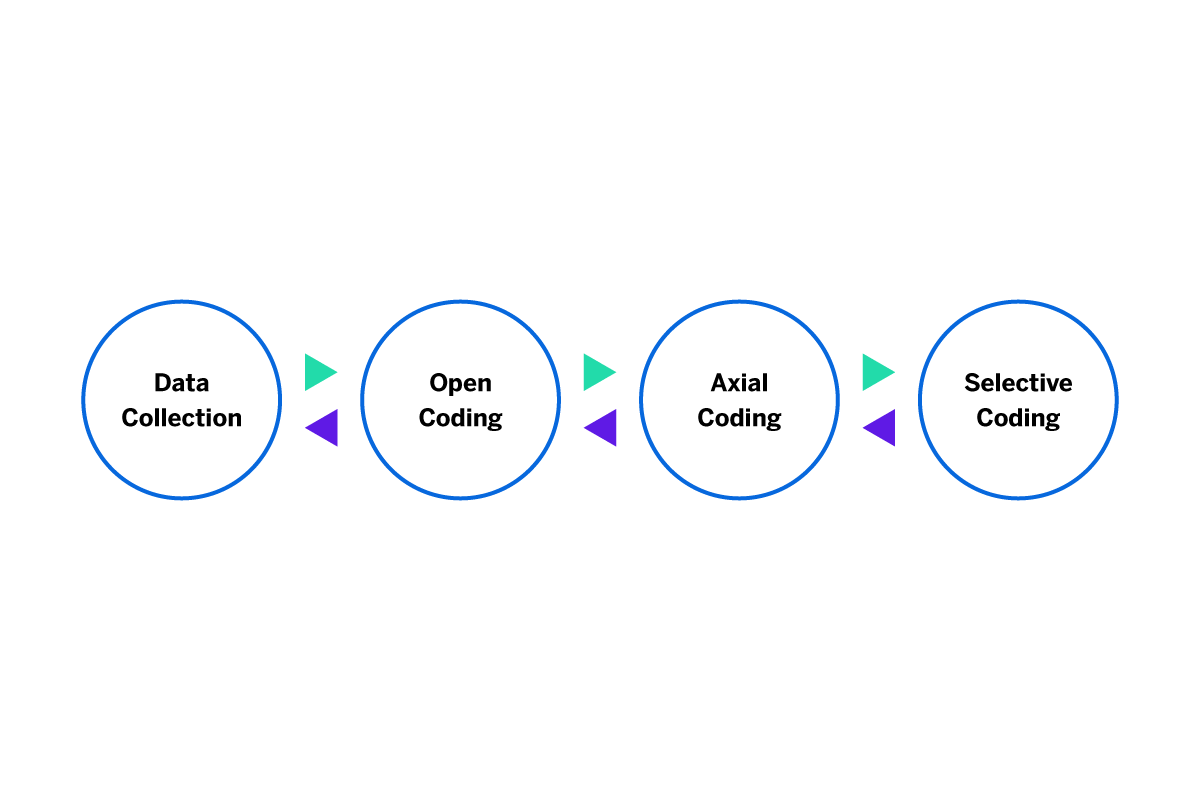
During analysis, the researcher will apply theoretical sensitivity to the collected data they uncover, so that the meaning of nuances in what they see can be fully understood.
This coding process repeats until the researcher has reached theoretical saturation. In grounded theory analysis, this is where all data has been researched and there are no more possible categories or themes to explore.
3. Data analysis is turned into a final theory
The researcher takes the core categories and themes that they have gathered and integrates them into one central idea (a new theory) using selective code. This final grounded theory concludes the research.
The new theory should be a few simple sentences that describe the research, indicating what was and was not covered in it.
An example of using grounded theory in business
One example of how grounded theory may be used in business is to support HR teams by analyzing data to explore reasons why people leave a company.
For example, a company with a high attrition rate that has not done any research on this area before may choose grounded theory to understand key reasons why people choose to leave.
Researchers may start looking at the quantitative data around departures over the year and look for patterns. Coupled with this, they may conduct qualitative data research through employee engagement surveys , interview panels for current employees, and exit interviews with leaving employees.
From this information, they may start coding transcripts to find similarities and differences (coding) picking up on general themes and concepts. For example, a group of excepts like:
- “The hours I worked were far too long and I hated traveling home in the dark”
- “My manager didn’t appreciate the work I was doing, especially when I worked late”
- There are no good night bus routes home that I could take safely”
Using open coding, a researcher could compare excerpts and suggest the themes of managerial issues, a culture of long hours and lack of traveling routes at night.
With more samples and information, through axial coding, stronger themes of lack of recognition and having too much work (which led people to working late), could be drawn out from the summaries of the concepts and themes.
This could lead to a selective coding conclusion that people left because they were ‘overworked and under-appreciated’.
With this information, a grounded theory can help HR teams look at what teams do day to day, exploring ways to spread workloads or reduce them. Also, there could be training supplied to management and employees to engage professional development conversations better.
Advantages of grounded theory
- No need for hypothesis – Researchers don’t need to know the details about the topic they want to investigate in advance, as the grounded theory methodology will bring up the information.
- Lots of flexibility – Researchers can take the topic in whichever direction they think is best, based on what the data is telling them. This means that exploration avenues that may be off-limits in traditional experimental research can be included.
- Multiple stages improve conclusion – Having a series of coding stages that refine the data into clear and strong concepts or themes means that the grounded theory will be more useful, relevant and defined.
- Data-first – Grounded theory relies on data analysis in the first instance, so the conclusion is based on information that has strong data behind it. This could be seen as having more validity.
Disadvantages of grounded theory
- Theoretical sensitivity dulled – If a researcher does not know enough about the topic being investigated, then their theoretical sensitivity about what data means may be lower and information may be missed if it is not coded properly.
- Large topics take time – There is a significant time resource required by the researcher to properly conduct research, evaluate the results and compare and analyze each excerpt. If the research process finds more avenues for investigation, for example, when excerpts contradict each other, then the researcher is required to spend more time doing qualitative inquiry.
- Bias in interpreting qualitative data – As the researcher is responsible for interpreting the qualitative data results, and putting their own observations into text, there can be researcher bias that would skew the data and possibly impact the final grounded theory.
- Qualitative research is harder to analyze than quantitative data – unlike numerical factual data from quantitative sources, qualitative data is harder to analyze as researchers will need to look at the words used, the sentiment and what is being said.
- Not repeatable – while the grounded theory can present a fact-based hypothesis, the actual data analysis from the research process cannot be repeated easily as opinions, beliefs and people may change over time. This may impact the validity of the grounded theory result.
What tools will help with grounded theory?
Evaluating qualitative research can be tough when there are several analytics platforms to manage and lots of subjective data sources to compare. Some tools are already part of the office toolset, like video conferencing tools and excel spreadsheets.
However, most tools are not purpose-built for research, so researchers will be manually collecting and managing these files – in the worst case scenario, by pen and paper!
Use a best-in-breed management technology solution to collect all qualitative research and manage it in an organized way without large time resources or additional training required.
Qualtrics provides a number of qualitative research analysis tools, like Text iQ , powered by Qualtrics iQ, provides powerful machine learning and native language processing to help you discover patterns and trends in text.
This also provides you with research process tools:
- Sentiment analysis — a technique to help identify the underlying sentiment (say positive, neutral, and/or negative) in qualitative research text responses
- Topic detection/categorisation — The solution makes it easy to add new qualitative research codes and group by theme. Easily group or bucket of similar themes that can be relevant for the business and the industry (eg. ‘Food quality’, ‘Staff efficiency’ or ‘Product availability’)
Related resources
Market intelligence 10 min read, marketing insights 11 min read, ethnographic research 11 min read, qualitative vs quantitative research 13 min read, qualitative research questions 11 min read, qualitative research design 12 min read, primary vs secondary research 14 min read, request demo.
Ready to learn more about Qualtrics?

The Ultimate Guide to Qualitative Research - Part 2: Handling Qualitative Data

- Handling qualitative data
- Transcripts
- Field notes
- Survey data and responses
- Visual and audio data
- Data organization
- Data coding
- Coding frame
- Auto and smart coding
- Organizing codes
- Qualitative data analysis
- Content analysis
- Thematic analysis
- Thematic analysis vs. content analysis
- Narrative research
- Phenomenological research
- Discourse analysis
What is grounded theory in simple terms?
Core components of grounded theory, role of the researcher in grounded theory, constructivist grounded theory, what tools will help with grounded theory.
- Deductive reasoning
- Inductive reasoning
- Inductive vs. deductive reasoning
- Qualitative data interpretation
- Qualitative analysis software
Grounded theory
Among the various approaches to qualitative data analysis , grounded theory is among those that stay very close to the data to develop a theory. Grounded theory analysis is essential, particularly in research inquiries where there is little or no existing theory, to guide the organization of knowledge from data collection .

Let's look at the topic of grounded theory methodology by exploring its rationale, its potential for theory development, the steps employed in grounded theory procedures, and how ATLAS.ti can facilitate grounded theory methods.
Barney G. Glaser and Anselm L. Strauss are credited with developing grounded theory as a widely-used research methodology in qualitative analysis in the social sciences. Over the decades, other researchers, such as Kathy Charmaz, have further developed grounded theory approaches. Glaser and Strauss broke new ground in qualitative inquiry through grounded theory by arguing against any notions that science had maximized its potential for developing new theory. As a result, the primary purpose of grounded theory is to construct theories grounded in systematically gathered and analyzed data rather than beginning with a preconceived theory. The ultimate goal is to generate a theory that offers an explanation of the research question that stems from what emerges from the data.
What is the main point of grounded theory?
At its core, grounded theory is about the discovery of new concepts and relationships. Rather than starting research with a theory and then testing it, grounded theory researchers begin with an area of study and allow what is relevant in that area to emerge. The methodology was developed as a response to the traditional approach of having a hypothesis before conducting research, which can lead to forcing the data to meet preconceived notions. The main point of grounded theory is to cultivate an understanding of social phenomena from the perspective of those experiencing them.
When should you use grounded theory research?
Grounded theory research is appropriate when there is little prior information or established theory about a phenomenon. It is most suitable for investigations of processes, actions, and interactions. Grounded theory can be particularly useful in exploratory studies where the aim is to identify key issues, explore them in detail, and construct a model or theory that can be used to understand the phenomenon from a new perspective.
You might choose to use grounded theory when you want to learn about people's experiences, their perceptions of these experiences, and the actions they take as a result. The inductive nature of grounded theory makes it suitable for studying social processes over time, understanding the changes and development of a phenomenon, and gaining in-depth insights from the perspective of those directly involved.
Benefits of using grounded theory
One of the key advantages of using grounded theory is that it promotes the emergence of new theories and deepens our understanding of the social world around us. Here are some of the key benefits:
- Flexibility: Grounded theory is adaptive and can be adjusted during the research process, providing a degree of flexibility not often seen in other research methods.
- Inductive nature: Because it is inductive , grounded theory is well suited for discovering how individuals interpret their experiences and the world around them.
- Rich, detailed insights: Grounded theory's focus on the exploration of phenomena can lead to rich, detailed insights and in-depth understanding.
- Practical outcomes: Grounded theory generates theory and provides practical implications that can inform policy, intervention, or program development.
Limitations of grounded theory
While grounded theory offers many advantages, it is essential to be aware of its limitations:
- Time-consuming: The process of data collection and analysis can be time-consuming due to the method's iterative nature.
- Complexity: The method can be complex to apply correctly due to its abstract concepts and the various stages of coding and analysis.
- Requires skill and experience: Successful implementation of grounded theory requires strong analytical skills and experience in qualitative research.
- Subjectivity: While subjectivity can be a strength in understanding the experiences of others, it can also be a limitation if biases are not properly acknowledged and managed.
Grounded theory, as a research methodology , consists of several core components that guide the research process, from data collection to the development of a final theoretical framework . These components are interrelated, each influencing and shaping the others in a dynamic, iterative process. The core components of grounded theory include theoretical sensitivity, theoretical sampling, coding and analysis , theoretical saturation, and theoretical integration.
Theoretical sensitivity
Theoretical sensitivity refers to a researcher's ability to understand and define phenomena in terms of their underlying patterns or structures. It's an acquired skill that grows with experience, through exposure to literature, professional experiences, and personal experiences. It's about being sensitive to the nuances and complexities of the data , understanding the subtle cues or messages, and being able to pull these together to form a coherent understanding. Theoretical sensitivity can be developed in many ways. Reading and engaging with relevant literature , attending workshops or seminars, conducting preliminary interviews or observations , or even through casual conversations related to the research topic, can help to increase a researcher's theoretical sensitivity. It is about having a sense of what is important in the data, what to pay attention to, and what can be given less importance.
Theoretical sampling
Theoretical sampling is the process of data collection driven by the emerging theory. Instead of having a predefined sample at the start of the research, grounded theorists allow their theoretical ideas to guide them in selecting new data sources to explore. This iterative process means that data collection and analysis occur simultaneously, and both are influenced by the emerging theory. Theoretical sampling can be quite challenging for new researchers as it requires a level of flexibility and openness that is not typically found in more structured research designs. The researcher needs to be comfortable with uncertainty and willing to follow the data wherever it may lead.
Coding and analysis
Coding and analysis are key processes in grounded theory, consisting of several stages. The first step is open coding , where the researcher examines the data in a detailed and line-by-line manner to identify initial concepts. The focus is on breaking down the data into discrete parts and closely examining them for their underlying meaning. The next stage is axial coding , where the researcher begins to assemble the data in new ways after the initial breakdown during open coding. The aim is to identify relationships between the initial codes and to group them into more abstract categories. The final stage is selective coding , where the researcher integrates and refines the categories to form a cohesive theoretical framework . The focus is on developing a unifying theory around which all other categories are related.
Theoretical saturation
Theoretical saturation is a critical concept in grounded theory. It refers to the point at which no new insights or concepts are being found in the data, indicating that the categories are well-developed and that further data collection is unnecessary. Saturation doesn't mean that every single aspect of the data has been explored but rather that the categories within the theory are robust and comprehensive. The concept of saturation is tied closely to the idea of theoretical sampling. As the theory begins to take shape, the researcher focuses their data collection on areas that will help to further develop or refine their emerging categories.
Theoretical integration
Theoretical integration is the final stage in grounded theory. It involves pulling together all the categories that have been developed, linking them together, and integrating them into a cohesive and coherent theory. Integration also involves a process of validation, where the researcher returns to their data and checks that their theory fits and explains the data. At this stage, it's important that the researcher is able to explain their theory clearly and convincingly, showing how it offers a new and insightful understanding of the phenomenon they have studied.
Ready to try out ATLAS.ti?
Download a free trial of ATLAS.ti and put your qualitative data to work.
Detailed steps in grounded theory research
The research process in grounded theory consists of a series of interconnected and iterative steps. Each step is part of a holistic process designed to allow a theory to emerge from the data inductively. The process of constant comparison, also known as the constant comparative method or constant comparative analysis, is central to this process. Here, we'll walk through these steps in detail.
Data collection
The first step in grounded theory research is data collection. Data can come from various sources such as interviews , observations , documents, or any other source relevant to the research question . The form of data collection can vary greatly, and the selection depends largely on the nature of the research question and the context of the study. It's important to note that in grounded theory, data collection is an iterative process and continues throughout the entire research process. Initial data collection informs the early stages of analysis and the emerging theory, which then guides further data collection. This back-and-forth between data collection and analysis is a distinguishing feature of grounded theory.
Open coding
After some data has been collected, the process of open coding begins. This is the first step in the constant comparative method. During open coding, the researcher carefully reads and re-reads the data, breaking it down into discrete incidents or ideas. Each of these incidents is then given a code - a word or short phrase that represents the essence of that piece of data. Open coding is a line-by-line analysis, which means that every line of the data is scrutinized and potentially given a code. It's during this process that the researcher starts to see categories and properties emerge from the data.
The open coding process is also where constant comparison begins. As each piece of data is coded, it's compared to other data coded in the same way. This comparison process allows the researcher to refine the definitions of codes and begin to see patterns and relationships.
Axial coding
The next step in the grounded theory process is axial coding . This stage of the constant comparative method involves taking the initial categories developed during open coding and beginning to see how they relate to each other.
During axial coding, the researcher is constantly comparing data within a category, as well as comparing categories to each other. This process allows for more abstract thinking about the data. It helps to identify central phenomena, contexts, conditions, strategies, and consequences - elements that help to give a structure to the emerging theory.
Selective coding
Selective coding is the final stage of constant comparative analysis. At this point, the researcher has a clear idea of the main categories and how they relate to each other. The goal of selective coding is to integrate these categories around a central, core category. This core category represents the main theme or process that the theory explains.
During selective coding, the researcher is still using constant comparison, but the focus is now on making sure that all categories are connected to the core category and that all categories are well-developed. This stage of the research process ends when theoretical saturation is reached - when no new data appears to add to the understanding of the core category.
Writing the theory
The final step in grounded theory research is to write up the theory. This is an important part of the process because it's where the researcher takes the abstract ideas that have been developed and turns them into a concrete, coherent theory.
Writing the theory involves clearly defining the core category, explaining how other categories relate to the core, and demonstrating how the theory explains the process or phenomena under study. The result is a well-integrated set of theoretical concepts that can offer new insights into the research question.
The researcher plays a critical role in grounded theory. They are not a passive observer but an active participant in the research process. From data collection to analysis to theory formation, the researcher's perspectives, experiences, and interpretive skills significantly shape the research process and outcomes. This section discusses the role of the researcher in grounded theory, including aspects of objectivity and subjectivity , as well as the importance of reflective practice.
Objectivity and subjectivity in research
In grounded theory research, the objectivity and subjectivity of the researcher are both significant considerations. Objectivity refers to the ability to conduct research in a neutral, unbiased manner. On the other hand, subjectivity acknowledges the researcher's personal experiences, backgrounds, and perspectives that they bring to the study.
In grounded theory, researchers aim for a balance between these two. While striving for objectivity helps foster the study's credibility, it's also important to recognize and consider the subjectivity of the researcher. It's this subjectivity that allows the researcher to interpret the data , relate to the participants, and understand the phenomenon in depth. Researchers should be transparent about their assumptions, biases, and preconceptions. Acknowledging these factors not only aids reflexivity but also contributes to the credibility and trustworthiness of the research.
Importance of reflective practice
Reflective practice is a cornerstone of grounded theory methodology. It involves the researcher critically reflecting on their own role in the research process and the impact they may have on the data collection , analysis , and theory formation. Through reflective practice, researchers become more aware of their own assumptions and perspectives and can better understand how these elements might influence their research.
Reflective practice takes place throughout the research process. During data collection, researchers might reflect on their interactions with participants, considering how their questions, demeanor, or reactions might influence the responses. During data analysis, reflective practice helps researchers understand how their preconceptions and interpretations shape the coding and emerging theory. In grounded theory, reflective practice is not a linear step but a continuous process that loops back and forth throughout the research. It's through this reflective practice that researchers can build a comprehensive and nuanced understanding of the phenomenon under study.
Role of the researcher in data collection and analysis
In grounded theory, the researcher is considered the primary tool of data collection and analysis. This is different from quantitative research , where data collection tools are often standardized questionnaires or tests.
As the primary tool of data collection, the researcher is involved in interviewing participants, observing behavior, and gathering documents or other artifacts. The researcher must be skilled in establishing rapport with participants, asking insightful questions, and carefully observing and noting details.
In terms of data analysis , the researcher's intellectual capacity, intuition, and creativity play a crucial role. The process of coding data , recognizing patterns, developing categories , and forming an overarching theory heavily relies on the researcher's analytical skills. Moreover, their ability to critically reflect on their own role and influence in the research process is vital to ensure the study's trustworthiness.
When carefully considering where they stand in any qualitative study, especially in a grounded theory study, the researcher should carefully reflect on their thinking and methods. Reflexivity is a process where researchers continuously evaluate and reflect upon their entire research process and their role within it. Researchers need to be conscious of their potential influence on the research and actively work to verify their conclusions. Maintaining a research diary, where thoughts, ideas, and reflections can be recorded throughout the study, is a common strategy used to promote reflexivity.
Grounded theory has evolved since its original inception by sociologists Barney Glaser and Anselm Strauss in the 1960s. One significant development is constructivist grounded theory, an approach that emphasizes the interpretive aspects of knowledge creation. This approach, most notably propagated by Kathy Charmaz, views research as a co-construction of knowledge between the researcher and the participants. Let's examine the foundations of constructivist grounded theory and the associated constructivist grounded theory methods.
Foundation of constructivist grounded theory
Constructivist grounded theory stems from the philosophical perspective of constructivism, which asserts that reality is socially constructed and subjective. Constructivists believe that people construct their own understanding of the world based on their experiences and interactions. Applying this viewpoint to grounded theory, constructivist grounded theorists argue that researchers and participants co-construct the data and the ensuing analysis. Hence, the researcher is not an objective observer but an active participant in the research process, contributing their interpretations and perspectives .
Key characteristics of constructivist grounded theory
There are several key characteristics that differentiate constructivist grounded theory from its traditional counterpart. These include the emphasis on researcher-participant interaction, the recognition of multiple realities, the focus on interpretive understanding, and the flexible use of grounded theory methods.
- Emphasis on researcher-participant interaction: Constructivist grounded theory acknowledges that data doesn't exist in a vacuum. It's produced through interactions between the researcher and the participant. These interactions are dynamic, context-dependent, and mutually influential, contributing to the co-construction of knowledge.
- Recognition of multiple realities: In line with constructivist philosophy, this approach recognizes the existence of multiple realities. Each participant and the researcher have their unique interpretation of reality, informed by their experiences, values, and social contexts.
- Focus on interpretive understanding: Constructivist grounded theory prioritizes interpretive understanding. Rather than seeking an objective truth, this approach aims to understand how individuals interpret and make sense of their experiences.
- Flexible use of grounded theory methods: While constructivist grounded theory maintains the core grounded theory methods, such as coding and theoretical sampling, it's more flexible in its use. The emphasis is on using these methods as tools to facilitate understanding rather than rigid steps to be followed.
Constructivist grounded theory methods
The process of conducting a constructivist approach to grounded theory study largely mirrors the steps of traditional grounded theory, albeit with a greater emphasis on reflexivity and the interpretive role of the researcher.
Data collection in constructivist grounded theory often involves in-depth interviews , observations , and document analysis , with the researcher actively engaging with the participants to co-construct the data. During the analysis, the researcher remains reflexive about their interpretations and assumptions, constantly checking them against the data .
Coding in constructivist grounded theory still involves open, axial, and selective coding, but the process is more flexible and intuitive. The researcher uses their insights and perspectives to guide the coding process, constantly comparing the data and remaining open to multiple interpretations.
The ultimate goal of constructivist grounded theory is to generate an interpretive theory that makes sense of the participants' experiences and actions. This theory is not seen as a concrete truth but a context-dependent, co-constructed interpretation of the phenomenon under study.
While this section has focused on the philosophical and methodological dimensions of grounded theory research, it's also important to think about what tools might be useful for researchers involved in conducting a grounded theory study. Previously in this guide, we have explored how ATLAS.ti can aid you in coding your data . That said, there are additional tools in qualitative data analysis and especially in ATLAS.ti that can facilitate the grounded theory coding and analysis process.
The axial coding stage of grounded theory, which deals with theoretical development, shifts the focus of data analysis from coding discrete instances of data to drawing connections between those codes. The researcher is responsible for identifying relationships between discrete phenomena that might have otherwise been thought of as unrelated to each other. Without such relationships, there would be no foundation for developing a novel theory relevant to the social world. Moreover, the sorting of knowledge and information cannot be done, nor can scientific knowledge be easily retrieved and understood, without visualizing these networks of social phenomena.
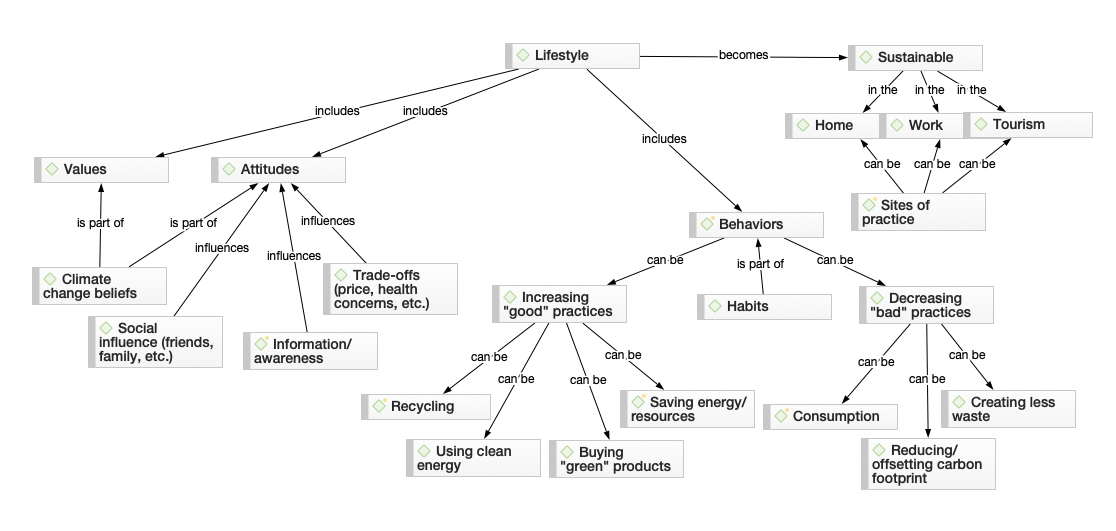
Whatever your analysis, ATLAS.ti can make it happen
An intuitive coding interface is just a few clicks away, starting with a free trial.
- Skip to main content
- Skip to primary sidebar
- Skip to footer
- QuestionPro

- Solutions Industries Gaming Automotive Sports and events Education Government Travel & Hospitality Financial Services Healthcare Cannabis Technology Use Case NPS+ Communities Audience Contactless surveys Mobile LivePolls Member Experience GDPR Positive People Science 360 Feedback Surveys
- Resources Blog eBooks Survey Templates Case Studies Training Help center
Home Market Research
Grounded Theory: What It Is + Approach in Qualitative Research

In the realm of qualitative research, the grounded theory approach stands as a stalwart methodology that has reshaped how researchers unravel the complexities of the human experience.
This approach, developed by Barney G. Glaser and Anselm L. Strauss in the 1960s, provides a systematic framework for generating theories from empirical data.
Grounded theory methods involve systematically deriving theories from qualitative data, facilitating a deep understanding of complex phenomena. The grounded theory method empowers researchers to construct concepts and theories directly from the data they collect, fostering a comprehensive and contextually rich analysis.
In this blog, we delve into the core principles of the grounded theory approach and explore how platforms like QuestionPro can enhance its application in qualitative research.
Understanding the Grounded Theory Approach
Grounded theory is a qualitative research methodology that involves developing theories directly from the data collected during the research process instead of relying on pre-existing theories or hypotheses.
This approach aims to generate insights and understanding about a particular phenomenon by systematically analyzing and coding the data to uncover patterns, relationships, and concepts.
It emphasizes research’s iterative and inductive nature, allowing theories to emerge organically from the data rather than being imposed on it. This methodology is commonly used in social sciences and other fields to explore complex social processes and generate new theories from empirical observations and interviews.
The Importance of Grounded Theory Research?
Grounded theory research is particularly well-suited for situations where you want to develop a new theory or gain a deeper understanding of a complex phenomenon that hasn’t been extensively studied before. Here are some scenarios where such theory research can be valuable:
Exploratory Studies
When you’re exploring a new area of research where little prior theory exists, it can help you generate theories and concepts directly from the data.
Complex Social Processes
It can provide insights into the underlying dynamics if you’re studying complex social processes, behaviors, interactions, or cultural phenomena.
Emergent Phenomena
When examining a relatively new or rapidly evolving phenomenon, grounded theory can help you uncover the underlying structures and trends driving its emergence.
Theory Building
If you aim to develop a new theoretical framework based on empirical evidence, it provides a systematic approach to theory building grounded in data.
Contextual Understanding
When you want to deeply understand a phenomenon within its specific context, it allows you to capture the nuances and intricacies that more hypothesis-driven methods might miss.
Understanding Participant Perspectives
It effectively captures participants’ perspectives and experiences in a detailed and nuanced manner.
Diverse Data Types
It’s useful when you’re working with diverse types of qualitative data, such as interviews, observations, field notes, or textual documents.
Challenging Assumptions
Grounded theory allows you to develop insights that contradict or expand upon established knowledge to challenge existing assumptions or theories.
Interdisciplinary Research
This can be valuable in interdisciplinary research, where you’re attempting to integrate perspectives from multiple disciplines to develop new insights.
Theory Development in Practical Fields
In fields like education, healthcare, or social work, where practical solutions are needed, it can help in developing theories that inform real-world applications.
Key steps of the grounded theory approach
The grounded theory process involves several key steps researchers follow to generate theories from empirical data systematically. While there might be variations and adaptations in different researchers’ approaches, the following steps are commonly associated with the grounded theory methodology:
Data Collection
The foundation of the constructivist grounded theory approach lies in collecting data through methods such as interviews, observations, and document analysis. This raw data serves as the bedrock for theory construction.
Open Coding
Researchers meticulously dissect the data, assigning initial codes to capture the fundamental concepts present. This stage facilitates unbiased exploration, as researchers do not force-fit data into pre-existing categories.
Axial Coding
Building upon the initial codes, researchers start categorizing and interlinking them to form more comprehensive themes. The aim is to identify connections and relationships between these categories.
Selective Coding
The process evolves further as a core category central to the phenomenon under study emerges. Researchers refine and establish links between this core category and other concepts.
Constant Comparison
Throughout the journey, researchers consistently compare new data with existing codes and categories, refining their understanding and allowing the theory to evolve organically.
Theoretical Sampling
Researchers strategically select new data sources or participants to enrich the theory’s development and validation, ensuring that the existing theory resonates with diverse perspectives.
The journey reaches its zenith with theoretical sensitivity saturation, where new data ceases to alter the theory significantly. This signifies a comprehensive understanding of the phenomenon.
Writing the Theory
Researchers compile their insights into a coherent narrative that encapsulates emerging relationships, patterns, and concepts. This narrative becomes the tangible outcome of the grounded theory study.
Advantages and disadvantages of grounded theory
Here are some advantages and disadvantages of using grounded theory:
Advantages:
- Emergent Theory: Theories are developed from data, allowing for fresh insights.
- Flexibility: Adaptable to various research contexts and dynamic phenomena.
- Holistic Understanding: In-depth immersion in data leads to comprehensive insights.
- Conceptualization: Generates new concepts and theoretical frameworks.
- Contextual Insight: Focuses on understanding phenomena within their social and cultural context.
Disadvantages:
- Time-Consuming: Iterative process requires significant time and effort.
- Subjectivity: Interpretation influenced by researcher bias.
- Lack of Reproducibility: Lack of standardized procedure can hinder replication.
- Initial Data Collection Challenges: Open-ended data collection may need clearer stopping criteria.
- Theory Ambiguity: Generated theories might be open to varied interpretations.
- Less Quantitative Emphasis: Not suitable for producing quantitative or statistical results.
QuestionPro’s role in enhancing the grounded theory approach
In their study of online community dynamics, the researchers employed grounded theory analysis to uncover emergent patterns of interaction and collaboration among participants. Platforms like QuestionPro offer a range of tools that complement and enhance the grounded theory Approach in qualitative research:
- Survey Design: Design your survey in QuestionPro to collect open-ended responses. These could be in the form of text answers, comments, or even multimedia content.
- Data Collection: Distribute the survey to your participants. You can target specific groups or populations based on your research objectives.
- Data Analysis: Once you collect the qualitative data, you can export the responses from QuestionPro. Then, you can follow the steps of the grounded theory procedures, including open coding, axial coding, and selective coding, using specialized qualitative analysis software like NVivo, Dedoose, or even manual methods.
- Theory Development: Analyze the data and identify emergent concepts and patterns. Through iterative coding and constant comparative method, you can develop grounded theory research that explains the phenomenon you’re investigating.
The grounded theory Approach remains a cornerstone in qualitative research, fostering a dynamic interplay between data and emerging theory construction.
QuestionPro’s suite of tools lends a helping hand to researchers embarking on this journey, providing support across data collection, analysis, collaboration, and visualization.
As the landscape of research evolves, the synergy between methodologies like the grounded theory approach and innovative platforms like QuestionPro paves the way for deeper insights into the tapestry of human experiences.
LEARN MORE FREE TRIAL
MORE LIKE THIS

QuestionPro BI: From Research Data to Actionable Dashboards
Apr 22, 2024

21 Best Customer Advocacy Software for Customers in 2024
Apr 19, 2024

10 Quantitative Data Analysis Software for Every Data Scientist
Apr 18, 2024

11 Best Enterprise Feedback Management Software in 2024
Other categories.
- Academic Research
- Artificial Intelligence
- Assessments
- Brand Awareness
- Case Studies
- Communities
- Consumer Insights
- Customer effort score
- Customer Engagement
- Customer Experience
- Customer Loyalty
- Customer Research
- Customer Satisfaction
- Employee Benefits
- Employee Engagement
- Employee Retention
- Friday Five
- General Data Protection Regulation
- Insights Hub
- Life@QuestionPro
- Market Research
- Mobile diaries
- Mobile Surveys
- New Features
- Online Communities
- Question Types
- Questionnaire
- QuestionPro Products
- Release Notes
- Research Tools and Apps
- Revenue at Risk
- Survey Templates
- Training Tips
- Uncategorized
- Video Learning Series
- What’s Coming Up
- Workforce Intelligence
Grounded Theory Methodology: Principles and Practices
- Reference work entry
- First Online: 13 January 2019
- Cite this reference work entry

- Linda Liska Belgrave 2 &
- Kapriskie Seide 2
2571 Accesses
19 Citations
Since Barney Glaser and Anselm Strauss’ (The discovery of grounded theory: strategies for qualitative research. New York: Adline De Gruyter, 1967) publication of their groundbreaking book, The Discovery of Grounded Theory , grounded theory methodology (GTM) has been an integral part of health social science. GTM allows for the systematic collection and analysis of qualitative data to inductively develop middle-range theories to make sense of people’s actions and experiences in the social world. Since its introduction, grounded theorists working from diverse research paradigms have expanded the methodology and developed alternative approaches to GTM. As a result, GTM permeates multiple disciplines and offers a wide diversity of variants in its application. The availability of many options can, at times, lead to confusion and misconceptions, particularly among novice users of the methodology. Consequently, in this book chapter, we aim to acquaint readers with this qualitative methodology. More specifically, we sort through five major developments in GTM and review key elements, from data collection through writing. Finally, we review published research reflecting these methods, to illustrate their application. We also note the value of GTM for elucidating components of culture that might otherwise remain hidden.
This is a preview of subscription content, log in via an institution to check access.
Access this chapter
- Available as PDF
- Read on any device
- Instant download
- Own it forever
- Available as EPUB and PDF
- Durable hardcover edition
- Dispatched in 3 to 5 business days
- Free shipping worldwide - see info
Tax calculation will be finalised at checkout
Purchases are for personal use only
Institutional subscriptions
Ahmad F, Hudak PL, Bercovitz K, Hollenberg E, Levison W. Are physicians ready for patients with internet-based health information? J Med Internet Res. 2006;8(3):e22.
Article Google Scholar
Aita K, Kai I. Physicians’ psychosocial barriers to different modes of withdrawal of life support in critical care: a qualitative study in Japan. Soc Sci Med. 2010;70(4):616–22.
Bateman J, Allen M, Samani D, Kidd J, Davies D. Virtual patient design: exploring what works and why. A grounded theory study. Med Educ. 2013;47:595–606.
Beard RL, Fetterman DJ, Wu B, Bryant L. The two voices of Alzheimer’s: attitudes toward brain health by diagnosed individuals and support persons. Gerontologist. 2009;49:S40–9.
Belgrave LL, Seide K. Coding for grounded theory. In: Bryant A, Charmaz K, editors. The SAGE handbook of current developments in grounded theory. London. Forthcoming.
Google Scholar
Brown B. Shame resilience theory: a grounded theory study on women and shame. Fam Soc. 2006;87(1):43–52.
Bryant A. Re-grounding grounded theory. J Inf Technol Theory Appl. 2002;4:25–42.
Bryant A. Grounded theory and grounded theorizing: pragmatism in research practice. New York: Oxford University Press; 2017.
Book Google Scholar
Bryant A, Charmaz K. Grounded theory in historical perspective: an epistemological account. In: Bryant A, Charmaz K, editors. The handbook of grounded theory. London: Sage; 2007a. p. 31–57.
Chapter Google Scholar
Bryant A, Charmaz K. Introduction. In: Bryant A, Charmaz K, editors. The handbook of grounded theory. London: Sage; 2007b. p. 31–57.
Charmaz K. Body, identity and self: adapting to impairment. Sociol Q. 1995;36:657–80.
Charmaz K. Constructivist and objectivist grounded theory. In: Denzin NK, Lincoln Y, editors. Handbook of qualitative research. 2nd ed. Thousand Oaks: Sage; 2000. p. 509–35.
Charmaz K. Constructing grounded theory: a practical guide through qualitative analysis. London: Sage; 2006.
Charmaz K. Constructionism and grounded theory. In: Holstein JA, Gubrium JF, editors. Handbook of constructionist research. New York: Guilford; 2007. p. 35–53.
Charmaz K. Shifting the grounds: constructivist grounded theory methods for the twenty-first century. In: Morse J, Stern P, Corbin J, Bowers B, Charmaz K, Clarke A, editors. Developing grounded theory: the second generation. Walnut Creek: Left Coast Press; 2009. p. 127–54.
Charmaz K. Constructing grounded theory. 2nd ed. Thousand Oaks: Sage; 2014.
Charmaz K, Belgrave LL. Qualitative interviewing and grounded theory analysis. In: Gubrium JF, Holstein JA, Marvasti AB, McKinney KD, editors. The sage handbook of interview research: the complexity of the craft. 2nd ed. Los Angeles: Sage; 2012. p. 347–65.
Clarke A. From grounded theory to situational analysis: what’s new? Why? How? In: Morse J, Stern P, Corbin J, Bowers B, Charmaz K, Clarke A, editors. Developing grounded theory: the second generation. Walnut Creek: Left Coast Press; 2009. p. 194–233.
Clarke A. Feminisms, grounded theory, and situational analysis revisited. In: Clarke AE, Friese C, Washburn R, editors. Situational analysis in practice: mapping research with grounded theory. Walnut Creek: Left Coast Press; 2015. p. 84–154.
Clarke A, Friese C. Grounded theory using situational analysis. In: Bryant A, Charmaz K, editors. The sage handbook of grounded theory. London: Sage; 2007. p. 363–97.
Corbin J, Strauss A. Basics of qualitative research: techniques and procedures for developing grounded theory. 4th ed. Los Angeles: Sage; 2015.
Cresswell JW. Research design: qualitative, quantitative, and mixed methods approaches. Thousand Oaks: Sage; 2009.
Cresswell JW. Qualitative inquiry & research design: choosing among five approaches. 3rd ed. Los Angeles: Sage; 2013.
Cresswell JW. Research design: qualitative, quantitative, and mixed methods approaches. 5th ed. Thousand Oaks: Sage; 2018.
Creswell JW, Poth CN. Qualitative inquiry & research design: choosing among five approaches. 4th ed. Los Angeles: Sage; 2018.
Denzin NK, Giardina MD. Qualitative inquiry and social justice: towards a politics of hope. Walnut Creek: Left Coast Press; 2009.
Erol M. Melting bones: the social construction of postmenopausal osteoporosis in Turkey. Soc Sci Med. 2011;73(10):1490–7.
Fielding N. Analytic density, postmodernism, and applied multiple methods research. In: Bergman MM, editor. Advances in mixed methods research: theories and applications. Thousand Oaks: Sage; 2008. p. 37–52.
Glaser BG. Theoretical sensitivity. Mill Valley: The Sociology Press; 1978.
Glaser BG, Strauss AL. Awareness of dying. Chicago: Aldine Pub; 1965.
Glaser BG, Strauss AL. The discovery of grounded theory: strategies for qualitative research. New York: Adline De Gruyter; 1967.
Kononowicz AA, Zary N, Edebring S, Hege I. Virtual patients – what are we talking about? A framework to classify the meanings of the term in healthcare education. BMC Med Educ. 2015;15:11.
Larsson IE, Sahlsten MJ, Sjöström B, et al. Patient participation in nursing care from a patient perspective: a grounded theory study. Scand J Caring Sci. 2007;21:313–20.
Liamputtong P. Performing qualitative cross-cultural research. Cambridge: Cambridge University Press; 2010.
Liamputtong P. Culture as social determinant of health. In: Liamputtong P, editor. Social determinants of health: individual, community and healthcare. Melbourne: Oxford University Press; 2018.
Lindsay K, Vanderpyl J, Logo P, Dalbeth N. The experience and impact of living with gout: a study of men with chronic gout using a qualitative grounded theory approach. J Clin Rheumatol. 2011;17:1–6.
Nagel DA, Burns VF, Tilley C, Augin D. When novice researchers adopt constructivist grounded theory: Navigating the less traveled paradigmatic and methodological paths in Ph.D. dissertation work. Int J Doctoral Stud. 2015;10:365–83.
Poteat T, German D, Kerrigan D. Managing uncertainty: a grounded theory of stigma in transgender health care encounters. Soc Sci Med. 2013;84:22–9.
Quah S. Health and culture. In: Blackwell encyclopedia of sociology. 2007. Retrieved from http://www.blackwellreference.com/subscriber/tocnode.html?id=g9781405124331_chunk_g978140512433114_ss1-7 .
Schnitzer G, Loots G, Escudero V, Schechter I. Negotiating the pathways into care in a globalizing world: help-seeking behavior of ultra-orthodox Jewish parents. Int J Soc Psychiatry. 2011;57(2):153–65.
Seide K. In the midst of it all: a qualitative study of the everyday life of Haitians during an ongoing cholera epidemic. Unpublished Master’s Thesis. University of Miami; 2016.
Stern PN. On solid ground: essential properties for growing grounded theory. In: Bryant A, Charmaz K, editors. The sage handbook of grounded theory. London: Sage; 2007. p. 114–26.
Strauss A, Corbin J. Grounded theory procedures and techniques. Newbury Park: Sage; 1990.
Ulysse GA. Papa, patriarchy, and power: snapshots of a good Haitian girl, feminism, & diasporic dreams. J Haitian Stud. 2006;12(1):24–47.
Wertz FJ, Charmaz K, McMullen L, Josselson R, Anderson R, McSpadden E. Five ways of doing qualitative analysis. New York: Guilford Press; 2011.
Download references
Author information
Authors and affiliations.
Department of Sociology, University of Miami, Coral Gables, FL, USA
Linda Liska Belgrave & Kapriskie Seide
You can also search for this author in PubMed Google Scholar
Corresponding author
Correspondence to Linda Liska Belgrave .
Editor information
Editors and affiliations.
School of Science and Health, Western Sydney University, Penrith, NSW, Australia
Pranee Liamputtong
Rights and permissions
Reprints and permissions
Copyright information
© 2019 Springer Nature Singapore Pte Ltd.
About this entry
Cite this entry.
Belgrave, L.L., Seide, K. (2019). Grounded Theory Methodology: Principles and Practices. In: Liamputtong, P. (eds) Handbook of Research Methods in Health Social Sciences. Springer, Singapore. https://doi.org/10.1007/978-981-10-5251-4_84
Download citation
DOI : https://doi.org/10.1007/978-981-10-5251-4_84
Published : 13 January 2019
Publisher Name : Springer, Singapore
Print ISBN : 978-981-10-5250-7
Online ISBN : 978-981-10-5251-4
eBook Packages : Social Sciences Reference Module Humanities and Social Sciences Reference Module Business, Economics and Social Sciences
Share this entry
Anyone you share the following link with will be able to read this content:
Sorry, a shareable link is not currently available for this article.
Provided by the Springer Nature SharedIt content-sharing initiative
- Publish with us
Policies and ethics
- Find a journal
- Track your research
Tuesday, April 20, 2021
Grounded Theory Analysis with MAXQDA: Step-By-Step Guide
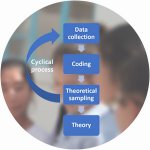
MAXQDA supports various methodological frameworks, including grounded theory , by helping you collect, organize, analyze, visualize, and publish your data. This article will walk you through tools that will help you get started with your MAXQDA-supported grounded theory analysis quickly and easily.

What is Grounded Theory?
The central principle of grounded theory is that the researcher’s theories about a topic are constructed based on their data. In other words, by collecting and analyzing qualitative data, the researcher can construct a new theory that is “grounded” in that data . Grounded theory, therefore, begins with the collection of data based on a question rather than the aim to test a hypothesis.
The principles of grounded theory were articulated in 1967 by sociologists Barney Glaser and Anselm Strauss in their book The Discovery of Grounded Theory . The idea of starting with the data in order to create the theory contradicted previous methodological traditions, which mostly suggested that researchers should verify already-formulated theory during data collection.
Grounded theory is the discovery of theory from data systematically obtained from social research. Glaser & Strauss, 2009
Grounded theory remains one of the most popular qualitative methodological frameworks used by researchers today. This may be because grounded theory methodology and its application “foster seeing your data in fresh ways and exploring your ideas about the data through early analytic writing” (Charmaz, 2006). There are also many iterations of the grounded theory process, especially when it comes to coding. This article will, therefore, serve as a practical guide to analyzing data with MAXQDA rather than a methodological assessment of grounded theory itself.
Grounded Theory Analysis with MAXQDA
In grounded theory-based analysis, the researcher generally analyzes the data as follows: finding repeating themes by thoroughly reviewing the data; coding the emergent themes with keywords and phrases; grouping the codes into concepts hierarchically; and then categorizing the concepts through relationship identification. Finally, the categories created through this process, as well as the links found between them, are used as the basis for the development of a new theory.
The main steps in using MAXQDA to analyze qualitative data based on the grounded theory methodology are what we call the ‘4 Cs’:
- coding the data,
- customizing the Code System,
- category building with Creative Coding, and
- constructing theories with MAXMaps.
These steps facilitate an analysis process that gives the researcher the freedom to construct new theories instead of simply collecting data to test how well an established theory applies to the social phenomena they are studying. However, the freedom that grounded theory gives to the researcher may also be one of its biggest challenges when it is put into practice.
With no rigid structure or prescribed rules, researchers must work entirely on their own, which often leads to uncertainty about how to get the analysis process started. Grounded theory research, especially when conducted with the constant comparative method of data analysis, is “a labor-intensive task that requires the researcher to invest time in the processes of analysis and data collection” (Kolb, 2012).
As shown above, the process is much clearer when you use software. With MAXQDA, you can search for data segments as you code the data and have analytical ideas, allowing you to develop the theory in real-time! If you don’t already have a MAXQDA license , download the 14-day free trial to get started:
Download Free Trial
Step 1: Coding the Data
Codes create order – think of a library’s keyword catalog, for example. Catalogs help you find the right book and at the same time provide an overview of the topics on which the library has books. Of course, how useful such a catalog is will depend on the usability of the index system and on the accuracy of the keywords assigned. The same is true for a researcher’s coding work. Assigning codes to segments of texts, images, or audio/video footage in MAXQDA is known as ‘coding’ .

Coding in grounded theory can be divided into two main phases:
- First, there is the initial ‘open coding’ stage. In this stage, the researcher works closely with the data, trying to name specific lines or segments of the data by creating new codes. It is important to keep an open mind so that you avoid limiting the number of codes. The core codes will be refined during subsequent analysis phases.
- ‘Selective coding’ in advanced stages of the coding process (aka second, third, etc. rounds of coding) comes next. In these later stages of coding, the researcher focuses their coding to define the most significant higher-level codes and sort the lower-level codes created during the initial coding phase. (See steps 2 & 3)
Since codes should be grounded in the data, one of the most popular coding techniques in grounded theory analysis is known as ‘in-vivo coding’ : the use of the very words or phrases found in the data, such as interview transcripts or texts, as codes.

MAXQDA’s in-vivo coding function is specifically designed to help facilitate this type of grounded theory-based analysis. Simply select the word(s) you want to use as a code and then click on the ‘Code in-vivo’ symbol in the “Document Browser” window toolbar. The selected word will be added into the “Code System” window as the code for this short text segment. MAXQDA’s various coding options can also be selected from the context menu that pops up when you select a document segment and click the right mouse button.
Step 2: Customizing the Code System
During later ’rounds’ of coding, the researcher goes through the data they have already coded again using the selective coding technique mentioned above. You can now create code hierarchies by sorting codes into ‘parent codes’ and ‘subcodes’ in MAXQDA’s “Code System” window . This process will help you create and refine what is called a ‘code tree’, which will allow you to easily identify codes with similar content and group them into concepts.
Advanced Stages of Coding with MAXQDA
MAXQDA helps you with this step by allowing you to have your codes organized in a hierarchical structure automatically , meaning you can create multiple subcodes, followed by subcodes of subcodes. The Code System is also automatically shown as a tree structure on the screen, which you can open in a separate window if your code system has a complicated structure with many subcodes.
This hierarchical structure can contain up to ten levels and the total number of codes is unlimited. The numbers in the rightmost column of the “Code System” window indicate the number of the coded segments, allowing you to easily track their frequency. You can also expand or close the sub-categories by clicking the arrow icon next to the code, as shown below:
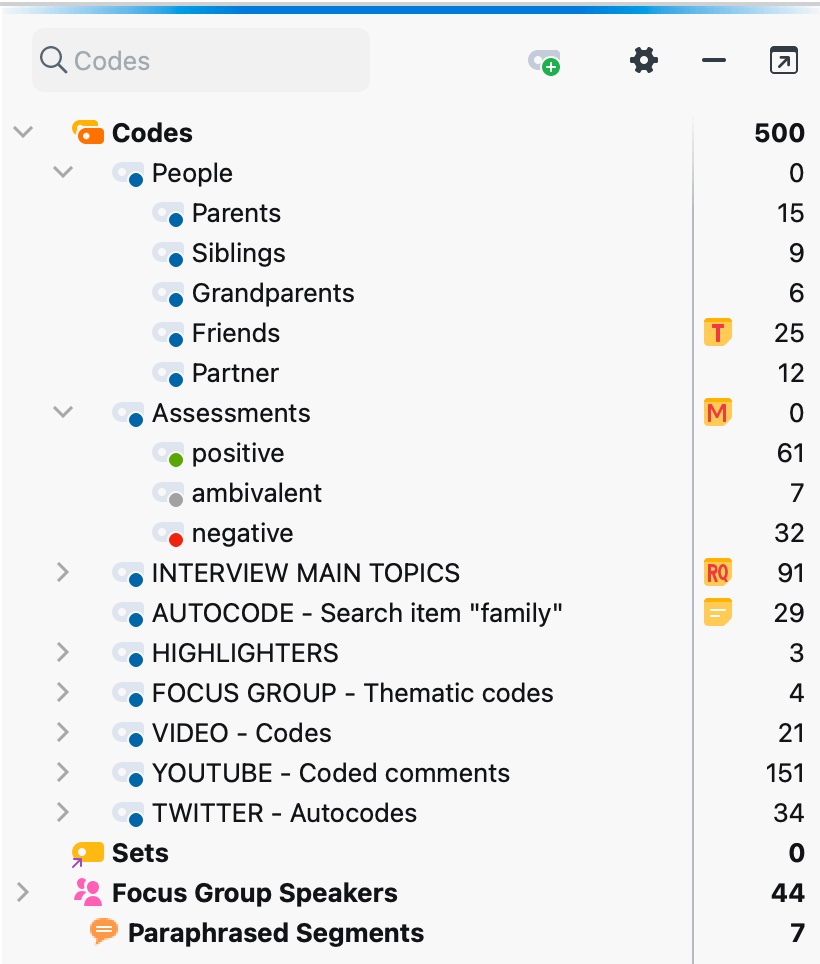
Step 3: Category Building with Creative Coding
In grounded theory analysis, categories are created by grouping together similar concepts in the second half of the selective coding phase (or third phase of coding, as is described by some experts). These categories will ultimately be the basis for the new theory’s structure because the researcher will be able to label the links between categories theoretically (Schreiber, 2001). When new codes are generated, sorted, and organized into the hierarchical code structure, the relationships between codes begin to emerge.
MAXQDA’s Creative Coding function is the perfect tool for this categorization process because it provides the researcher with a large workspace on which codes can be freely moved and sorted in order to form meaningful groups. To begin, simply click Creative Coding in the Codes menu tab at the top of the screen to activate the Creative Coding Mode. You will see the following workspace on the screen:
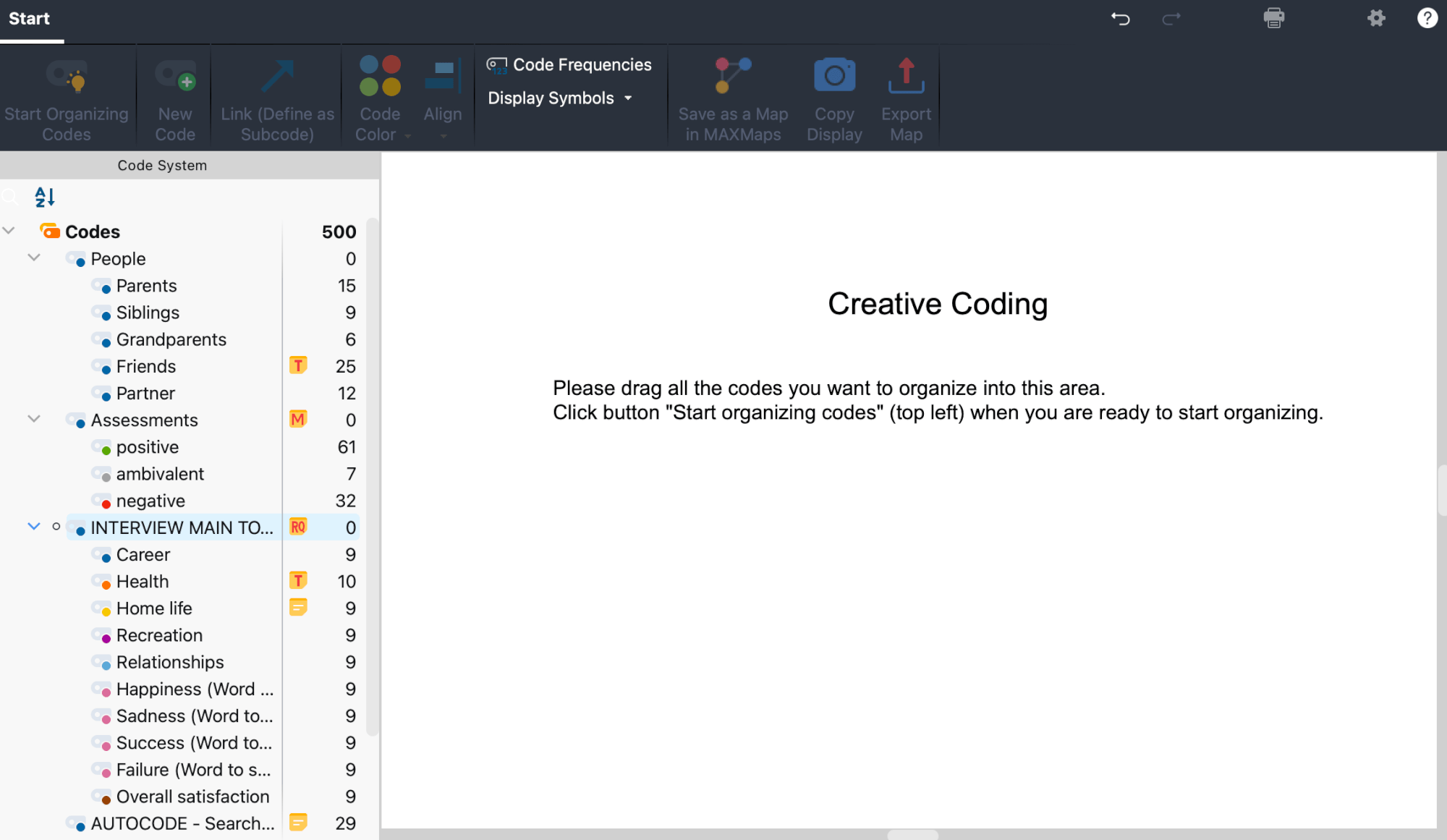
Drag the codes you want to work with from the “Code System” window and drop them into the MAXMaps workspace. You can now freely group and organize the codes with your mouse , create new parent and subcodes if necessary, and change the color of the codes as desired. MAXQDA provides you with an easy-to-use toolbar for all of these functions that will appear above the workspace.
Once you have finished organizing your codes, quit Creative Coding to apply the changes to your code tree. Click the ‘Quit Creative Coding’ symbol in the top left of the window and then choose ‘yes’ in the pop-up window.
Step 4: Constructing the Theory with MAXMaps
After the selective coding phase, the theoretical links between the categories will have become clearer. The next step in grounded theory is the theoretical sampling phase, in which further select data is collected in order to develop the emerging theory and elaborate the main categories constituting it.
We recommend using MAXQDA’s MAXMaps feature to create a visual diagram of your theory at this stage. MAXMaps allows you to visualize complex connections in the data and relationships in the theory by creating concept maps that show how the different elements are related to one another.
You can either begin with a blank map that you can easily drag and drop elements into, or you can use one of the several model templates in MAXMaps to automatically import connections found in your data. For example, if you are interested in examining the connections within a specific category, you can use a Code Theory Model to display the connections between a code, its subcodes, and memos, as is shown here:
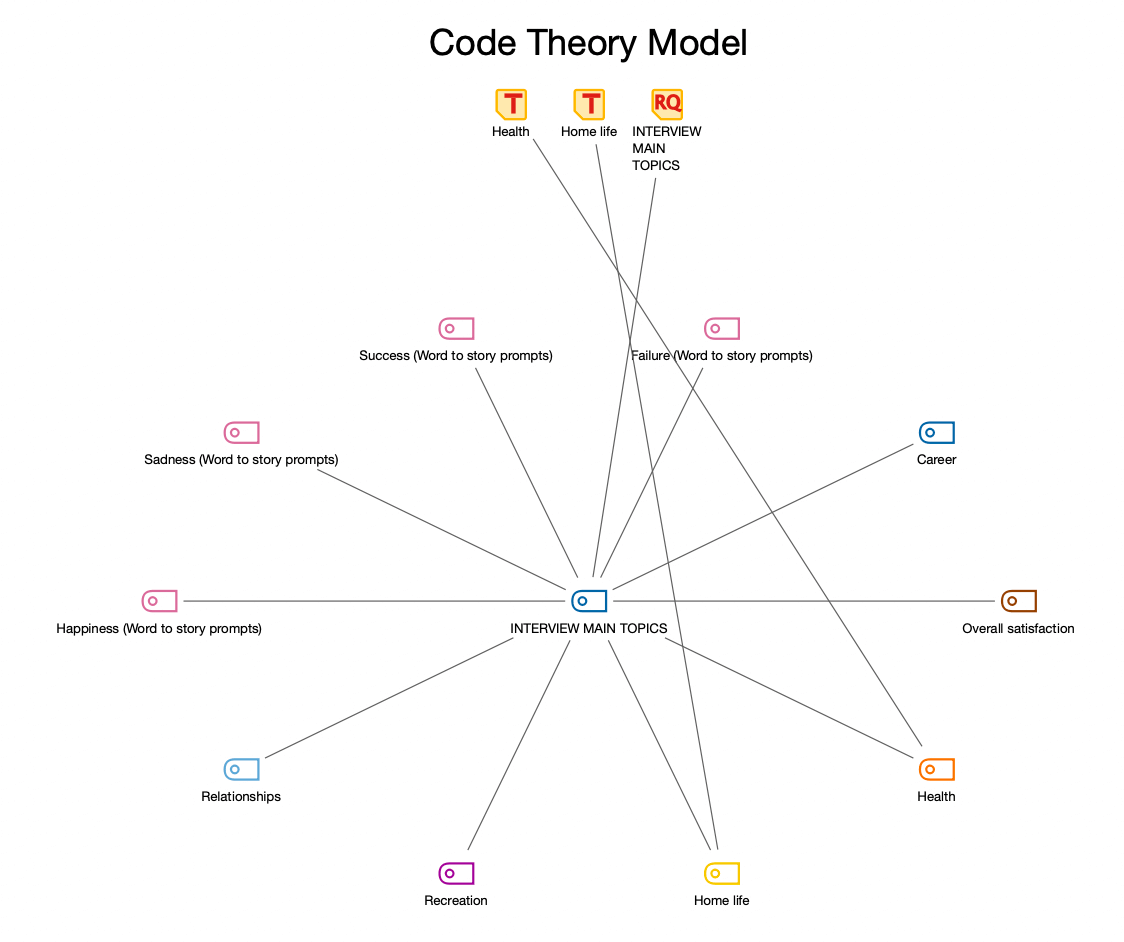
You can also create tables and worksheets to gain a better perspective of the elements within a project as well as easily find the sources of your data because all the elements used in a map are interactive, meaning they are connected to the MAXQDA project . Simply double-click on the icon to open the document, coded segment, or memo to read or even modify the analysis work that brought you to the theory you are visualizing. MAXMaps is the perfect tool to easily find the places in your theory where further data is needed during the theoretical sampling phase in your grounded theory analysis.
Of course, while we have outlined several steps and given suggestions as to how MAXQDA can support your research, grounded theory analysis is not a linear process; during later stages of theoretical sampling, the researcher must code new data and at that point, they might want to revise some of the categories they have already developed, which means the cycle will begin again.
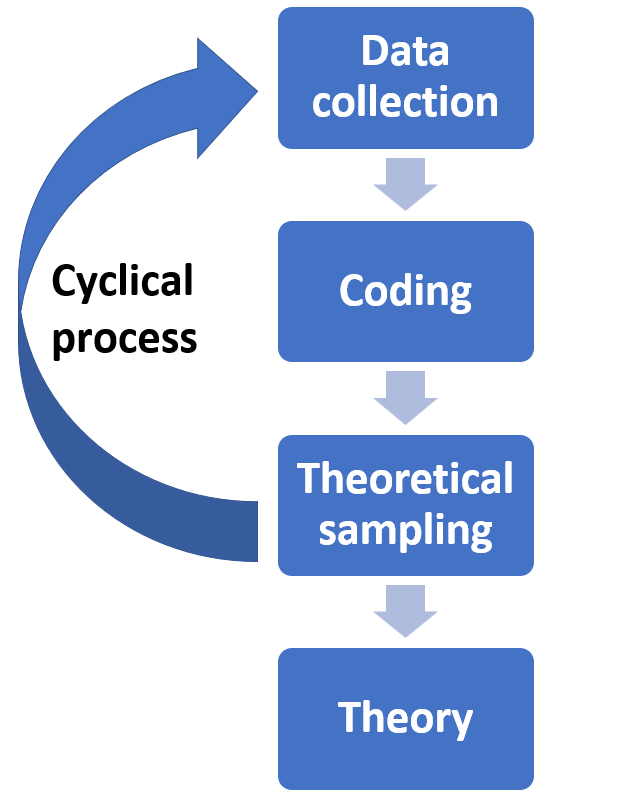
Don’t get discouraged! The cyclical process might seem daunting at first, but with each round of testing and ameliorating your categories using MAXQDA, your theory will become both clearer and more resilient. Remember, if you have made it this far, you are near the finish line of constructing a new theory , which could change how your topic is viewed from now on.
Tip: The Importance of Memos
You can organize your memos in whichever way you feel most comfortable with, but we highly recommend adding a heading and explaining which segment of data they are referring to. By taking a few extra minutes to organize your memos, you will save a lot more time during the later stages of coding and reporting. Luckily, MAXQDA automates several steps for you so that you don’t need to hand write and lay out your notes with cards or post-its any longer!
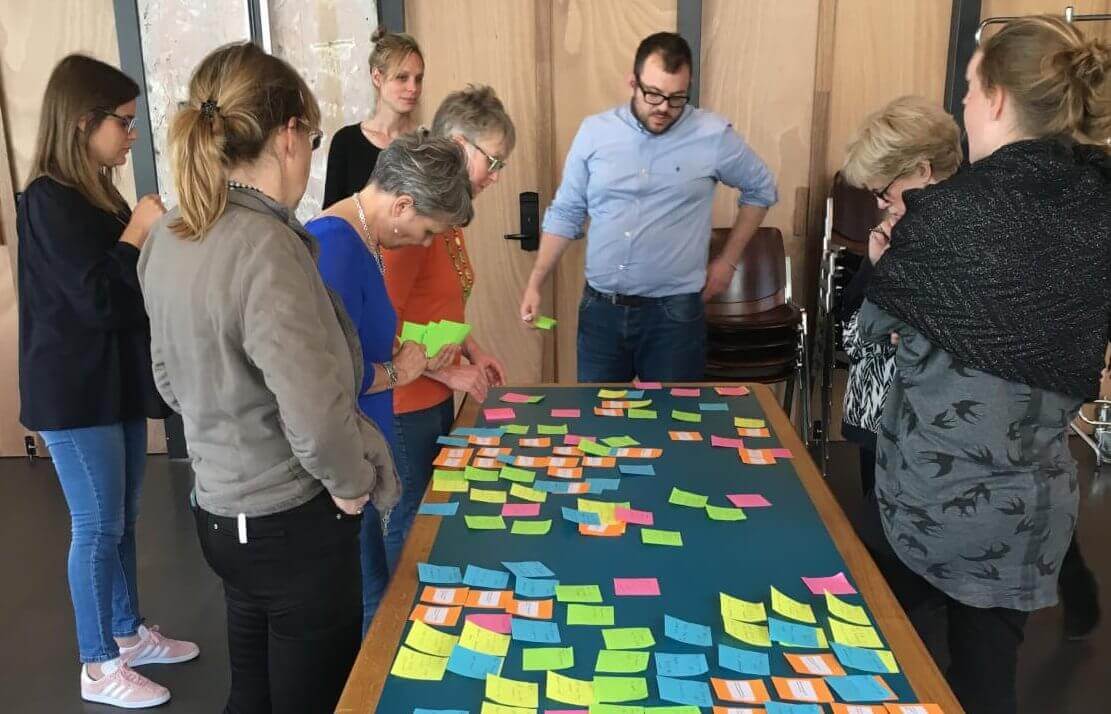
How to Create Memos in MAXQDA
Memos are an integral part of any MAXQDA project, just as memo writing is an essential part of grounded theory research. MAXQDA’s intuitive design allows for flexibility in methodological approaches and supports you to be as creative as you wish to be during your research and analysis processes.
You can differentiate between various types of memos within MAXQDA that then have different roles in your analysis. In MAXQDA, memos can be attached to documents , document groups, audio and video files, etc. Memos can also be assigned to the codes themselves. Code memos often contain category definitions and anchor examples, which can clarify the meaning of the categories you create through grounded theory analysis and explain their link back to the original quotes. There is even the option to create a ‘free’ memo, which is not attached to anything other than the project.
To create a memo, double-click the memo icon and a dialogue window will appear. Name your memo and add the text. The ‘Author’ and ‘Creation date’ fields are filled-in automatically to help save you time.
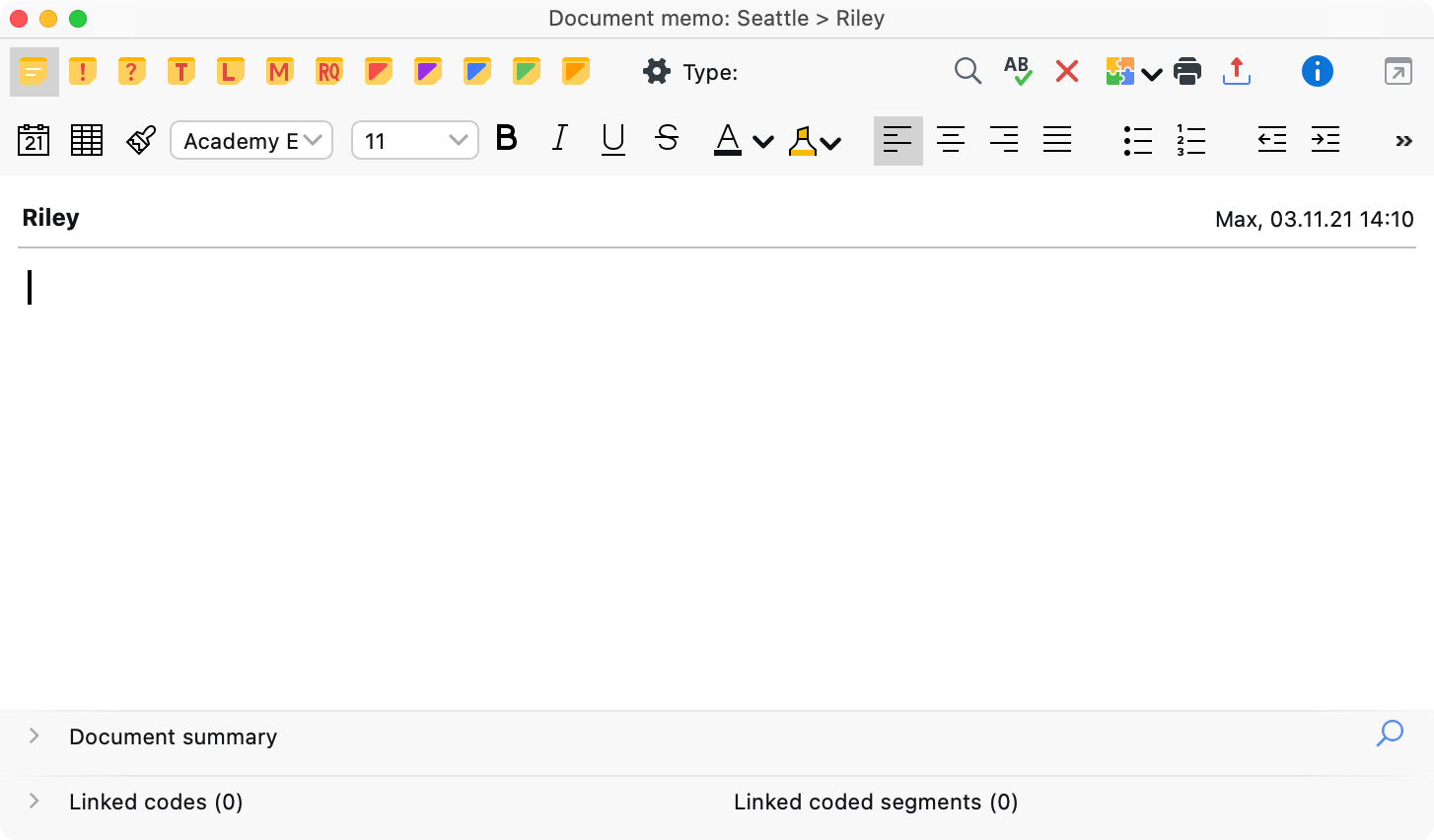
Next, you can choose to assign a ‘type’ to your memo using one of the 10 symbols provided by MAXQDA. When conducting grounded theory analysis, we highly recommend sorting your memos into types. Theoretical Memos are the most common type of memo used in GT analysis because they describe the researcher’s ideas behind their analysis activities.
The researcher ‘theorizes’ from the data by writing memos to extract theoretical meaning behind codes and logical relationships between codes during the coding process Glaser, 1998.
In your MAXQDA project, you might choose to use the memo icon with a “T” to represent theoretical memos, the memo icon with an “M” for methodological memos, assign the blue icon for ideas generated in-vivo, red for ideas from previous research, and so on. You can customize your memo organization system in whichever way works best for you.
When you have finished writing a memo, simply close the window and MAXQDA will save it automatically. Moreover, the information you add to a new memo is saved in the open memo window at regular intervals of 5 minutes, so you don’t have to worry about losing your ideas if you accidentally close the dialogue window!
Overview of Memos
With so many different options and types of memos available in MAXQDA, you might find it helpful to have an overview of all your memo work and information. MAXQDA’s Overview of Memos was created for this purpose specifically and can help you save a lot of time when you start writing. The quickest way to access the Overview of Memos is in the Reports tab at the top of your screen in MAXQDA.
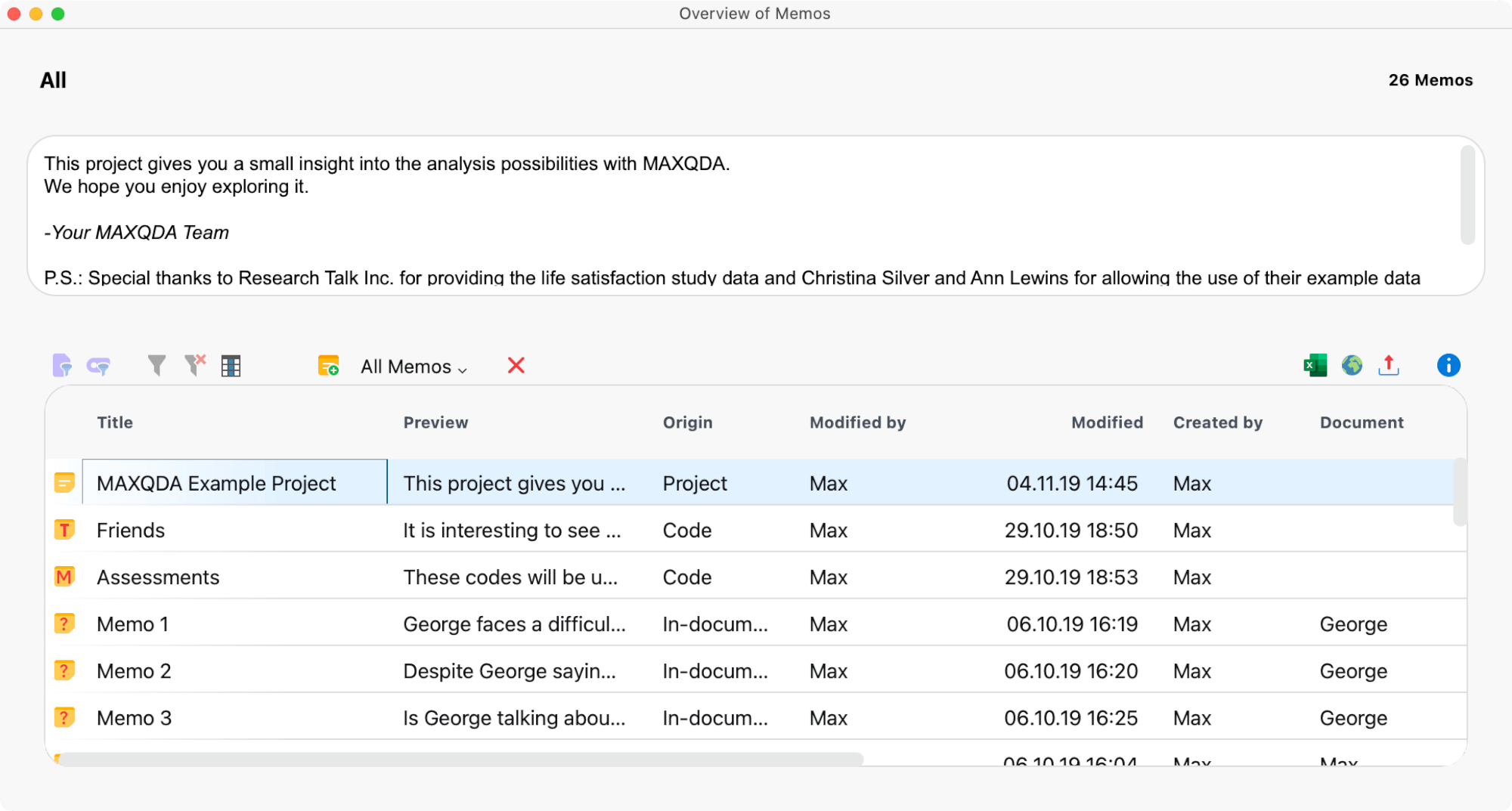
A new dialogue window will open with a table containing all of the important information about your memos, including where the memo is, the title, the author, its origin, and a preview of the memo’s content. From there, you can browse your work, filter the memos by column to find specific information, and jump to the memo you are looking for. Gathering and viewing your thoughts throughout the entire grounded theory analysis process has never been easier!

Literature Cited
- Charmaz, K., Constructing Grounded Theory: A Practical Guide Through Qualitative Analysis. — SAGE, 2006.
- Glaser, B., Doing Grounded Theory: Issues and Discussions. — Sociology Press, 1998.
- Glaser, B., Strauss, A. The Discovery of Grounded Theory: Strategies for Qualitative Research. — Transaction Publishers, 2009.
- Kolb, Sharon M., Grounded theory and the constant comparative method: Valid research strategies for educators. – Journal of Emerging Trends in Educational Research and Policy Studies 3.1, 2012 (83).
- Montgomery, P., Bailey, P. H., Field notes and theoretical memos in grounded theory. – Western Journal of Nursing Research, 2007, 29(1), 65-79.
- Schreiber, R. S., Stern, P. N., Using grounded theory in nursing. – Springer Publishing Company, 2001.
Discover many more hints, guidelines, and tips on how to conduct grounded theory studies with MAXQDA in the MAXQDA Press Guide
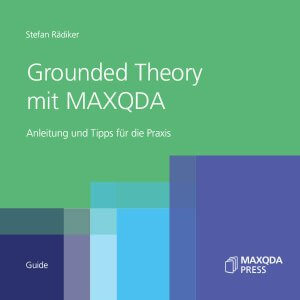
Spotlight Session: Grounded Theory with MAXQDA
Special thanks to Dr. Timothy C. Guetterman for his editorial contribution to this article!
Editor’s note: this post has been updated from its original version published in November 2018.
MAXQDA Newsletter
Our research and analysis tips, straight to your inbox.
Similar Articles
- #ResearchforChange Grants (46)
- Conferences & Events (32)
- Field Work Diary (39)
- Learning MAXQDA (110)
- Research Projects (133)
- Tip of the Month (57)
- Uncategorized (8)
- Updates (65)
- VERBI News (71)


Designing Studies with a Grounded Theory Methodology
by Janet Salmons, PhD., Research Community Manager for SAGE Methodspace
Research design is the SAGE Methodspace focus for the first quarter of 2023. Selecting the methodology is an essential piece of research design. Grounded theory is one option, a methodology used for both qualitative and quantitative research.
What is grounded theory?
The SAGE Handbook of Grounded Theory describes it as:
The Grounded Theory Method (GTM) comprises a systematic, inductive, and comparative approach for conducting inquiry for the purpose of constructing theory (Charmaz, 2006; Charmaz & Henwood, 2007). The method is designed to encourage researchers’ persistent interaction with their data, while remaining constantly involved with their emerging analyses. Data collection and analysis proceed simultaneously and each informs and streamlines the other. The GTM builds empirical checks into the analytic process and leads researchers to examine all possible theoretical explanations for their empirical findings. The iterative process of moving back and forth between empirical data and emerging analysis makes the collected data progressively more focused and the analysis successively more theoretical.
While a number of schools of thought exist, a couple of points from this definition are consistently associated with GT:
Purpose of constructing theory. This is a methodology used to generate, examine, and/or test theoretical constructs. New or updated theory is grounded in the data.
Data collection and analysis proceed simultaneously. It is an iterative, not a linear research process. A variety of collection and analytic approaches can be used, and GT offers flexible guidelines that fit the purpose of theory-development.
The multidisciplinary collection of open-access articles listed below offers a variety of perspectives on grounded theory. You will notice that some names appear more than once on this list; Glaser, Charmaz, Birks and Mills are respected methodologists important to the development of GT.
Bryant, A., & Charmaz, K. (2007). The SAGE handbook of grounded theory. SAGE Publications Ltd, https://doi.org/10.4135/9781848607941
What can we learn from grounded theory methodologists?
Birks, M., Hoare, K., & Mills, J. (2019). Grounded Theory: The FAQs. International Journal of Qualitative Methods, 18. https://doi.org/10.1177/1609406919882535
Abstract. Since being developed as a research methodology in the 1960s, grounded theory (GT) has grown in popularity. In spite of its prevalence, considerable confusion surrounds GT, particularly in respect of the essential methods that characterize this approach to research. Misinformation is evident in the literature around issues such as the various approaches to GT, how long the process takes, the role of literature and preconceptions, generating and using data and strategies to produce theory. This article examines the most frequently asked questions about GT in an effort to demystify its purpose and use. Understanding the fundamental concepts of GT is critical to the correct use and application of GT methods and the ultimate production of theory that is grounded in data. More significantly, this understanding can prevent researchers encountering common pitfalls that can impede the process and impact the products of research.
Chamberlain-Salaun, J., Mills, J., & Usher, K. (2013). Linking Symbolic Interactionism and Grounded Theory Methods in a Research Design:From Corbin and Strauss’ Assumptions to Action. SAGE Open , 3 (3), 2158244013505757. https://doi.org/10.1177/2158244013505757
Abstract. This article focuses on Corbin and Strauss’ evolved version of grounded theory. In the third edition of their seminal text, Basics of Qualitative Research: Techniques and Procedures for Developing Grounded Theory , the authors present 16 assumptions that underpin their conception of grounded theory methodology. The assumptions stem from a symbolic interactionism perspective of social life, including the themes of meaning, action and interaction, self and perspectives. As research design incorporates both methodology and methods, the authors aim to expose the linkages between the 16 assumptions and essential grounded theory methods, highlighting the application of the latter in light of the former. Analyzing the links between symbolic interactionism and essential grounded theory methods provides novice researchers and researchers new to grounded theory with a foundation from which to design an evolved grounded theory research study.
Charmaz, K. (2017). Special Invited Paper: Continuities, Contradictions, and Critical Inquiry in Grounded Theory. International Journal of Qualitative Methods, 16(1). https://doi.org/10.1177/1609406917719350
Abstract. What continuities and contradictions can qualitative researchers discern among versions of the grounded theory method? How do contradictions within the method affect research practice? How do new versions of grounded theory advance research practice and critical inquiry? To answer these questions, this keynote address begins with a brief overview of grounded theory for those who are unfamiliar with the method and subsequently discusses the continuities and contradictions between versions of the method. Constructivist grounded theory (CGT) uses the methodological strategies of the original version but builds on its pragmatist heritage, shifts its epistemological foundations, and resolves contradictions in earlier versions of the method. The result means placing grounded theory in the social constructionist tradition, viewing data as co-constructed with research participants, puncturing deeply held methodological preconceptions, and subsequently fostering a heightened methodological self-consciousness. The practice of CGT assists researchers in interrogating their data, nascent analyses, research actions, and themselves each step along the way. Subsequently, researchers can gain awareness of the pervasiveness of Anglo-North American worldviews throughout inquiry. CGT not only aids theorizing and defining and developing emergent critical questions during the research process but also brings power into purview.
Chun Tie Y, Birks M, Francis K. Grounded theory research: A design framework for novice researchers. SAGE Open Medicine. 2019;7. doi:10.1177/2050312118822927
Abstract. Grounded theory is a well-known methodology employed in many research studies. Qualitative and quantitative data generation techniques can be used in a grounded theory study. Grounded theory sets out to discover or construct theory from data, systematically obtained and analysed using comparative analysis. While grounded theory is inherently flexible, it is a complex methodology. Thus, novice researchers strive to understand the discourse and the practical application of grounded theory concepts and processes.
Glaser, B. G. (2002). Conceptualization: On Theory and Theorizing Using Grounded Theory. International Journal of Qualitative Methods, 1(2), 23–38. https://doi.org/10.1177/160940690200100203
Abstract. This article explores the use of grounded theory to generate conceptualizations of emergent social patterns in research data. The naming of patterns and their abstraction across time, place and people, are discussed. The constant comparative method employed in grounded data analysis is offered as a developmental tool for enhancing researchers' abilities to conceptualize and form emergent theories. Conceptual levels, descriptions, power and flawed approaches to analysis are explored at length.
Goldkuhl, G., & Cronholm, S. (2010). Adding Theoretical Grounding to Grounded Theory: Toward Multi-Grounded Theory. International Journal of Qualitative Methods, 9(2), 187–205. https://doi.org/10.1177/160940691000900205
Abstract. The purpose of this paper is to challenge some of the cornerstones of the grounded theory approach and propose an extended and alternative approach for data analysis and theory development, which the authors call multi-grounded theory (MGT). A multi-grounded theory is not only empirically grounded; it is also grounded in other ways. Three different grounding processes are acknowledged: theoretical, empirical, and internal grounding. The authors go beyond the pure inductivist approach in GT and add the explicit use of external theories. A working procedure of theory development in MGT is presented, which can be seen as an extension of the grounded theory approach.
Mills, J., Bonner, A., & Francis, K. (2006). The Development of Constructivist Grounded Theory. International Journal of Qualitative Methods, 5(1), 25–35. https://doi.org/10.1177/160940690600500103
Abstract. Constructivist grounded theory is a popular method for research studies primarily in the disciplines of psychology, education, and nursing. In this article, the authors aim to locate the roots of constructivist grounded theory and then trace its development. They examine key grounded theory texts to discern their ontological and epistemological orientation. They find Strauss and Corbin's texts on grounded theory to possess a discernable thread of constructivism in their approach to inquiry. They also discuss Charmaz's landmark work on constructivist grounded theory relative to her positioning of the researcher in relation to the participants, analysis of the data, and rendering of participants' experiences into grounded theory. Grounded theory can be seen as a methodological spiral that begins with Glaser and Strauss' original text and continues today. The variety of epistemological positions that grounded theorists adopt are located at various points on this spiral and are reflective of their underlying ontologies.
Ralph, N., Birks, M., & Chapman, Y. (2015). The Methodological Dynamism of Grounded Theory. International Journal of Qualitative Methods, 14(4). https://doi.org/10.1177/1609406915611576
Abstract. Variations in grounded theory (GT) interpretation are the subject of ongoing debate. Divergences of opinion, genres, approaches, methodologies, and methods exist, resulting in disagreement on what GT methodology is and how it comes to be. From the postpositivism of Glaser and Strauss, to the symbolic interactionist roots of Strauss and Corbin, through to the constructivism of Charmaz, the field of GT methodology is distinctive in the sense that those using it offer new ontological, epistemological, and methodological perspectives at specific moments in time. We explore the unusual dynamism attached to GT’s underpinnings. Our view is that through a process of symbolic interactionism, in which generations of researchers interact with their context, moments are formed and philosophical perspectives are interpreted in a manner congruent with GT’s essential methods. We call this methodological dynamism, a process characterized by contextual awareness and moment formation, contemporaneous translation, generational methodology, and methodological consumerism.
Redman-MacLaren, M., & Mills, J. (2015). Transformational Grounded Theory: Theory, Voice, and Action. International Journal of Qualitative Methods, 14(3), 1–12. https://doi.org/10.1177/160940691501400301
Abstract. Grounded theory has been evolving methodologically since Barney Glaser and Anselm Strauss first described it in the late 1960s. Initially underpinned by modernist philosophy, grounded theory has had recent turns including the adoption of both constructivism and postmodernism. This article explores ontological offerings of critical realism as a basis for transformational grounded theory informed by participatory action research and decolonizing research methodologies. The potential for both theory and action to result from this critical grounded theory methodology, which promotes greater participation and equity of power for positive change, is the transformational in transformational grounded theory.
Seaman, J. (2008). Adopting a Grounded Theory Approach to Cultural-Historical Research: Conflicting Methodologies or Complementary Methods? International Journal of Qualitative Methods , 7 (1), 1-17. https://doi.org/10.1177/160940690800700101
Abstract. Grounded theory has long been regarded as a valuable way to conduct social and educational research. However, recent constructivist and postmodern insights are challenging long-standing assumptions, most notably by suggesting that grounded theory can be flexibly integrated with existing theories. This move hinges on repositioning grounded theory from a methodology with positivist underpinnings to an approach that can be used within different theoretical frameworks. In this article the author reviews this recent transformation of grounded theory, engages in the project of repositioning it as an approach by using cultural historical activity theory as a test case, and outlines several practical methods implied by the joint use of grounded theory as an approach and activity theory as a methodology. One implication is the adoption of a dialectic, as opposed to a constructivist or objectivist, stance toward grounded theory inquiry, a stance that helps move past the problem of emergence versus forcing.
Timonen, V., Foley, G., & Conlon, C. (2018). Challenges When Using Grounded Theory: A Pragmatic Introduction to Doing GT Research. International Journal of Qualitative Methods , 17 (1), 1609406918758086. https://doi.org/10.1177/1609406918758086
Abstract. The grounded theory (GT) method is widely applied, yet frequently misunderstood. We outline the main variants of GT and dispel the most common myths associated with GT. We argue that the different variants of GT incorporate a core set of shared procedures that can be put to work by any researcher or team from their chosen ontological and epistemological perspective. This “shared core” of the GT method is articulated as the principles of (1) taking the word “grounded” seriously, (2) capturing and explaining context-related social processes, (3) pursuing theory through engagement with data, and (4) pursuing theory through theoretical sampling. In this article, we have put forward, in a nutshell, a distillation of core principles underpinning existing GT approaches that can aid further engagement with the different variants of GT. We are motivated by the wish to make GT more comprehensible and accessible, especially for researchers who are new to the method.
More Methodspace posts about Research Design

Let’s use this open-access research case to think through the possibilities and potential problems involved with studying blog posts and online discussions.

From the moment social media platforms began to welcome user-generated content, researchers have looked for ways to study it. Learn more with open-access articles about social media platforms.

Do you think about research questions as an insider, outsider, or somewhere in between? Why is positionality important in online research?

Julianne Cheek and Elise Øby, co-authors of the book Research Design: Why Thinking About Design Matters, discuss how to make decisions about what qualitative, quantitative, or mixed methods data to collect and how to do so. This post is the third of a three-part series of posts that feature ten author interviews.

What if we didn’t have to go fast to do our academic work and research? What if we could embrace the spaces and places around us to slow down? What could that mean for us personally, professionally, and in how we relate to social justice and ecological issues?

Doctoral student Sandra Flores discusses her research in Puerto Rico, and what she learned from the experience.

Julianne Cheek and Elise Øby, co-authors of the book Research Design: Why Thinking About Design Matters, discuss how to make decisions about methodology in this collection of video interviews. This post is the second of a three-part series of posts that feature ten author interviews.

Learn about action and participatory research methods, and ways to design and carry out research with, not on, communities.

Is it too hard to address problems in our complex world with one type of data? Mixed methods might be the answer. Find explanations and open-access resources in this post.

Chart research directions that take you to the roots of the problem. Learn more in this guest post from Dr. Donna Mertens.

We need to think about research before we design and conduct it.
Julianne Cheek and Elise Øby, co-authors of the book Research Design: Why Thinking About Design Matters, discuss the first three chapters in these video interviews: Chapter 1 – Research Design: What You Need to Think About and Why
Chapter 2 – Ethical Issues in Research Design
Chapter 3 – Developing Your Research Questions

The process for researching literature on research methods is somewhat different from the process used for researching literature about the topic, problem, or questions. What should we keep in mind when selecting methods literature?
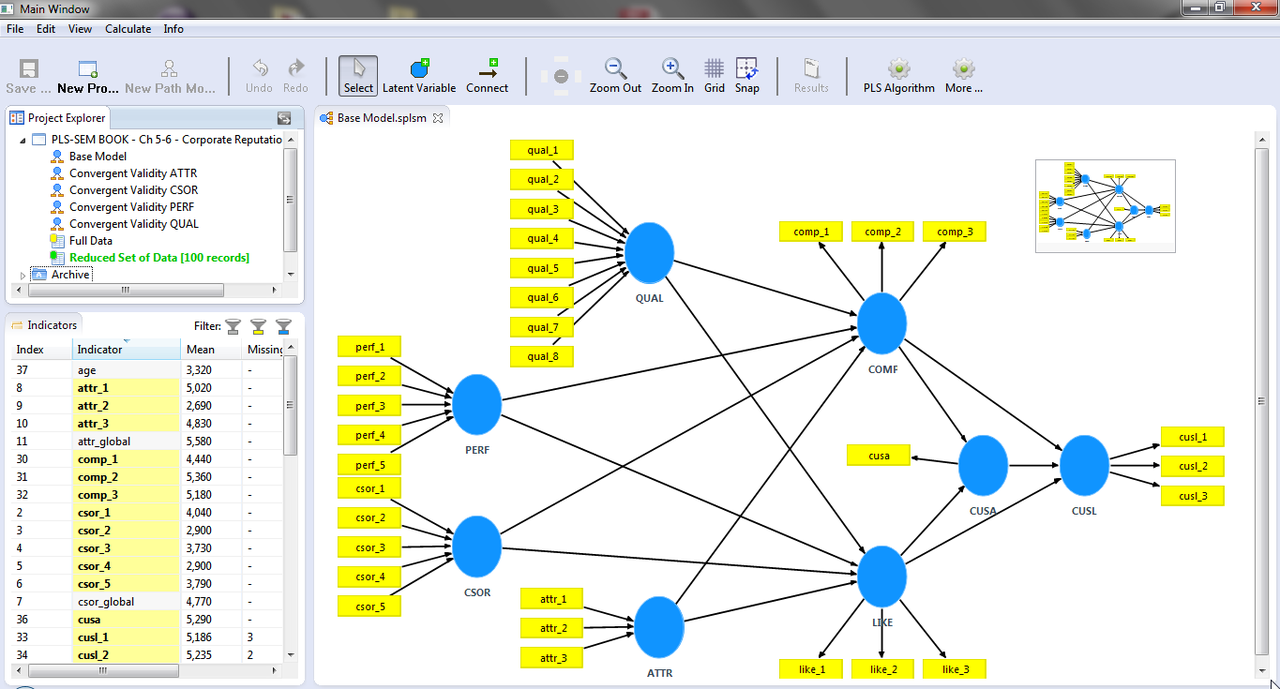
Partial least squares structural equation modeling (PLS-SEM) enables researchers to model and estimate complex cause-effects relationship models

How do researchers make design decisions about the methodology and methods?

In-depth comprehension and interpretation of social events, human experiences, and behaviours are often the main goals of qualitative researchers. Learn about the primary concerns of qualitative researchers in this guest post by Pinaki Burman.

Learn about connecting the unit of analysis with the qualitative methodology.

Research can often feel like an overwhelming process. If you are a novice researcher, there can be a lot of new terminology to learn too. This is where research road mapping can help!

These difficult times present challenges for researchers. Find five original posts by Robert Kozinets about using Netnography to study sensitive topics.

Looking back at 2023, find all posts here! We explored stages of a research project, from concept to publication. In each quarter we focused on one part of the process. In this recap for the year you will find original guest posts, interviews, curated collections of open-access resources, recordings from webinars or roundtable discussions, and instructional resources.

Read this collection of multidisciplinary articles to explore epistemological questions in Indigenous research.

Methods Film Fest! We can read what they write, but what do researchers say? What are they thinking about, what are they exploring, what insights do they share about methodologies, methods, and approaches? In 2023 Methodspace produced 32 videos, and you can find them all in this post!

Find suggestions for navigating the problem formulation stage that precedes research design in social science research.

Let’s begin this quarter’s exploration of research design by thinking about the research problem or topic. Who decides what to study?

This post includes tips about writing qualitative proposals excerpted from Research Design by Creswell and Creswell.

Learn how to design and defend your PhD research with the Idea Puzzle software from Ricardo Morais.

Dr. Stephen Gorard defines and explains randomness in a research context.

Have you seen Dr. Gorard use card tricks to teach research methods? Watch this video!

Some of us feel that technology is everywhere, but that is not the case for everyone. Inequalities persist. What do these disparities mean for researchers?
Ethics and Engagement with Stakeholders: Interview with Prof. Lesley Wood
Books about phenomenological research design.
- What is grounded theory?
Last updated
7 February 2023
Reviewed by
Jean Kaluza
Today's companies are always looking for immediate competitive advantage. They'll seek to develop better tools and methods of understanding their core audiences and improve their products and services.
Make research less tedious
Dovetail streamlines research to help you uncover and share actionable insights
Even if you're familiar with grounded theory, it's best to begin with core definitions. Grounded theory, as the name implies, is the method to discover emerging patterns and form theories rooted in data and metrics.
Sociologists Anselm Strauss and Barney Glaser originally articulated the principles of grounded theory in 1967 in their book, The Discovery of Grounded Theory . The concept creates theories based on metrics that contradict previous, more traditional methods that presented theories first, then data collection.
It's the process companies leverage when reviewing any customer data. It's effective for any researcher looking to explore trends in the behaviors and experiences of others. Similarly, you can use it when reviewing in-app user behavioral trends. In any scenario where data collection is prominent, the grounded theory discerns applicable theories and processes from those metrics.
Since grounded theory is a data process based entirely on metrics and analytics, conclusions drawn from that data will allow you to develop new theories that are more grounded and effective. These analytically rooted hypotheses are fundamental when additional deeper dives are necessary into various topics.
Your data collection will come in layers, first scratching the surface. The more focused initiatives that follow are the deductive phase of the grounded theory process. And that's where the goldmine lies, where you can discover new ideas, key advantages, and brilliant insights.
In addition to the three core steps, consider separating your grounded theory strategy into four stages:
Collecting the data
Coding: Pattern finding
Theoretical sampling : Analyzing and trying theories
Theory: Establishing one winning theory
Separating your ground theory process into these stages, either as your method or with the help of analytic tools, you can further understand, interpret, and organize the data you need to form new theories. And the continuous application of grounded theory methods can lead to a more intuitive, diverse, and deeper understanding of any analytics you collect.
- When should you use the grounded theory?
Any scenario where you need to spot emerging trends or be more precise in predicting behaviors is an excellent opportunity to use grounded theory.
When you need to assign structure and processes to research, consider grounded theory as the best method. You'll maintain an apples-to-apples data collection when you adhere to the pre-strategized method with your research approach.
From there, you can produce data-grounded conclusions and assumptions that allow you to structure new procedures and initiatives effectively.
Here are some examples where grounded theory makes sense:
Companies exploring new product designs to resonate with customer pain points or needs
Businesses looking to stay relevant with products and features that fit the preferences of their audiences
Researchers interested in innovation or a deeper understanding of datasets to effect change in processes, methods, or behaviors
Grounded theory can assist any time you experience a phenomenon without an existing theory or precedent. It's also revolutionary for completing incomplete theories or exchanging current strategies for new ones.
- Understanding the many benefits of the grounded theory
In research and business, the most common unknown constants are social behavior, human emotional connections, and preferences in decision-making. No predetermined methods can predict these elements. Ongoing research and data collection are mission-critical to effectively engage in these arenas.
The grounded theory provides the methodology needed to better understand these unknowns' ever-changing complexities.
Other key advantages of properly executing a grounded theory method of research include the ability to:
Identify an occurrence within a situation
Identify the contingent nature of the general practice
Produce a data-rooted description that identifies contradiction or conflict
Better determine what's actually happening beyond surface interpretations
Adapt quickly to diverse phenomena
Respond to change based on emerging behaviors and preferences
In short, grounded theory is pivotal for connecting data to behavior and processes. It's the way forward in making discoveries and creating more effective strategies. It streamlines how you manage and leverage your analytics. Most importantly, it reduces the confirmation bias that often taints other metric analysis methods.
- Key grounded theory details to know
Sure, there are plenty of inherent benefits to leveraging the grounded theory. But every pro list has a flip side, so there are cons to consider.
For example, the grounded theory method produces copious amounts of raw data, which can be challenging to manage if you're not prepared with experienced staff and the right tools to sort and disseminate data.
Additionally, it’s imperative to train and educate others if you assign them to use grounded theory. Researchers using grounded theory must be skilled in these methods to be effective.
Another caveat is that there isn't a rulebook for identifying categories for your datasets. You'll need to develop those based on your unique situation, application, and intended goals.
Another consideration involves the researcher reviewing the data. They may introduce bias in interpretation and data constructions, which can skew results. Sometimes, you’ll only know what you're studying once you've finalized a substantial amount of analysis.
For example, a core category may only present itself once you've collected other concept metrics. Once you identify that core category, which should correspond to all other concepts in your model, you can then take that as a signal that you've satisfied the first coding stage of grounded theory.
- Effectively executed grounded theory
So, what separates a great grounded theory execution from a poor one? It starts with the data you're collecting. Throw all preconceived notions out the window to remove any bias sensitivity.
From there, you or your designated researcher can spot emergent themes, keywords, phrases, and similarities that you can group as codes and assign to a concept hierarchy. Categorizing those concepts through relationships will help you develop your finalized grounded theories.
Let's break it down into steps before coming to the result of establishing a winning theory.
Planning with metrics
Before we get started with grounded theory, effective planning is critical to the success of any project. You may already be collecting data, whether you're prepared to do anything with it or not.
Your digital presence online, customer interactions, and conversions or engagements automatically create a pool of valuable data. The grounded theory will work best if you can get strategic about what data you plan to track and analyze amid all those details you're already assembling.
Consider creating goal metrics that outline what key goals are most important to your short and long-term objectives. Separate the metrics into priorities, so you can follow through with a grounded theory analysis on specific concepts at a time.
When brainstorming the metrics you need to hit, consider your company's financial needs. You may also consider the numbers you promised investors or the numbers you need to hit to stay ahead of competitors. Plan your strategy and include a timeline.
Defining metrics sets your entire company up for success. It defines a finish line for everyone on your team to collectively strive towards, including your researchers. Knowing your goals establishes where gaps are and refines hypotheses .
In addition, since you’ve established your metrics based on where data is already coming in, researchers can use the same approach in their strategy and planning phase.
Now you’ve properly established your metrics, it should now be clear what data you need to collect and even some good starting points where you may already be collecting it. However, take into account that metrics are quantitatively based, so they’re limited to telling you what happened and when .
To know what to do and offer actionable insights , you may want to consider how you’ll answer why and how things are happening in more qualitative forms, like interviews.
Once you’ve thought this over, forming a strategy for data collection is useful. Write out problem statements, and explain the strategy of whatever data collection you plan to use before initiating data collection. This helps gain trust, insight, and confidence across teams and is sometimes mandatory, depending on circumstances.
From here, design your data-gathering methods, such as survey design or writing qualitative scripts. Once you’re sure these will capture the data you seek, it’s time to send them out and start collecting your data.
Codes create an order of operations. During the "open coding" stage, you'll review data and assign names based on concepts.
These codes should be easy to identify and understand, rooted in keywords or titles. Next is "selective coding," where you'll prioritize all those data codes in order of importance. You'll likely have a series of higher and lower-level codes representing your datasets.
When assigning varying levels of importance, you can create hierarchies to outline parent codes and subcodes. For example:
Problems or pain points
Checkout experience
This more in-depth categorization will help you quickly identify data points and analyze them within their parameters. There are no limitations on the number of codes you create, and lumping too many concepts into one category won't give you the clarity you need in the results.
Once you are confident you have a well-sorted map of data coding, you can begin analyzing. This is the exciting phase of the grounded theory process because the relationships between those codes will begin to emerge.
To look for patterns, it can help to put each finding onto post-its and move them around as you start to visualize those trends.
Additionally, you'll want to stick to a predetermined timeline for analytics review. Depending on your unique research or company positioning, you might collect ongoing data and analyze the trends daily, weekly, monthly, or quarterly.
Grounded theory analysis memos
Another component of your grounded theory analysis involves memos. When coding for the first time, you can create memos to document your process for categorizing and coding . You can track your thoughts and ideas informally with a memo.
Be mindful of tracking the "why" behind your thinking as you go, so other researchers who get involved later can track your process. New insights and ideas can grow from a well-documented memo trail of organic reasoning. Those informal memos make great future training material, too.
Theoretical sampling
We mentioned the importance of removing bias or pre-existing notions from your analytics process. Interpreting the data using the grounded theory hierarchy of codes should help you remain objective. However, consider implementing support tools and resources that provide reminders for neutral interpretation.
When you properly code and categorize the data, it will demonstrate trends from which you can draw conclusions. For example, you may spot improved customer engagements, favorable reactions to new products, or new ideas that you can use for innovation.
You can develop a more in-depth round of question sampling or coding optics using verified analytics. Then, dig deeper by collecting new data and repeating your grounded theory method to find even more intuitive insights. With every fresh round of coded results, you can also make data-driven changes to existing processes, allowing you to leverage those newly spotted trends.
The grounded theory method of collecting data and subsequent analysis is game-changing for companies looking to find emerging markets. Staying ahead of competitors requires continuous innovation and niche specialties. Find your company's competitive advantage using the grounded theory and method of staying on top of your data and ahead of ever-changing dynamics in your industry.
- Implementing the grounded theory
Knowing how to implement it and form actionable data with suggested courses of action is paramount in keeping data-gathering useful. This can require additional resources, making it challenging for novice grounded theorists.
Implementing new processes for sifting through, analyzing, and theorizing qualitative and quantitative data is a tall order for any first-time adopter. If the grounded theory is new to you or your organization, consider starting with the right people and tools.
Skilled researchers
Whether you plan to do all the research yourself or bring in others to oversee and manage your data, you'll need skilled professionals.
First, explore the online resources and guides to create a training platform for your grounded theory process. A rulebook to guide your efforts will ensure a consistent set of methods.
From there, you can develop training sources to use as you introduce other team members to your grounded theory initiatives.
Grounded theory analytics tools
You don’t need to begin any phase of the grounded theory method alone when there are a host of available software solutions and analytics tools to help you.
Leverage tools like SmartLook , Hot Jar , or Maze to translate data into actionable findings. Tap into programs developed exclusively for coding and analyzing data as part of the grounded theory model, like Dovetail .
Tools like these will automate and sort your metrics collection steps for accuracy, efficiency, and consistency every time.
What's the best way to begin determining data goals?
If you're not sure where to begin organizing your data, start by creating initial research questions:
What metrics will have the greatest impact on your overarching goals?
What answers do you want to know?
It's okay to list data points that aren't going to aid in your analysis. Separate what you want to know from what you need to know and begin developing your strategy for grounded theory practices.
The grounded theory excels when you want to make sense of your data and spot emerging trends or track behavioral phenomena.
What's an example of a grounded theory conclusion?
Imagine an instance when traditional processes begin breaking down. For example, where a customer life-cycle typically lasted a few years, it is now averaging only a month. You need to learn more about why that is happening.
Additionally, there’s a need to discover what emerging method is taking that defunct procedure's place. The grounded theory of analysis will provide a method to collect and review the data you have to identify those new trends and see what behaviors are contributing to the change.
With a clear picture of your data, you can draw data-driven conclusions. That's where brilliant innovations come from and where big ideas are born.
Consider adopting the grounded theory if you're researching new features or looking for business model improvements. Gain the competitive edge your company needs and break through the traditional theories or processes with innovative new solutions. It's the data-driven way to grow wherever research is pivotal.
Get started today
Go from raw data to valuable insights with a flexible research platform
Editor’s picks
Last updated: 21 December 2023
Last updated: 16 December 2023
Last updated: 6 October 2023
Last updated: 25 November 2023
Last updated: 12 May 2023
Last updated: 15 February 2024
Last updated: 11 March 2024
Last updated: 12 December 2023
Last updated: 18 May 2023
Last updated: 6 March 2024
Last updated: 10 April 2023
Last updated: 20 December 2023
Latest articles
Related topics, log in or sign up.
Get started for free

No products in the cart.
An Overview of Grounded Theory in Qualitative Research

Using grounded theory, you can examine a specific process or phenomenon and develop new theories derived from the collected real-world data and their analysis.
Grounded theory research is an inductive approach in which a theory is developed based on data. This is the opposite of the traditional hypothesis-deductive research approaches where hypotheses are formulated and are then tried to be proved or disproved.
In grounded theory, the process of collecting data, and developing theory is a continuous one and should be incorporated in the research design. The process of collecting and analyzing data is repeated until theoretical saturation is reached or no new insights will be gained from additional data.
In Situational Analysis Extending Grounded Theory with Dr. Adele Clarke, Clarke discusses situational analysis as an extension of grounded theory for analyzing qualitative data including interview, ethnographic, historical, visual, and/or other discursive materials. Clarke describes how it is especially useful for multi-site research, feminist, and critical inquiry. To dive deeper into the messy complexities in data and understand relations among the elements constitutive of the situation, watch Clarke’s webinar Situational Analysis Extending Grounded Theory.
>> View Webinar: Situational Analysis Extending Grounded Theory
What is Grounded Theory Approach in Research?
The grounded theory approach is a qualitative research methodology that attempts to unravel the meanings of people's interactions, social actions, and experiences. In other words, these explanations are grounded in the participants' own interpretations or explanations.
In 1967, Barney Glaser and Anselm Strauss published the book, The Discovery Of Grounded Theory which introduced this method. Many disciplines have since used grounded theory, including anthropology, sociology, economics, psychology, and public health.
Qualitative research using grounded theory was regarded as being groundbreaking upon its introduction. By using the inductive methodology, data (such as interviews and observations, and on rare occasions, historical data, archival data, and more) could be analyzed as they are being collected. They sought to move away from the dominant practice in the 1950s and 60s of starting with a theoretical framework which needed to be verified. They turned that practice on its head by starting with the data to develop theory.
Grounded theory has the following salient features:
Begins with data- Researchers using the grounded theory approach typically start with a case study by observing an individual or group in action. Through an analysis of cases, researchers formulate a tentative definition of their concept. An explanation for the construct is later crafted based on this case analysis.
A personal approach- In this method, researchers study participants as they go about their daily activities, observe them interacting with others, conduct individual or group interviews, and ask participants specific questions about their observations, daily lives, experiences, or other sources relevant to the study.
The application of grounded theory qualitative research is a dynamic and flexible way to answer questions that can't be addressed by other research methods.

What is Grounded Theory in Research?
A grounded theory is often used in cases where there is no existing theory that explains the phenomenon being studied. It is also possible to use it if there is an existing theory, but it is potentially incomplete because the information wasn’t gathered from the group you intend to research.
Check out ScienceDirect's page for more examples on how grounded theory can be applied .
What are the Advantages of Grounded Theory?
Grounded theory offers various advantages.
Results reflect real-world settings
By using grounded theory, one can develop theories that are based on observations and interviews with real subjects in real situations. This results in findings that more closely reflect reality. In contrast, other types of research take place in less natural settings, such as focus groups and lab settings.
Excellent for discovering new things
The premise of grounded theory is that you discover new theories by inductive means. In other words, you don't assume anything about the outcome and aren't concerned about validating or describing it. Instead, you use the data you collect to inform your analysis and your theoretical construct, resulting in new insights.
Streamlined data gathering and analysis
Analyzing and collecting data go hand in hand. Data is collected, analyzed, and as you gain insight from analysis, you continue gathering more data. In this way, your data collection will be adequate to explain the results of your analysis.

Findings are tightly connected to the data
In grounded theory, the outcome is determined primarily by collected data, so findings are tightly tied to those data. It contrasts with other research methods that are primarily constructed through external frameworks or theories that are so far removed from the data.
Protection from confirmation bias
Because gathering data and analyzing it are closely intertwined, researchers are truly observing what emerges from data. By having a buffer, you avoid confirming preconceived notions about the topic.
Provides analysis strategies
An important aspect of grounded theory is that it provides specific strategies for analysis. Grounded theory may be characterized as an open-ended method, but its analysis strategies keep you organized and analytical throughout the research process.
Disadvantages of Grounded Theory
In addition to the multiple advantages of grounded theory listed above, there are a few disadvantages of grounded theory, and qualitative methods in general, that are important to consider.
Grounded theory is often a time-consuming process that involves collecting data from multiple sources, analyzing the data for patterns and themes, and then finally coding the data – all steps that can take significant time if not using qualitative data analysis software like NVivo.
Additional disadvantages in grounded theory include a researcher’s own biases and assumptions which may impact their data analysis and the quality of their data – whether it’s low quality or simply incomplete.
How to Use NVivo for Grounded Theory
If you’re ready to start using grounded theory, using tools like NVivo can help!
With NVivo, you can analyze interviews (and occasionally survey) data by visually exploring datasets with the Detail View feature. This ability lets you limit the amount of data you’re viewing and filter to help identify patterns in your data.
Additionally, NVivo can help with transcribing, making connections between themes and participants, and keeping your interview data organized. Learn more about how to use NVivo for interview data in Thematic Analysis of Interview Data: 6 Ways NVivo Can Help .
Learn more about how to use NVivo for grounded theory in this paper Using NVivo to Facilitate the Development of a Grounded Theory Project: An Account of a Worked Example and the video below.
Learn more about how to use NVivo for grounded theory >>

Start transforming your qualitative research by requesting a free demo of NVivo today!
Recent Articles
Qualitative Research Guide : Grounded Theory
- Gray Literature
- Action Research
- Bibliometrics
- Case Studies
- Content Analysis
- Ethnographic Research
- Focus Groups
- Grounded Theory
What is Grounded Theory?
Books about grounded theory, resources on grounded theory, grounded theory in the literature.
- Life Histories
- Mixed Methods
- Participant Observation
- Statistics and Data
- Data Analysis and Software
- Writing About Qualitative Research
- Sharing Qualitative Data
Grounded theory is a systematic methodology in the social sciences emphasizing generation of theory from data in the process of conducting research. It is mainly used for qualitative research, but is also applicable to other data (e.g., quantitative data; Glaser, 1967, chapter VIII)
The following books are available as ebooks through the UCSF Library unless otherwise noted
- Getting Started with Grounded Theory A short introduction from the resource Grounded Theory Online
- Grounded Theory: A Thumbnail Sketch Even though it is titled "Thumb nail" it is a fairly lengthy explanation of grounded theory.
- Grounded Theory as Scientific Method An article by Brian Haig (University of Canterbury) arguing that grounded theory must be coupled with a particular kind of scientific method to make it valid as a research method.
- Grounded theory research: A design framework for novice researchers This article from Tie at al introduces the concept of grounded theory and walks novices through the process of using grounded theory in research.
- Remodeling Grounded Theory This is an article by Barney Glaser, one of the gurus of Grounded Theory, from Forum: Qualitative Social Research, explaining the strengths and weaknesses of classic Grounded Theory research.
This RSS feed contains the latest 5 articles for the Pubmed search: "Grounded Theory"[Mesh]
- << Previous: Focus Groups
- Next: Life Histories >>
- Last Updated: Mar 12, 2024 9:54 AM
- URL: https://guides.ucsf.edu/QualitativeResearch
- Search Menu
- Advance Articles
- Editor's Choice
- Supplements
- Patient Perspectives
- Methods Corner
- ESC Content Collections
- Author Guidelines
- Instructions for reviewers
- Submission Site
- Why publish with EJCN?
- Open Access Options
- Self-Archiving Policy
- Read & Publish
- About European Journal of Cardiovascular Nursing
- About ACNAP
- About European Society of Cardiology
- ESC Publications
- Editorial Board
- Advertising & Corporate Services
- War in Ukraine
- Journals on Oxford Academic
- Books on Oxford Academic
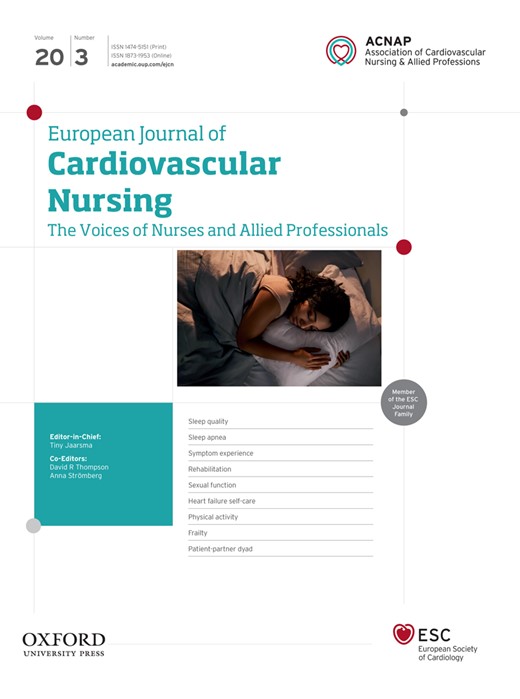
Article Contents
Introduction, distinguishing features of grounded theory, the role and timing of the literature review.
- < Previous
Grounded theory: what makes a grounded theory study?
- Article contents
- Figures & tables
- Supplementary Data
Carley Turner, Felicity Astin, Grounded theory: what makes a grounded theory study?, European Journal of Cardiovascular Nursing , Volume 20, Issue 3, March 2021, Pages 285–289, https://doi.org/10.1093/eurjcn/zvaa034
- Permissions Icon Permissions
Grounded theory (GT) is both a research method and a research methodology. There are several different ways of doing GT which reflect the different viewpoints of the originators. For those who are new to this approach to conducting qualitative research, this can be confusing. In this article, we outline the key characteristics of GT and describe the role of the literature review in three common GT approaches, illustrated using exemplar studies.
Describing the key characteristics of a Grounded theory (GT) study.
Considering the role and timing of the literature review in different GT approaches.
Qualitative research is a cornerstone in cardiovascular research. It gives insights in why particular phenomena occur or what underlying mechanisms are. 1 Over the past 2 years, the European Journal of Cardiovascular Nursing published 20 qualitative studies. 2–21 These studies used methods such as content analysis, ethnography, or phenomenology. Grounded theory (GT) has been used to a lesser extent.
Grounded theory is both a methodology and a method used in qualitative research ( Table 1 ). It is a research approach used to gain an emic insight into a phenomenon. In simple terms, this means understanding the perspective, or point of view, of an ‘insider’, those who have experience of the phenomenon. 22 Grounded theory is a research approach that originated from the social sciences but has been used in education and health research. The focus of GT is to generate theory that is grounded in data and shaped by the views of participants, thereby moving beyond description and towards theoretical explanation of a process or phenomenon. 23
Grounded theory as a method and methodology
One of the key issues with using GT, particularly for novices, is understanding the different approaches that have evolved as each specific GT approach is slightly different.
The tradition of GT began with the seminal text about classic GT written by Glaser and Strauss, 24 but since then GT has evolved into several different types. The approach to GT chosen by the researcher depends upon an understanding of the epistemological underpinnings of the different approaches, the match with the topic under investigation and the researcher’s own stance. Whilst GT is frequently used in applied health research, very few studies detail which GT approach has been used, how and why. Sometimes published studies claim to use GT methodology but the approaches that form the foundation of GT are not reported. This may be due to the word limit in academic journals or because legitimate GT approaches have not been followed. Either way, there is a lack of clarity about the practical application of GT. The purpose of this article is to outline the distinguishing characteristics of GT and outline practical considerations for the novice researcher regarding the place of the literature review in GT.
There are several distinguishing features of GT, as outlined by Sbaraini et al. 25 The first is that GT research is conducted through an inductive process. This means that the researcher is developing theory rather than testing it and must therefore remain ‘open’ throughout the study. In essence, this means that the researcher has no preconceived ideas about the findings. Taking an inductive approach means that the focus of the research may evolve over time as the researchers understand what is important to their participants through the data collection and analysis process.
With regards to data analysis, the use of coding is initially used to break down data into smaller components and labelling them to capture the essence of the data. The codes are compared to one another to understand and explain any variation in the data before they are combined to form more abstract categories. Memos are used to record and develop the researcher’s analysis of the data, including the detail behind the comparisons made between categories. Memos can stimulate the researcher’s thinking, as well as capturing the researcher’s ideas during data collection and analysis.
A further feature for data analysis in a GT study is the simultaneous data analysis and sampling to facilitate theoretical sampling. This means that as data analysis progresses participants are purposefully selected who may have characteristics or experiences that have arisen as being of interest from data collection and analysis so far. Questions in the topic guide may also be modified to follow a specific line of inquiry, test ideas and interpretations, or fill gaps in the analysis to build an emerging substantive theory. This evolving and non-linear methodology is to allow the evolution of the study as indicated by data, rather than analysing at the end of data collection. This approach to data analysis supports the researcher to take an inductive approach as discussed above.
Theoretical sampling facilitates the construction of theory until theoretical saturation is reached. Theoretical saturation is when all the concepts that form the theory being developed are well understood and grounded in data. Finally, the results are expressed as a theory where a set of concepts are related to one another and provide a framework for making predictions. 26 These key features of GT are summarized in Table 2 .
Distinguishing features of a GT study (adapted from Sbaraini et al. 25 )
The identification of a gap in the published literature is typically a requirement of successful doctoral studies and grant applications. However, in GT research there are different views about the role and timing of the literature review.
For researchers using classic Glaserian GT, the recommended approach is that the published literature should not be reviewed until data collection, analysis and theory development has been completed. 24 The rationale for the delay of the literature review is to enable the researcher to remain ‘open’ to discover theory emerging from data and free from contamination by avoiding forcing data into pre-conceived concepts derived from other studies. Furthermore, because the researcher is ‘open’ to whichever direction the data takes they cannot know in advance which aspects of the literature will be relevant to their study. 27
In Glaserian GT, the emerging concepts and theory from data analysis inform the scope of the literature review which is conducted after theory development. 24 This approach to the literature review aligns with the rather positivist stance of Glaser in which the researcher aims to remain free of assumptions so that the theory that emerges from the data is not influenced by the researcher. Reviewing the literature prior to data analysis would risk theory being imposed on the data. Perhaps counterintuitively, Glaser does recommend reading literature in unrelated fields to understand as many theoretical codes as possible. 28 However, it is unclear how this is different to reading literature directly related to the topic and could potentially still lead to the contamination of the theory arising from data that delaying the literature review is intended to avoid. It is also problematic regarding the governance processes around research, whereby funders and ethics committees would expect at least an overview of the existing literature as part of the justification for the study.
A study by Bergman et al. 29 used a classic Glaserian GT approach to examine and identify the motive of power in myocardial infarction patients’ rehabilitation process. Whilst the key characteristics of GT were evident in the way the study was conducted, there was no discussion about how the literature review contributed to the final theory. This may have been due to the word limit but illustrates the challenges that novice researchers may have in understanding where the literature review fits in studies using GT approaches.
In Straussian GT, a more pragmatic approach to the literature view is adopted. Strauss and Corbin 30 recognized that the researcher has prior knowledge, including that of the literature, before starting their research. They did not recommend dissociation from the literature, but rather that the literature be used across the various stages of the research. Published literature could identify important areas that could contribute to theory development, support useful comparisons in the data and stimulate further questions during the analytical process. According to Strauss and Corbin, researchers should be mindful about how published work could influence theory development. Whilst visiting the literature prior to data collection was believed to enhance data analysis, it was not thought necessary to review all the literature beforehand, but rather revisit the literature at later stages in the research process. 30
A study published by Salminen-Tuomaala et al. 31 used a Straussian GT approach to explore factors that influenced the way patients coped with hospitalization for acute myocardial infarction. The authors described a reflexive process in which the researcher noted down their preconceived ideas about the topic as part of the data analysis process. The literature review was conducted after data analysis.
The most recent step in the evolution of GT is the move towards a constructivist epistemological stance advocated by Charmaz. 32 In simple terms, this means that the underlying approach reflects the belief that theories cannot be discovered but are instead constructed by the researcher and their interactions with the participants and data. As the researcher plays a central role in the construction of the GT, their background, personal views, and culture will influence this process and the way data are analysed. For this reason, it is important to be explicit about these preconceptions and aim to maintain an open mind through reflexivity. 32 Therefore, engaging in a preliminary literature review and using this information to compare and contrast with findings from the research undertaken is desirable, alongside completing a comprehensive literature review after data analysis with a specific aim to present the GT.
A study published by Odell et al. 33 used the modified GT approach recommended by Charmaz 32 to study patients’ experiences of restenosis after Percutaneous Coronary Intervention. The authors described the different GT approaches and key features of GT methodology which clearly informed the conduct of the study. However, there was no detail about how the literature review was used to shape the data analysis process and findings.
A solution: be clear on the approach taken to the literature review and why
Despite the clear differences in the approach to the literature review in GT, there appears to be a lack of precise guidance for novice researchers regarding how in depth or exhaustive a preliminary literature review should be. This lack of guidance can lead to a variety of different approaches as evidenced in the GT studies we have cited as examples, which is a challenge for the novice researcher. This uncertainty is further compounded by the concurrent approach to data collection and analysis which allows for the research focus to evolve as the study progresses. The complexity of the research process and the role and timing of the literature review is summarized in Figure 1 .
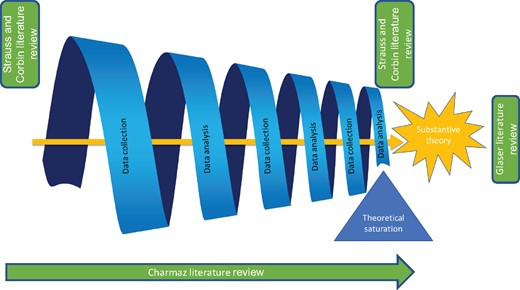
Literature review in Grounded Theory.
Taking a pragmatic approach, researchers will need to familiarize themselves with the literature to receive funding and approval for their study. This preliminary literature review can be followed up after data analysis by a more comprehensive review of the literature to help support the theory that was developed from the data. The key is to ensure transparency in reporting how the literature review has been used to develop the theory. The preliminary literature review can be used to set the scene for the research as part of the introduction, and the more extensive literature review can then be used during the discussion section to compare the theory developed from the data with existing literature, as per Probyn et al. 34
Whilst this pragmatic approach aligns with Straussian GT and Charmaz’s constructivist GT, it is at odds with Glaserian GT. Therefore, if Glaserian GT is chosen, the researcher should be explicit about deviation and provide a rationale.
Word count for journal articles is often a limiting factor in how much detail is included in why certain methodologies are used. Submitting detail about the methodology and rationale behind it can be presented as online supplementary material, thereby allowing interested readers to access further information about how and why the research was executed.
The use of GT as a methodology and method can shed light on areas where little knowledge is already known, generating theory directly from data. The traditional format of a published article does not always reflect the iterative approach to the literature review and data collection and analysis in GT. This can generate tension between how the research is presented in relation to how it was conducted. However, one simple way to ensure clarity in reporting is to be transparent in how the literature review is used.
The authors received no financial support for the research, authorship or publication of this article.
Conflict of interest : The authors declare that there are no conflicts of interest.
Greenhalgh T , Taylor R. Papers that go beyond numbers (qualitative research) . Br Med J 1997 ; 315 : 740 – 743 .
Google Scholar
Wilson RE , Rush KL , Reid RC , et al. The symptom experience of early and late treatment seekers before an atrial fibrillation diagnosis . Eur J Cardiovasc Nurs 2021 ; 20 :231--242.
Lauck SB , Achtem L , Borregaard B , et al. Can you see frailty? An exploratory study of the use of a patient photograph in the transcatheter aortic valve implantation programme . Eur J Cardiovasc Nurs 2021 ; 20 :252--260.
Sundelin R , Bergsten C , Tornvall P , Lyngå, P. et al. Self-rated stress and experience in patients with Takotsubo syndrome: a mixed methods study . Eur J Cardiovasc Nurs 2020 ; doi: 10.1177/1474515120919387.
Janssen DJ , Ament SM , Boyne J , et al. Characteristics for a tool for timely identification of palliative needs in heart failure: the views of Dutch patients, their families and healthcare professionals . Eur J Cardiovasc Nurs 2020 ; doi: 10.1177/1474515120918962.
Steffen EM , Timotijevic L , Coyle A. A qualitative analysis of psychosocial needs and support impacts in families affected by young sudden cardiac death: the role of community and peer support . Eur J Cardiovasc Nurs 2020 ; doi: 10.1177/1474515120922347.
Molzahn AE , Sheilds L , Bruce A , Schick-Makaroff K , Antonio M , Clark AM. Life and priorities before death: a narrative inquiry of uncertainty and end of life in people with heart failure and their family members . Eur J Cardiovasc Nurs 2020 ; 19 : 629 – 637 .
Wistrand C , Nilsson U , Sundqvist A-S. Patient experience of preheated and room temperature skin disinfection prior to cardiac device implantation: a randomised controlled trial . Eur J Cardiovasc Nurs 2020 ; 19 : 529 – 536 .
Widell C , Andréen S , Albertsson P , Axelsson ÅB. Octogenarian preferences and expectations for acute coronary syndrome treatment . Eur J Cardiovasc Nurs 2020 ; 19 : 521 – 528 .
Ferguson C , George A , Villarosa AR , Kong AC , Bhole S , Ajwani S. Exploring nursing and allied health perspectives of quality oral care after stroke: a qualitative study . Eur J Cardiovasc Nurs 2020 ; 19 : 505 – 512 .
Sutantri S , Cuthill F , Holloway A. ‘ A bridge to normal’: a qualitative study of Indonesian women’s attendance in a phase two cardiac rehabilitation programme . Eur J Cardiovasc Nurs 2019 ; 18 , doi: 10.1177/1474515119864208.
Liu X-L , Willis K , Fulbrook P , Wu C-J(J) , Shi Y , Johnson M. Factors influencing self-management priority setting and decision-making among Chinese patients with acute coronary syndrome and type 2 diabetes mellitus . Eur J Cardiovasc Nurs 2019 ; 18 : 700 – 710 .
Wingham J , Frost J , Britten N , Greaves C , Abraham C , Warren FC , Jolly K , Miles J , Paul K , Doherty PJ , Singh S , Davies R , Noonan M , Dalal H , Taylor RS. Caregiver outcomes of the REACH-HF multicentre randomized controlled trial of home-based rehabilitation for heart failure with reduced ejection fraction . Eur J Cardiovasc Nurs 2019 ; 18 : 611 – 620 .
Olsson K , Näslund U , Nilsson J , Hörnsten Å. Hope and despair: patients’ experiences of being ineligible for transcatheter aortic valve implantation . Eur J Cardiovasc Nurs 2019 ; 18 : 593 – 600 .
Heery S , Gibson I , Dunne D , Flaherty G. The role of public health nurses in risk factor modification within a high-risk cardiovascular disease population in Ireland – a qualitative analysis . Eur J Cardiovasc Nurs 2019 ; 18 : 584 – 592 .
Brännström M , Fischer Grönlund C , Zingmark K , Söderberg A. Meeting in a ‘free-zone’: clinical ethical support in integrated heart-failure and palliative care . Eur J Cardiovasc Nurs 2019 ; 18 : 577 – 583 .
Haydon G , van der Riet P , Inder K. Long-term survivors of cardiac arrest: a narrative inquiry . Eur J Cardiovasc Nurs 2019 ; 18 : 458 – 464 .
Freysdóttir GR , Björnsdóttir K , Svavarsdóttir MH. Nurses’ Use of Monitors in Patient Surveillance: An Ethnographic Study on a Coronary Care Unit . London, England : SAGE Publications ; 2019 . p 272 – 279 .
Google Preview
Pokorney SD , Bloom D , Granger CB , Thomas KL , Al-Khatib SM , Roettig ML , Anderson J , Heflin MT , Granger BB. Exploring patient–provider decision-making for use of anticoagulation for stroke prevention in atrial fibrillation: results of the INFORM-AF study . Eur J Cardiovasc Nurs 2019 ; 18 : 280 – 288 .
Instenes I , Fridlund B , Amofah HA , Ranhoff AH , Eide LS , Norekvål TM. ‘ I hope you get normal again’: an explorative study on how delirious octogenarian patients experience their interactions with healthcare professionals and relatives after aortic valve therapy . Eur J Cardiovasc Nurs 2019 ; 18 : 224 – 233 .
Palmar-Santos AM , Pedraz-Marcos A , Zarco-Colón J , Ramasco-Gutiérrez M , García-Perea E , Pulido-Fuentes M. The life and death construct in heart transplant patients . Eur J Cardiovasc Nurs 2019 ; 18 : 48 – 56 .
De Chesnay M , Banner D. Nursing Research Using Grounded Theory: Qualitative Designs and Methods . New York, NY : Springer Publishing Company ; 2015 .
Corbin J , Strauss A. Basics of Qualitative Research: Techniques and Procedures for Developing Grounded Theory . 3rd ed. California : SAGE ; 2007 .
Glaser BG , Strauss AL. The Discovery of Grounded Theory: Strategies for Qualitative Research . New York : Aldine ; 1967 .
Sbaraini A , Carter SM , Evans RW , Blinkhorn A. How to do a grounded theory study: a worked example of a study of dental practices . BMC Med Res Methodol 2011 ; 11 : 128 – 128 .
Charmaz K. ‘ Discovering’ chronic illness: using grounded theory . Soc Sci Med 1990 ; 30 : 1161 – 1172 .
Thornberg R , Dunne C. Literature review in grounded theory. In Bryant A , Charmaz K , eds. The SAGE Handbook of Current Developments in Grounded Theory . London : SAGE Publications ; 2019 .
Glaser BG. Doing Grounded Theory: Issues and Discussions . California : Sociology Press ; 1998 .
Bergman E , Berterö C. ‘ Grasp Life Again’. A qualitative study of the motive power in myocardial infarction patients . Eur J Cardiovasc Nurs 2003 ; 2 : 303 – 310 .
Strauss A , Corbin J. Basics of Qualitative Research: Grounded Theory Procedures and Techniques . 2nd ed. California : Sage ; 1998 .
Salminen-Tuomaala M , Åstedt-Kurki P , Rekiaro M , Paavilainen E. Coping—seeking lost control . Eur J Cardiovasc Nurs 2012 ; 11 : 289 – 296 .
Charmaz K. Constructing Grounded Theory . 2nd ed. Los Angeles : SAGE ; 2014 .
Odell A , Grip L , Hallberg LRM. Restenosis after percutaneous coronary intervention (PCI): experiences from the patients' perspective . Eur J Cardiovasc Nurs 2006 ; 5 : 150 – 157 .
Probyn J , Greenhalgh J , Holt J , Conway D , Astin F. Percutaneous coronary intervention patients’ and cardiologists’ experiences of the informed consent process in Northern England: a qualitative study . BMJ Open 2017 ; 7 : e015127 .
Email alerts
Citing articles via.
- Recommend to Your Librarian
- Advertising and Corporate Services
- Journals Career Network
Affiliations
- Online ISSN 1873-1953
- Print ISSN 1474-5151
- Copyright © 2024 European Society of Cardiology
- About Oxford Academic
- Publish journals with us
- University press partners
- What we publish
- New features
- Open access
- Institutional account management
- Rights and permissions
- Get help with access
- Accessibility
- Advertising
- Media enquiries
- Oxford University Press
- Oxford Languages
- University of Oxford
Oxford University Press is a department of the University of Oxford. It furthers the University's objective of excellence in research, scholarship, and education by publishing worldwide
- Copyright © 2024 Oxford University Press
- Cookie settings
- Cookie policy
- Privacy policy
- Legal notice
This Feature Is Available To Subscribers Only
Sign In or Create an Account
This PDF is available to Subscribers Only
For full access to this pdf, sign in to an existing account, or purchase an annual subscription.
Log in using your username and password
- Search More Search for this keyword Advanced search
- Latest content
- Current issue
- Write for Us
- BMJ Journals More You are viewing from: Google Indexer
You are here
- Volume 19, Issue 2
- What is grounded theory?
- Article Text
- Article info
- Citation Tools
- Rapid Responses
- Article metrics
- Helen Noble 1 ,
- Gary Mitchell 2
- 1 School of Nursing and Midwifery, Queens's University Belfast , Belfast , UK
- 2 Four Seasons Health Care , Belfast , UK
- Correspondence to : Dr Helen Noble , School of Nursing and Midwifery, Queens's University Belfast, Belfast BT9 7BL, UK; Helen.noble{at}qub.ac.uk
https://doi.org/10.1136/eb-2016-102306
Statistics from Altmetric.com
Request permissions.
If you wish to reuse any or all of this article please use the link below which will take you to the Copyright Clearance Center’s RightsLink service. You will be able to get a quick price and instant permission to reuse the content in many different ways.
Introduction
Grounded theory (GT) is a research method concerned with the generation of theory, 1 which is ‘grounded’ in data that has been systematically collected and analysed. 2 It is used to uncover such things as social relationships and behaviours of groups, known as social processes. 3 It was developed in California, USA by Glaser and Strauss during their study—‘Awareness of Dying’. 1 It is a general methodology for developing theory that is grounded in data which is systematically gathered and analysed.
Features of GT
Data collection and analysis occur simultaneously.
Categories and analytic codes developed from data. Pre-existing conceptualisations not to be used—this is known as theoretical sensitivity (see below).
Theoretical sampling used to refine categories.
Abstract categories constructed inductively.
Social processes discovered in the data.
Analytical memos used between coding and writing.
Categories integrated into a theoretical framework. 4
Carrying out a GT study
Theoretical sampling.
Glaser and Strauss (1967) first mentioned theoretical sampling and described a process of generating theory from data which includes collecting the data, then coding and analysing the data. 1 Next the researcher makes a conscious decision about what further detail they feel needs exploring as the new theory develops. It usually takes place after some initial key concepts or categories have been identified, for example, you might decide to interview patients about their experience of heart failure. They may talk about systematic errors occurring in the general practice surgery. From this analysis of the data you may decide to approach and interview GPs to explore their views on patients’ comments. Theoretical sampling therefore, is used to produce more data to endorse or refute the categories that have been identified in the previous analysis. 6
Theoretical sensitivity
Theoretical sensitivity refers to the insight of the researcher. It concerns the researcher being able to give meaning to data, understand what the data says, and being able to separate out what is relevant and what is not. By being theoretically sensitive and using insight, the researcher is able to develop a theory that is grounded, theoretically dense, and cohesive. 7 Sensitivity comes from several sources including (1) literature—in depth reading offers a rich understanding of the phenomena being studied; (2) professional and personal experience—offers an understanding of the events and topics being explored; (3) the analytic process—allows for insight and understanding of the phenomena. 8
Analysis of data in GT
There are three stages of data analysis in GT: 8
Open coding: this involves line by line coding where concepts and key phrases are identified and highlighted and moved into subcategories, then categories. This breaks the data down into conceptual components and the researcher can start to theorise or reflect on what they are reading and understanding—making sense of the data. The data from each participant will be ‘constantly compared’ for similarities.
Axial coding: at this stage relationships are identified between the categories, and connections identified.
Selective coding: this involves identifying the core category and methodically relating it to other categories. The relationships must be authenticated and categories refined. Categories are then integrated together and a GT identified.
Analytical notes are encouraged. These are notes to oneself to explain thought patterns in relation to the data analysis. Final theory is usually generated from the integration of several analytical memos.
The core category
The core category is the chief phenomena around which the categories are built. Theory is generated around a core category. The core category should account for the variation found in the data, that is, the categories will relate to it in some way. The categories demonstrate how the core category is situated in the lives of those participating in the study.
Example of a GT case study
As illustrated, GT methodologies involve the construction of new theory through the analysis of data. In a study carried out by Beech et al , 9 the authors sought to explore patient participant experiences of recovery following surgical intervention for colorectal cancer. Beech et al 9 opted to use GT because previous studies had sought to answer this research question by measuring quantifiable biomedical markers, such as symptoms of pain, insomnia or fatigue. According to the authors, there was a paucity of empirical literature around the topic from a holistic perspective, for example social, psychological and cultural aspects of a person's well-being.
Twelve participants were interviewed four times, over a 1-year period. The authors used theoretical sampling to guide the researcher as data were collected. It helped facilitate the development of theory as it emerged, not once data collection was complete. 1 Initial participants were selected based on ‘subject area’, as is recommended in theoretical sampling. Each had undergone a surgical procedure to remove a tumour in their bowel or rectum and had not received prescribed chemotherapy or radiotherapy. The authors initially asked patient participants to describe their experiences to date.
Data analysis of the interviews was carried out according to the steps described by Strauss and Corbin. 10 The authors began by coding each line of each patient participant transcript. Similar codes were then grouped together to form subcategories and within these subcategories categories were identified. The authors then grouped together the categories to form theory related to patient participant experiences of recovery following surgical intervention for colorectal cancer. The process of data collection continued until each category was saturated and no new data emerged.
Patient participants described their recovery in three phases identified from three categories; disrupting the self, repairing the self and restoring the self. The authors also noted how the process was linear in that all participants went through the stages, for example, phase one began at prediagnosis and ended at the conclusion of surgery; phase two commonly lasted between 3 and 6 months and phase three, from 6 months onwards, was related to a person's fluctuating level of wellness and illness. Notably, these three categories were underpinned by various subcategories, which were generated from initial codes. For example, the second category Beech et al 4 identified, ‘disrupting the self’, was made up of the three subcategories; body repair, autonomy and re-establishing personal identity ( figure 1 ).
- Download figure
- Open in new tab
- Download powerpoint
Grounded theory data analysis.
Importantly, the authors encapsulated the three categories to present a pertinent theory related to patient participant experiences of recovery following surgical intervention for colorectal cancer. They found that recovery is more than physical repair. It is a process of restoring a sense of wellness demonstrated through an awareness and enjoyment of the physical, emotional, social and spiritual aspects of life, in other words, holistic health. 9
By using GT and adhering to this as a research method, a theory will be produced that is grounded in your data. 10 It is a research method which uses strict procedures for data analysis and will enable you to search for and conceptualise the hidden social and collective patterns and constructions in your area of interest.
- Glaser BG ,
- Strauss A ,
- Faithfull S
Competing interests None declared.
Provenance and peer review Not commissioned; internally peer reviewed.
Read the full text or download the PDF:

Grounded Theory

The main characteristic of grounded theory is its inductive reasoning (Glaser & Strauss, 1967). Grounded theory starts with the collection of qualitative data. As researchers review the data collected, repeated ideas, concepts or elements become apparent, and are tagged with codes which have been extracted from the data. As more data is collected, and re-reviewed, codes can be grouped into concepts, and then into categories. These categories may become the basis for a new theory (Glaser, 2002). Grounded theory is particularly useful for the creation of new theories due to its critical perspective. It requires a significant amount of data and can be criticised due to its subjectivity and open ended and process-oriented perspective ending in a narrative description more than a numerical estimation (Oliver, 2011)
Grounded Theory: GO-GN Insights
Virginia Rodés used a qualitative methodology based on the Grounded Theory (together with the Biographical Method and Digital Ethnography) with twelve subjects, teaching staff of three public universities in three Latin American countries (Uruguay, Costa Rica and Venezuela) to understand the dimensions of the adoption of OER and Repositories of OER (ROER) by Latin American universities.
“Grounded theory seeks to give an account of the meaning that actors give to actions, events and objects, which leads to the reasons for their social actions. This through inductive procedures, observing society from within, participating in the construction of categories of understanding both common sense, as members of society, and categories of theoretical understanding, as researchers. What twe incorporate as a problematic object of study and observation are precisely the first level typologies of the social world we are investigating. This means that the categories that the actors use in their current action in the first instance become an object of study and then, a second level observation is done, categorizing the categories that the actors have performed on the first level. The Grounded Theory method moves research and researcher towards the development of theory (Charmaz and Mitchell, 2001). On the contrary, ethnography is based on the development of a complete description of a society or group of people and, therefore, provides the details of their daily lives. As a method, ethnography refers to the ways of studying; Know and inform about the world. According to Charmaz and Mitchell (2001) both grounded theory and ethnography have common roots in the sociology of the Chicago School with its pragmatic philosophical foundations. Since then, Grounded Theory and Ethnography have developed somewhat differently, however these approaches can complement each other. “The Grounded Theory method can expedite fieldwork and move ethnographic research towards theoretical interpretation, while resorting to ethnographic method can prevent studies based on grounded theory from dissolving into “fast and dirty” qualitative research. The biographical methodology gathers people’s experience as they process and interpret it. This revelation of facts and interpretations explicitly or implicitly is filtered by the beliefs, attitudes and values of the protagonist. Through the biographical you can know meanings and contexts of meanings of the individual, as part of the social, or social structures and norms. The subject does not speak of the intimate as his sensation, but speaks of his social “I”. Our methodological approach also integrates the virtual ethnographic method (Hine, 2000), also called digital ethnographic methods, which make use of Internet and digital technologies for the collection and analysis of research data. Digital ethnography allows us to take advantage of the potential that technologies are offering to project knowledge about reality in contemporary society in greater depth, both in terms of the definition of the object of knowledge itself and the methodological design to access it. It is in this sense that digital ethnography techniques are incorporated into the design of my research. Within the framework of high technological availability scenarios, methods of the data collection techniques typical of the ethnographic methodology can be expanded to include web conferences, chat, videoconferences, forums, among others. From the use of this type of resources, digital narratives can be obtained, stories by subjects conceived as spokespersons or social representatives of the groups and communities.”
Hélène Pulker followed Constructivist Grounded Theory methods of data collection and analysis to conduct an inductive qualitative study into the impact of reuse and adaptation of OER among language teachers.
“Regardless of the chosen method, there are no absolute rules or formula for attending to qualitative data analysis or any ways to replicate perfectly the researcher’s analytical thought processes. The available guidelines and suggestions are not rules and therefore each qualitative researcher will have to find their own way through the data. As a result, each qualitative analysis is unique and therefore makes your research original. However, it rely on the researcher’s skills, who constantly has to make judgements and exercise creativity while applying the guidelines. “The analysis depends on the analytical intellect and flair of the researcher and the human factor is the great strength and the fundamental weakness of qualitative enquiry. The great advantage is the flexibility. Throughout my data collection and analysis, I continuously analysed and questioned data through coding, re-coding, comparing codes, and finding sub-categories to arrive at the final analysis. This process allowed me to look for the emergence of unexpected trends and to make connections between the codes. As I observed and questioned the data, it became clear that participants were experiencing OER reuse in different ways. I could identify some similarities across a number of participants and was able to identify three different types of OER users, each having different characteristics. From that point onwards, I was able to explain the categories by comparing data from each type of user’s point of view and I arrived at a more comprehensive analysis of the reuse process that emerged from my study. The robustness of the data analysis lies in the cross comparison of categories and types of user, as I explain in my thesis. “However, the big downside is the complexity of finding your way through the data because there are no preconceived codes or theoretical framework you can rely on. The codes developed in the analysis are largely provisional to start with and very often subject to much change. The principles of interpretative coding are not as straightforward a procedure as I had originally imagined. Coding for meaning is nebulous and has posed challenges. The gradual formation of codes and categories was, in my analysis, rather a tentative process whereby I could see that putting different ‘pieces’ together would yield different meanings. Thus, my experience was often one of going round and round the data. A further contributory factor to the difficulty in deciding on the label for a code was the absence of an overarching framework for looking at the data. In other words, I did not have an overarching view of which cocepts might be included in the schema. I would recommend students who wish to do grounded theory to think about the differences between inductive and deductive analysis and be very sure that they do not want to rely on theoretical framework to start with, because the grounded theory analysis takes a long long time, and when the researcher has possible avenues to explore to start with, it is easier to handle a set of data. I would also recommend the use of a data analysis software, even though the Constructivist grounded theorists advise against this for epistemological reasons.”
Useful references for Grounded Theory: Charmaz (2006); Corbin & Strauss (2015)’ Glaser & Strauss (1967); Glaser (2002); James (2013); Oliver (2011)
Research Methods Handbook Copyright © 2020 by Rob Farrow; Francisco Iniesto; Martin Weller; and Rebecca Pitt is licensed under a Creative Commons Attribution 4.0 International License , except where otherwise noted.
Share This Book
Grounded Theory Institute
- What is GT?
- Mill Valley Seminar May 2012
- Grounded Theory Events
- More GT events
- NY seminar 2008
- Malaysia 2009
- Mill Valley seminar March 09
- Chongqing, China, July 2009
- New York June 2009
- Photos MV October 2009
- Oxford seminar 2010
- June 2010 Mill Valley
- Mill Valley seminar May 2011
- New York Oct-11

- Home ›
What is Grounded Theory?
All research is "grounded" in data, but few studies produce a "grounded theory." Grounded Theory is an inductive methodology. Although many call Grounded Theory a qualitative method, it is not. It is a general method. It is the systematic generation of theory from systematic research. It is a set of rigorous research procedures leading to the emergence of conceptual categories. These concepts/categories are related to each other as a theoretical explanation of the action(s) that continually resolves the main concern of the participants in a substantive area. Grounded Theory can be used with either qualitative or quantitative data.
~~~~~~~~~~~~~~~~~~~~~~~~~~~~~~~~~~~~~~~~~~~~~
Here is an exerpt from one of our GTI Fellows, Olavur Christiansen , explaining the main differences between "classic" or "glaserian" GT, and other methods which call themselves GT.
I have tried to explain this difference by referring to the three "hallmarks" of Glaserian GT. These "hallmarks" are unique for "glaserian GT" and sums up how Glaserian GT is different from the other versions of GT: (1) Many equally justifiable interpretations of the same data? Answer: find the core variable (the main concern and its recurrent solution) as the first stage of the study, and delimit to the core variable (2) To "get through to exactly what is going on in the participant's recurrent solution of their main concern", the researcher suspends his/her preconceptions, remains open, and trusts in "emergence of concepts from the data" (3) Avoiding descriptive interpretations in favor of abstract conceptualizations by the method of constant comparison, which facilitates the discovery of stable patterns in the data (i.e., "emergence of concepts")
~~~~~~~~~~~~~~~~~~~~~~~~~~~~~~~~~~~~~~~~~~~~~~
Here is an excellent outline of the GT process by Odis Simmons :
Proprietary – not for use or distribution without permission of author Composed by: Odis E. Simmons, Ph.D. Stages of a Classic (Glaserian) Grounded Theory Study:Stages are generally sequential, but once research process begins they are often conducted simultaneously, as the particular research requires.
1. Preparation : Minimizing preconceptions. No preliminary literature review. General research topic, but no predetermined research “problem.”
2. Data Collection: Most common form: intensive interviews, often combined with participant observation. But, any type of data can be used, including quantitative. Theoretical Sampling
Initial analysis determines where to go and what to look for next in data collection. Analysis and data collection continually inform one another.
3. Analysis: Constant Comparative Analysis Relating data to ideas, then ideas to other ideas.
Substantive Coding
Substantive codes summarize empirical substance. Have grab, relevance, and fit.
Sensitizing concepts: Are “accessible” through imagery, humor, irony.
In vivo concepts: concepts inherent to action scene (e.g. milkman’s “coffee stop”).
Open Coding
Coding for anything and everything. The analyst asks three general questions of the data:
A. "What is this data a study of?" Leads to discovery of the “core variable.” The core variable becomes the focus of the research and theory. The core variable is the variable which accounts for the most variation (e.g. Milkman’s “cultivating relationships”)
B. "What category does this incident indicate?"
C. "What is actually happening in the data?"
Selective Coding
Usually occurs when core variable and major dimensions and properties have been discovered. Closed coding involves limiting the coding to things related to the core variable.
Theoretical Coding
Theoretical codes conceptualize how the substantive codes may relate to each other as hypotheses to be integrated into the theory (see Glaser’s “theoretical coding families”).
4. Memoing: Memos are the theorizing write-up of ideas about codes and their relationships.
Data collection, analysis and memoing are ongoing, and overlap.
Memoing should take precedence, because it is the actual write-up of what is emerging from the data and the analysis. Data is always available, and can be analyzed at any time. Ideas are fragile. They should be written down at the earliest possible time.
While writing memos, think and write theoretically, in a "stream of consciousness" fashion, with no concerns about grammar, spelling, and such.
This minimizes writers block.
Memos are always modifiable as you discover more about your topic.
Integrating the Literature
Once you are confident in your theory, you can begin to analyze and integrate relevant existing literature into it. Theoretical material from the literature must earn its way into your theory, just like any other theoretical construct.
5. Sorting & Theoretical Outline :Sorting refers not to data sorting, but to conceptual sorting of memos into an outline of the emergent theory, showing relationships between concepts. This process often stimulates more memos, and sometimes even more data collection. 6. Writing:
The completed sort constitutes the first draft of your write-up. From here it is merely a matter of refining and polishing your product into a final draft.

Practical Guide to Grounded Theory Research
What is grounded theory? | When should you use grounded theory? | Benefits | Limitations | History | Steps for grounded theory | Tools for grounded theory coding | Grounded theory software | Start free trial
What is grounded theory?
Grounded theory is a qualitative method that enables you to study a particular phenomenon or process and discover new theories that are based on the collection and analysis of real world data.
Unlike traditional hypothesis-deductive approaches of research, where you come up with a hypothesis and then try to prove/disprove it, grounded theory is an inductive approach where new theories are derived from the data.
The process of data collection, data analysis, and theory development happen in an iterative process. Iterative data collection and analysis occurs until you reach theoretical saturation, the point at which additional data adds no additional insight into your new theory.
Learn more about grounded theory on Delve’s YouTube Channel.
When should you use grounded theory?
You should consider using grounded theory when there is no existing theory that offers an explanation for a phenomenon that you are studying. It can also be used if there is an existing theory, but it is potentially incomplete as the data used to derive that theory wasn’t collected from the group of participants that you plan on researching.
Benefits of using grounded theory
Findings accurately represent real world settings.
The theories you develop using grounded theory are derived directly from real world participants in real world settings using methods like in depth interviews and observation, so your findings will more accurately represent the real world. This is in contrast to other research approaches that occur in less natural settings like research labs or focus group tables.
Findings are tightly connected to the data
Because grounded theory primarily relies on collected data to determine the final outcome, the findings are tightly connected to that data. This is in contrast to other research approaches that rely more heavily on external research frameworks or theories that are further removed from the data.
Great for new discoveries
Grounded theory is a strong, inductive research method for discovering new theories. You don’t go in with any preconceived hypothesis about the outcome, and are not concerned with validation or description. Instead, you allow the data you collect to guide your analysis and theory creation, leading to novel discoveries.
Offers strategies for analysis
The process of grounded theory describes specific strategies for analysis that can be incredibly helpful. While grounded theory is a very open ended methodology, the analysis strategies enable you to stay structured and analytical in your discovery process.
Data collection and analysis are streamlined
Data collection and analysis are tightly interwoven. As you collect data, you analyze it, and as you learn from analysis, you continue to collect more data. This helps ensure that the data you collect is sufficient enough to explain the findings that arise from analysis.
Buffers against confirmation bias
Because data collection and analysis are tightly interwoven, you are truly following what is emerging from the data itself. This provides a great buffer against confirming preconceived beliefs about your topic.
Download Free Grounded Theory Guide
Want to learn how to do Grounded Theory? Submit your email to request our free grounded theory guide with tips on how to get started with your own thematic analysis.
Thank you! Check your email for your Grounded Theory Guide!
Limitations of grounded theory
Difficulty recruiting.
Grounded theory relies on an iterative recruiting process called theoretical sampling where you continuously recruit and conduct new rounds of interviews with new participants and previous participants while you analyze data. The recruiting criteria also evolves and changes based on what you learn. Because the recruiting is not predefined, it can be challenging to continuously find the right participants for your study.
Time consuming to collect data
There is no way to know ahead of time how much data you will need to collect, so you need to be flexible with your time. With grounded theory, you continuously collect and analyze data until you reach theoretical saturation, which is the point at which new data does not contribute new insight to your evolving theory. This means that you are likely to conduct many rounds of data collection before your theory is complete.
Challenges in analysis
Data analysis occurs on a rolling basis and involves making constant comparisons between different excerpts of data. It can be challenging to keep track of your comparisons and findings as you go. It can be helpful to use a qualitative data analysis software like Delve to help you stay organized during your analysis.
History of grounded theory

Grounded Theory (GT) was first developed by Sociologist Barney Glaser and Anselm Strauss. During this period, they criticized the predominant approach to qualitative research, which they found to be very limited. Qualitative studies at this time were following traditional methods which basically involved coming up with a hypothesis and conducting research to validate it.
Glaser and Strauss pioneered a new methodology for discovering theory by taking an inductive approach to qualitative research. They formally presented their newly developed research method by publishing Discovery of Grounded Theory: Strategies for qualitative research (1967).
Since then, various evolutions of grounded to theory emerged, including Basics of Qualitative Research: Grounded Theory Procedures and Techniques (1990) by Strauss and Corbin. This shifted from the concept of the natural emergence of theory by designing an analytical coding framework for generating theories from data systematically.
In 1990s, Kathy Charmaz published a new approach called constructivist grounded theory , and argued that neither data nor theories are discovered but are constructed through the researchers' past and present experiences.
Read more about the history of grounded theory here.
Watch Webinar
See the step by step process of grounded theory.
How do you do grounded theory research.
This is an overview of how you can approach the process of grounded theory. Know that this isn’t the only way to approach grounded theory, but just a collection of tips and processes derived from various grounded theory resources that you can use to inspire your own grounded theory study.
Note: We adjusted some terminology and language from the original grounded theory papers in order to make this guide as practical as possible for anybody aiming to use grounded theory with qualitative data analysis software. If you wish to gain more depth in your grounded theory knowledge, we highly encourage you to read the original papers from Glaser, Strauss, Corbin and Charmaz, which we link to in the references at the bottom of this page.
Steps for grounded theory
Determine initial research questions
Recruit and collect data (theoretical sampling)
Break transcripts into excerpts (open coding)
Group excerpts into codes (open coding)
Group codes into categories (axial coding)
Analyze more excerpts and compare with codes
Repeat steps 2-6 until you reach theoretical saturation
Define the central idea (selective coding)
Write your grounded theory
Note: Approach your research iteratively
Grounded theory is not a linear process where you collect data, analyze it, and then you’re done. It is an iterative research methodology that involves cycling through the steps iteratively. Part of what made Grounded Theory revolutionary was that it mixed data collection with analysis. It emphasized going back to the field even after conducting some analysis. You will recruit some participants, gather data and analyse it, and go back into the field again with a different recruiting strategy and focus of inquiry. Then you’ll incorporate those findings into further rounds of analysis. Grounded theory is deliberately cyclical in nature.
1. Determine initial research questions
Start off with your initial research questions. Have an idea for what phenomenon you are trying to explain. These initial questions will help guide your first steps in recruiting and data analysis but know that the questions may evolve as you observe and learn more from the data you collect.
2. Recruit and collect data using theoretical sampling
With grounded theory, recruiting participants is iterative. Instead of pre-determining a specified recruiting criteria ahead of time, you will practice what is called theoretical sampling. With theoretical sampling, you start with recruiting a small group of participants loosely based on your initial research questions.
Once you have some data, such as recordings from in depth interviews, prepare that data for analysis by turning them into transcripts .
After you do some initial analysis of that data, which we detail in the following steps, you use what you learned from that analysis to determine who to recruit next.
Read more about how to do theoretical sampling here.
3. Break up transcripts into excerpts using open coding
After you have collected some data, such as transcriptions from interviews*, you can begin open coding. Open coding is when you take your transcripts, and break it into individual excerpts. Then, take the excerpts and continuously compare and contrast them with other excerpts This act of comparison is part of a core grounded theory method called constant comparative method , which you will use throughout various phases of your analysis.
Notice similarities and differences between excerpts.
Compare different excerpts from the same person
Compare similar excerpts that occur between different people
Compare different peoples’ experiences within similar excerpts
Compare excerpts as they differ from one day to the next
For example, in a study about the COVID-19 lockdown in New York City, you may read an excerpt that describes a person having trouble sleeping. You should take that excerpt and compare that to other people who also experienced trouble sleeping. Take notice of any similarities or differences between those experiences.
*For the purpose of this article we will refer to collected data as ‘interview transcripts’ and ‘transcript excerpts’, but you can use any type of qualitative data such as observations, notes, etc.
Read more about open coding here.
Reflect on thoughts and contradictions by writing grounded theory memos during analysis
Reflect on your analytical thoughts and write them down in the form of memos. Think of memos as your “notes to self” to record your train of thought, and to keep a record of your reflections. These notes are an essential part of conducting grounded theory research and serve several important purposes:
Memo writing in grounded theory helps track your thought process: Analytical memos allow you to keep track of your thought process as you work through the data. They capture initial impressions, hunches, and emerging themes, which can help develop your coding scheme later on.
They promote reflexivity: Memos encourage you to reflect on any biases, assumptions, and preconceptions. By bracketing yourself, you are able to acknowledge how your own experiences and perspectives may be influencing your analysis.
They facilitate collaboration: Memos can be shared with other researchers to facilitate collaboration and improve inter-code reliability . By adding memos with tools like Delve’s memo feature , you can also streamline peer debriefing to improve the overall credibility of your research.
They support the development of theory: Memos are an important tool for developing theory in grounded theory research. By tracking emerging themes and patterns in memos, you can often develop more abstract concepts and theories that are grounded in the data.
In the end, memos are an intrinsic part of grounded theory research. They help you track your thought process, promote reflexivity, facilitate collaboration, and support the development of theory.
Learn more about analytical memos here.
4. Group excerpts together into codes using open coding
As you make comparisons between excerpts of data, look for sets of excerpts that represent the same central idea or concept, and group them together. You can use a “code” to encapsulate these groups of excerpts. Codes are like tags or labels that are assigned to excerpts of text.
For example, suppose you were comparing these excerpts:
“I just kept watching the news, even late into the night. And found myself having a harder and harder time falling asleep”
“Definitely was experiencing insomnia for a while…”
“I was so worried. The thoughts kept spinning in my head and I’d lay there with my eyes open for hours”
All of these represent the concept of “trouble sleeping”. So if you are using qualitative data analysis software, you can create a code called “trouble sleeping” and bring all of these excerpts under the code “trouble sleeping”.
Once you have a code called “trouble sleeping”, all future excerpts that you analyze should not only be compared to other excerpts, but they should also be compared to the code “trouble sleeping”, and any other code that you have.
Qualitative analysis doesn't have to be overwhelming
Take delve's free online course to learn how to find themes and patterns in your qualitative data. get started here..
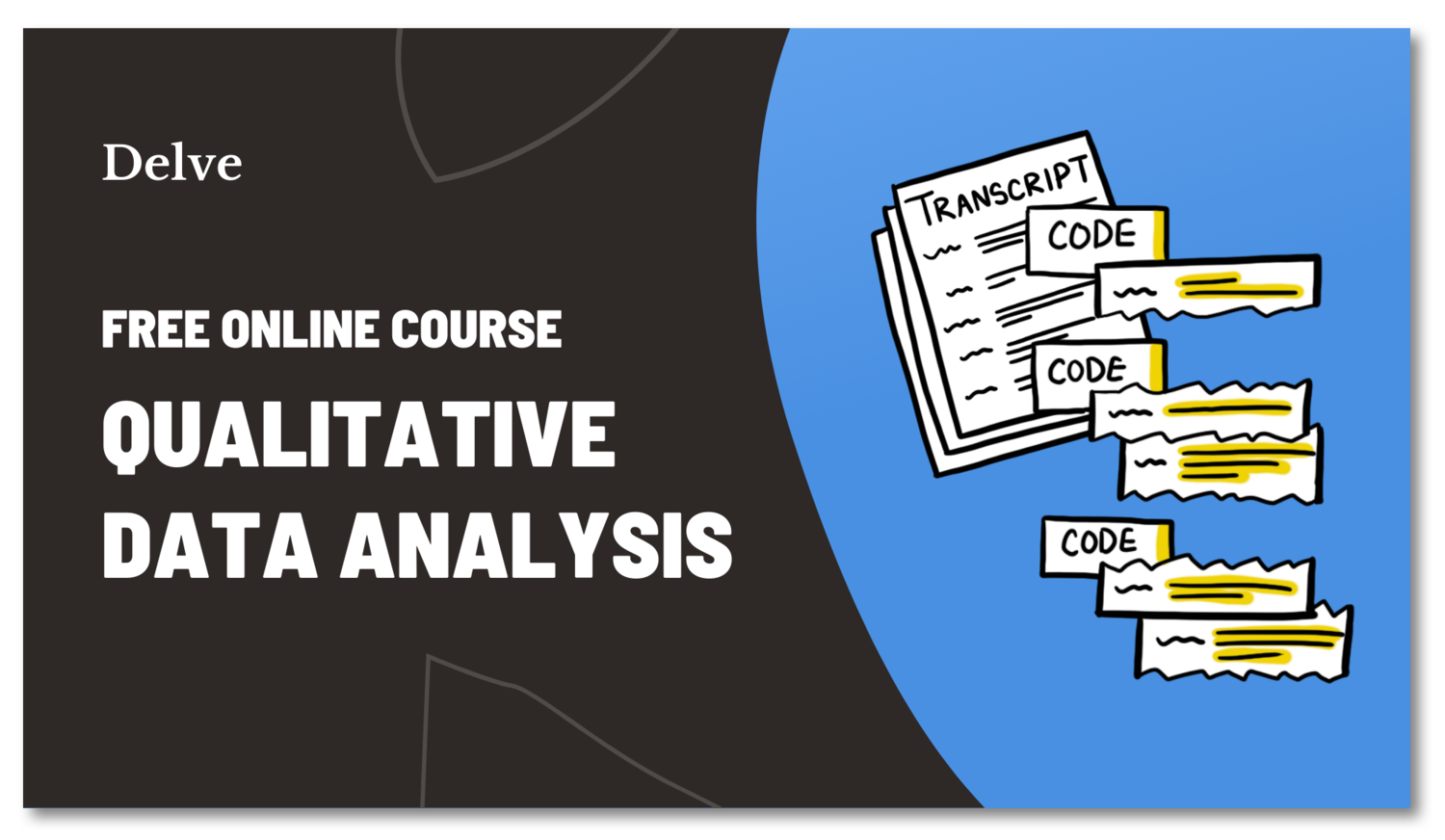
5. Group codes into categories using axial coding
As you gradually develop a list of codes that bring together sets of excerpts, you should also begin to also compare codes with other codes. When you find connections between multiple codes, you can group them together into a ‘category’. This step of grounded theory is called ‘axial coding’, where you find the axes that connect various codes together. If you are using qualitative data analysis software, these categories are represented by a series of ‘nested codes’ which are stacked in a hierarchy.
For example, in the previous step, we had a code called “trouble sleeping”. Suppose you also had another code, “experiencing panic attacks”. You may find that there is a relationship between these 2 codes and they can be grouped under a category called “Reacting negatively to the pandemic with anxiety”. In qualitative data analysis software, this hierarchy would look like this:
[Reacting negatively to the pandemic with anxiety]
[Trouble sleeping]
[Experiencing panic attacks]
If you would like a more structured approach to finding ways to group codes together, you can learn more about Corbin and Strauss’s coding paradigm, which you can read more about here.
6. Analyze more excerpts using constant comparative method
Remember, grounded theory is a cyclical process! Even after you have created lists of codes, and grouped codes into categories, you should continue to analyze additional interview transcripts, and compare the new excerpts to your existing codes categories. Read more about constant comparative method here.
As you make comparisons between your new excerpts to your codes and categories, your excerpts will generally do one of three things: contradict, expand upon, or support your existing codes and categories. Here’s what you should consider in each scenario:
Contradiction: If your new excerpt contradicts a code, this may be a sign that you need to adjust that code or change it. It likely also means that you need to go back to step 2 and conduct more rounds of data collection through theoretical sampling to help explain the contradiction. Read more about how to handle contradictions in our article on negative case analysis.
Expansion: If your new excerpt expands upon your code, either by adding more description or explaining more facets of your code, this is a good sign that you are continuing to learn more and it means that you should continue to collect and analyze data until your new excerpts simply support your codes rather than expand upon them.
Support: If your new excerpt generally supports your code without adding additional information, this means that you may have reached theoretical saturation, which is the point at which more excerpts do not contribute any additional insight into your codes and you can move onto a later stage of your research.
With grounded theory, your goal is not to code or keep track of everything that occurs in every excerpt. For example, once you establish the category that people under COVID-19 lockdown were [Reacting negatively to the pandemic with anxiety], you don’t need to go back and code every single excerpt that refers to that category. However, if you come across an excerpt where a person did not [ react negatively to the pandemic with anxiety], this may open the doors to expanding upon or changing your category.
7. Continue collecting data and analyzing until you reach theoretical saturation
With these iterative steps, when do you know that you have analyzed enough? How do you know when you should stop recruiting or analyzing additional data?
With grounded theory, you want to continue until you reach the point where additional transcript excerpts do not expand upon your codes and categories. In other words, if you are learning the same thing over and over again even with additional excerpts, that means that your codes and categories have become ‘theoretically saturated’. The excerpts you have collected so far address all relevant aspects of your codes and categories and there is no need to pursue further data collection or analysis for your particular codes and categories.
8. Define the core category using selective coding
Once you feel you have reached theoretical saturation in your codes and categories so far, it is time to pull your findings together with selective coding. With selective coding, you connect all your codes and categories together under one core category.
This core category represents the central thesis of your research, and is the core idea behind your theory. This core category can be an existing category that you derived earlier, or it can be a new category that you derive from all your existing findings so far.
This core category will be the basis for your new grounded theory.
For example, if you have a list of categories like
[Feeling loneliness during lockdown]
[Virtual and in person socializaton]
[Mental health pre-COVID-19]
[Current housing set up not suited for lockdown]
You may use selective coding to define the central, core category as [Access to lockdown suitable housing, mitigated COVID-19 Anxiety during lockdown], to link all your existing categories together.
Learn more about selective coding here .
9. Write your grounded theory
Once you have determined your core category through selective coding, and are confident that you have reached theoretical saturation, it is time to construct your new theory. Gather together your coded data, and series of memos and use them to describe your new theory.
State your new theory in just a couple words or sentences
Define the limits or boundary of your theory
Summarize and write a description of your theory
Use your coded data to validate the points you suggest in your theory
Write an accurate statement of what was studied, and construct your theory in a form that other researchers can use.
Learn how to discover new theories based on the collection and analysis of real-world qualitative data in this free webinar.
Watch webinar.
Grounded theory vs. grounded theory lite
The goal of grounded theory is to develop a formal theory, a set of interrelated concepts that explain a particular phenomenon. The process tends to be both time and resource intensive.
Pidgeon & Henwood (1997) refer to this intensive theory-building process as “full grounded theory.” They argue that many researchers who claim to use grounded theory in their research actually apply a simplified version, which they refer to as "grounded theory lite.”
What is grounded theory lite?
Grounded theory lite is a shortened, more “pragmatic approach to grounded theory” that focuses on gaining a preliminary understanding of a topic. It involves developing categories and concepts and understanding their relationships, without the need to generate formal theory.
Here are some of the key features of grounded theory lite:
It is a less rigorous approach to grounded theory.
It does not require the development of a formal theory.
It can be completed in a shorter period of time.
It is often used in smaller research projects.
This table summarizes the key differences between grounded theory and grounded theory lite:
In other words, grounded theory lite is a more common approach to grounded theory, and it is often used when time or resources are limited. It is a less rigorous approach than full grounded theory, but it can still be a valuable tool for developing a preliminary understanding of a topic.
Here are some examples of when grounded theory lite might be used:
A small-scale research project that is limited by time or resources.
A research project that is exploratory in nature.
A research project that is used to generate hypotheses for further research.
The difference between grounded theory and grounded theory lite is mostly semantic as researchers tend to use the terms interchangeably. However, it helps to understand that both exist and that the main difference relates to formal theory development.
Tools for grounded theory coding
You can do your grounded theory coding by hand, using word processors and spreadsheets such as Microsoft Word and Microsoft Excel, or use Computer Assisted Qualitative Data Analysis Software such as Delve . There are pros and cons to each approach, and you should choose one based off what is most appropriate for your research. Read more about how to code qualitative data.
Try Delve, Software for Qualitative Coding
Grounded theory coding using pen and paper.
You can use simple tools like pen, paper, scissors, and highlighters to code by hand. Just print out your transcripts, and do open coding by cutting up the transcripts into individual excerpts. The next steps are done by organizing those papers into piles, as you create your codes and categories.
This is a great way to organize data with your hands, but can be come very time consuming, especially with large data sets. And it can be challenging to keep track of your comparisons since you’d have to keep track of all your sheets of paper.
Grounded theory coding using a word processor
If you decide to use a word processor such as Microsoft Word or Google Docs, do your open coding round by highlighting excerpts. You can then code by adding comments to those excerpts. To create category, copy and paste excerpts into different documents labeled by the category name. This is a good way to keep your analysis in a digital format, but can feel cumbersome to continually copy and paste your
Grounded theory coding using qualitative data analysis software

Software such as the Delve qualitative data analysis software are designed to support processes like grounded theory. You can use Delve to help keep track of your excerpts and codes, and organize your thoughts as you do constant comparisons. The digital interface will help you manage large data sets and keep track of the many comparisons you will do. Additional features such as demographic filters and the ability to search across transcripts can also help streamline your grounded theory process.
Use Grounded Theory Software
Delve qualitative analysis tool is the best choice for grounded theory..
Make your life easier while doing grounded theory by using grounded theory software like Delve .
Codes and categories are constantly evolving during the grounded theory analysis process. Using pen and paper or spreadsheets to analyze qualitative data can get unwieldy and chaotic. In contrast, qualitative data analysis software like Delve helps you make sense of the mess and focus on finding your insights.
And don’t just take our word for it. Here’s what researchers say about using Delve:
“Being able to see and easily access all of my codes in one place was especially gratifying after finishing the process of coding and made data analysis much easier and more efficient. ” Noah W.
“Delve has made coding qualitative data so simple and fast. The user-friendliness makes it a must-have for any qualitative researcher” Khotso M.
“Delve was easy to use. I used it for my doctoral research and it helped me to organize my interview information into codes and categories.” David S.
Try the Delve Software for Qualitative Coding
Online software such as Delve can help streamline how you’re coding your qualitative coding. Try a free trial or watch a demo of Delve.
Corbin, J., & Strauss, A. (1990). Grounded theory research: Procedures, canons, and evaluative criteria. Qualitative Sociology, 13, 3-21.
Charmaz, Kathy (2006). Constructing Grounded Theory: A practical guide through Qualitative Analysis. Thousand Oaks, California: Sage.
Glaser, B. G., & Strauss, A. L. (1967). The Discovery of Grounded Theory: Strategies for Qualitative Research .
Pidgeon, N., & Henwood, K. (1997). Using grounded theory in psychological research. In N. Hayes (Ed.), Doing qualitative analysis in psychology Press/Erlbaum (UK) Taylor & Francis.
Cite this blog post:
Delve, Ho, L., & Limpaecher, A. (2021, September 17). The Practical Guide to Grounded Theory . Practical Guide to Grounded Theory Research. https://delvetool.com/groundedtheory

Want to create or adapt books like this? Learn more about how Pressbooks supports open publishing practices.
18.6 Grounded theory analysis
Learning objectives.
Learners will be able to…
- Explain defining features of grounded theory analysis as a strategy for qualitative data analysis and identify when it is most effectively used
- Formulate an initial grounded theory analysis plan (if appropriate for your research proposal)
What are you trying to accomplish with grounded theory analysis
Just to be clear, grounded theory doubles as both qualitative research design (we will talk about some other qualitative designs in Chapter 22) and a type of qualitative data analysis. Here we are specifically interested in discussing grounded theory as an approach to analysis in this chapter. With a grounded theory analysis , we are attempting to come up with a common understanding of how some event or series of events occurs based on our examination of participants’ knowledge and experience of that event. Let’s consider the potential this approach has for us as social workers in the fight for social justice. Using grounded theory analysis we might try to answer research questions like:
- How do communities identity, organize, and challenge structural issues of racial inequality?
- How do immigrant families respond to threat of family member deportation?
- How has the war on drugs campaign shaped social welfare practices?
In each of these instances, we are attempting to uncover a process that is taking place. To do so, we will be analyzing data that describes the participants’ experiences with these processes and attempt to draw out and describe the components that seem quintessential to understanding this process.
Variations in the approach
Differences in approaches to grounded theory analysis largely lie in the amount (and types) of structure that are applied to the analysis process. Strauss and Corbin (2014) [1] suggest a highly structured approach to grounded theory analysis, one that moves back and forth between the data and the evolving theory that is being developed, making sure to anchor the theory very explicitly in concrete data points. With this approach, the researcher role is more detective-like; the facts are there, and you are uncovering and assembling them, more reflective of deductive reasoning . While Charmaz (2014) [2] suggests a more interpretive approach to grounded theory analysis, where findings emerge as an exchange between the unique and subjective (yet still accountable) position of the researcher(s) and their understanding of the data, acknowledging that another researcher might emerge with a different theory or understanding. So in this case, the researcher functions more as a liaison, where they bridge understanding between the participant group and the scientific community, using their own unique perspective to help facilitate this process. This approach reflects inductive reasoning .
Coding in grounded theory
Coding in grounded theory is generally a sequential activity. First, the researcher engages in open coding of the data. This involves reviewing the data to determine the preliminary ideas that seem important and potential labels that reflect their significance for the event or process you are studying. Within this open coding process, the researcher will also likely develop subcategories that help to expand and provide a richer understanding of what each of the categories can mean. Next, axial coding will revisit the open codes and identify connections between codes, thereby beginning to group codes that share a relationship. Finally, selective or theoretical coding explores how the relationships between these concepts come together, providing a theory that describes how this event or series of events takes place, often ending in an overarching or unifying idea tying these concepts together. Dr. Tiffany Gallicano [3] has a helpful blog post that walks the reader through examples of each stage of coding. Table 18.13 o ffers an example of each stage of coding in a study examining experiences of students who are new to online learning and how they make sense of it. Keep in mind that this is an evolving process and your document should capture this changing process. You may notice that in the example “Feels isolated from professor and classmates” is listed under both axial codes “Challenges presented by technology” and “Course design”. This isn’t an error; it just represents that it isn’t yet clear if this code is most reflective of one of these two axial codes or both. Eventually, the placement of this code may change, but we will make sure to capture why this change is made.
Constant comparison
While ground theory is not the only approach to qualitative analysis that utilizes constant comparison, it is certainly widely associated with this approach. Constant comparison reflects the motion that takes place throughout the analytic process (across the levels of coding described above), whereby as researchers we move back and forth between the data and the emerging categories and our evolving theoretical understanding. We are continually checking what we believe to be the results against the raw data. It is an ongoing cycle to help ensure that we are doing right by our data and helps ensure the trustworthiness of our research. Ground theory often relies on a relatively large number of interviews and usually will begin analysis while the interviews are ongoing. As a result, the researcher(s) work to continuously compare their understanding of findings against new and existing data that they have collected.
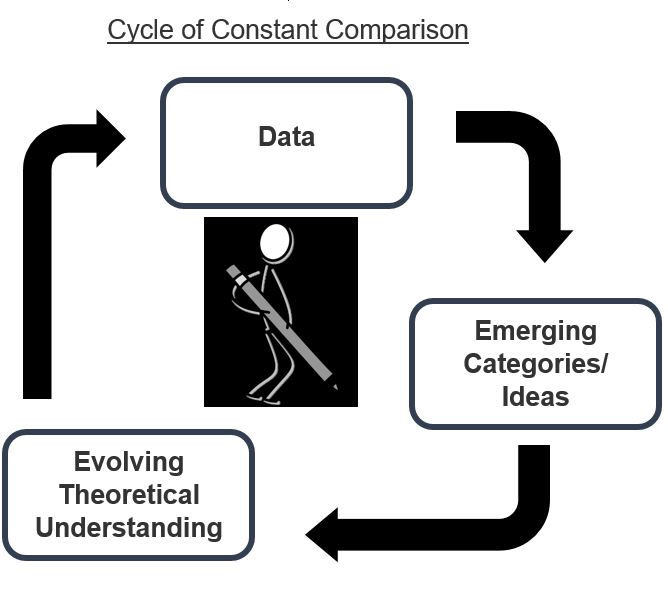
Developing your theory
Remember, the aim of using a grounded theory approach to your analysis is to develop a theory, or an explanation of how a certain event/phenomenon/process occurs. As you bring your coding process to a close, you will emerge not just with a list of ideas or themes, but an explanation of how these ideas are interrelated and work together to produce the event you are studying. Thus, you are building a theory that explains the event you are studying that is grounded in the data you have gathered.
Thinking about power and control as we build theories
I want to bring the discussion back to issues of power and control in research. As discussed early in this chapter, regardless of what approach we are using to analyze our data we need to be concerned with the potential for abuse of power in the research process and how this can further contribute to oppression and systemic inequality. I think this point can be demonstrated well here in our discussion of grounded theory analysis. Since grounded theory is often concerned with describing some aspect of human behavior: how people respond to events, how people arrive at decisions, how human processes work. Even though we aren’t necessarily seeking generalizable results in a qualitative study, research consumers may still be influenced by how we present our findings. This can influence how they perceive the population that is represented in our study. For example, for many years science did a great disservice to families impacted by schizophrenia, advancing the theory of the schizophrenogenic mother [4] . Using pseudoscience , the scientific community misrepresented the influence of parenting (a process), and specifically the mother’s role in the development of the disorder of schizophrenia. You can imagine the harm caused by this theory to family dynamics, stigma, institutional mistrust, etc. To learn more about this you can read this brief but informative editorial article by Anne Harrington in the Lancet . [5] Instances like these should haunt and challenge the scientific community to do better. Engaging community members in active and more meaningful ways in research is one important way we can respond. Shouldn’t theories be built by the people they are meant to represent?
Key Takeaways
- Ground theory analysis aims to develop a common understanding of how some event or series of events occurs based on our examination of participants’ knowledge and experience of that event.
- Using grounded theory often involves a series of coding activities (e.g. open, axial, selective or theoretical) to help determine both the main concepts that seem essential to understanding an event, but also how they relate or come together in a dynamic process.
- Constant comparison is a tool often used by qualitative researchers using a grounded theory analysis approach in which they move back and forth between the data and the emerging categories and the evolving theoretical understanding they are developing.
Resources for learning more about Grounded Theory
Chun Tie, Y., Birks, M., & Francis, K. (2019). Grounded theory research: A design framework for novice researchers .
Gibbs, G.R. (2015, February 4). A discussion with Kathy Charmaz on Grounded Theory .
Glaser, B.G., & Holton, J. (2004, May). Remodeling grounded theory .
Mills, J., Bonner, A., & Francis, K. (2006). The development of Constructivist Grounded Theory .
A few exemplars of studies employing Grounded Theory
Burkhart, L., & Hogan, N. (2015). Being a female veteran: A grounded theory of coping with transitions .
Donaldson, W. V., & Vacha-Haase, T. (2016). Exploring staff clinical knowledge and practice with LGBT residents in long-term care: A grounded theory of cultural competency and training needs .
Vanidestine, T., & Aparicio, E. M. (2019). How social welfare and health professionals understand “Race,” Racism, and Whiteness: A social justice approach to grounded theory .
- Corbin, J., & Strauss, A. (2014). Basics of qualitative research: Techniques and procedures for developing grounded theory . Sage publications. ↵
- Charmaz, K. (2014). Constructing grounded theory . Sage Publications ↵
- Gallicano, T. (2013, July 22). An example of how to perform open coding, axial coding and selective coding. [Blog post]. https://prpost.wordpress.com/2013/07/22/an-example-of-how-to-perform-open-coding-axial-coding-and-selective-coding/ ↵
- Harrington, A. (2012). The fall of the schizophrenogenic mother. The Lancet, 379 (9823), 1292-1293. ↵
A form of qualitative analysis that aims to develop a theory or understanding of how some event or series of events occurs by closely examining participant knowledge and experience of that event(s).
starts by reading existing theories, then testing hypotheses and revising or confirming the theory
a paradigm based on the idea that social context and interaction frame our realities
when a researcher starts with a set of observations and then moves from particular experiences to a more general set of propositions about those experiences
Part of the qualitative data analysis process where we begin to interpret and assign meaning to the data.
An initial phase of coding that involves reviewing the data to determine the preliminary ideas that seem important and potential labels that reflect their significance.
Axial coding is phase of qualitative analysis in which the research will revisit the open codes and identify connections between codes, thereby beginning to group codes that share a relationship.
Selective or theoretical coding is part of a qualitative analysis process that seeks to determine how important concepts and their relationships to each other come together, providing a theory that describes the focus of the study. It often results in an overarching or unifying idea tying these concepts together.
Constant comparison reflects the motion that takes place in some qualitative analysis approaches whereby the researcher moves back and forth between the data and the emerging categories and evolving understanding they have in their results. They are continually checking what they believed to be the results against the raw data they are working with.
Trustworthiness is a quality reflected by qualitative research that is conducted in a credible way; a way that should produce confidence in its findings.
claims about the world that appear scientific but are incompatible with the values and practices of science
Doctoral Research Methods in Social Work Copyright © by Mavs Open Press. All Rights Reserved.
Share This Book

Saturn’s ocean moon Enceladus is able to support life − my research team is working out how to detect extraterrestrial cells there
Postdoctoral Scholar in Earth and Space Sciences, University of Washington
Disclosure statement
Fabian Klenner is an affiliate of the Europa Clipper mission (SUrface Dust Analyzer instrument). He receives funding from NASA.
University of Washington provides funding as a member of The Conversation US.
View all partners
Saturn has 146 confirmed moons – more than any other planet in the solar system – but one called Enceladus stands out. It appears to have the ingredients for life.
From 2004 to 2017, Cassini – a joint mission between NASA, the European Space Agency and the Italian Space Agency – investigated Saturn, its rings and moons. Cassini delivered spectacular findings . Enceladus, only 313 miles (504 kilometers) in diameter, harbors a liquid water ocean beneath its icy crust that spans the entire moon.
Geysers at the moon’s south pole shoot gas and ice grains formed from the ocean water into space.
Though the Cassini engineers didn’t anticipate analyzing ice grains that Enceladus was actively emitting, they did pack a dust analyzer on the spacecraft. This instrument measured the emitted ice grains individually and told researchers about the composition of the subsurface ocean.
As a planetary scientist and astrobiologist who studies ice grains from Enceladus, I’m interested in whether there is life on this or other icy moons. I also want to understand how scientists like me could detect it.
Ingredients for life
Just like Earth’s oceans, Enceladus’ ocean contains salt , most of which is sodium chloride , commonly known as table salt. The ocean also contains various carbon-based compounds, and it has a process called tidal heating that generates energy within the moon. Liquid water, carbon-based chemistry and energy are all key ingredients for life.
In 2023, I and others scientists found phosphate, another life-supporting compound , in ice grains originating from Enceladus’ ocean. Phosphate, a form of phosphorus, is vital for all life on Earth. It is part of DNA, cell membranes and bones. This was the first time that scientists detected this compound in an extraterrestrial water ocean.
Enceladus’ rocky core likely interacts with the water ocean through hydrothermal vents . These hot, geyserlike structures protrude from the ocean floor. Scientists predict that a similar setting may have been the birthplace of life on Earth .
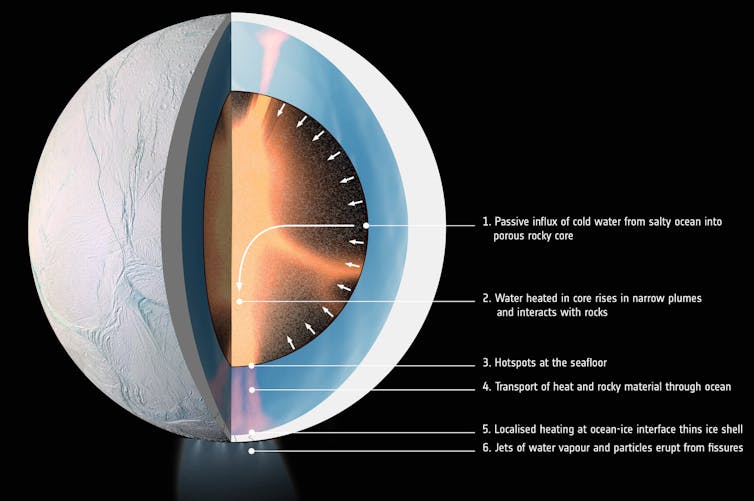
Detecting potential life
As of now, nobody has ever detected life beyond Earth. But scientists agree that Enceladus is a very promising place to look for life. So, how do we go about looking?
In a paper published in March 2024, my colleagues and I conducted a laboratory test that simulated whether dust analyzer instruments on spacecraft could detect and identify traces of life in the emitted ice grains.
To simulate the detection of ice grains as dust analyzers in space record them, we used a laboratory setup on Earth. Using this setup, we injected a tiny water beam that contained bacterial cells into a vacuum, where the beam disintegrated into droplets. Each droplet contained, in theory, one bacterial cell.
Then, we shot a laser at the individual droplets, which created charged ions from the water and the cell compounds. We measured the charged ions using a technique called mass spectrometry . These measurements helped us predict what dust analyzer instruments on a spacecraft should find if they encountered a bacterial cell contained in an ice grain.
We found these instruments would do a good job identifying cellular material. Instruments designed to analyze single ice grains should be able to identify bacterial cells, even if there is only 0.01% of the constituents of a single cell in an ice grain from an Enceladus-like geyser.
The analyzers could pick up a number of potential signatures from cellular material, including amino acids and fatty acids. Detected amino acids represent either fragments of the cell’s proteins or metabolites, which are small molecules participating in chemical reactions within the cell. Fatty acids are fragments of lipids that make up the cell’s membranes.
In our experiments, we used a bacteria named Sphingopyxis alaskensis . Cells of this culture are extremely tiny – the same size as cells that might be able to fit into ice grains emitted from Enceladus. In addition to their small size, these cells like cold environments, and they need only a few nutrients to survive and grow, similar to how life adapted to the conditions in Enceladus’ ocean would probably be.
The specific dust analyzer on Cassini didn’t have the analytical capabilities to identify cellular material in the ice grains. However, scientists are already designing instruments with much greater capabilities for potential future Enceladus missions. Our experimental results will inform the planning and design of these instruments.
Future missions
Enceladus is one of the main targets for future missions from NASA and the European Space Agency. In 2022, NASA announced that a mission to Enceladus had the second-highest priority as they picked their next big missions – a Uranus mission had the highest priority.
The European agency recently announced that Enceladus is the top target for its next big mission. This mission would likely include a highly capable dust analyzer for ice grain analysis.
Enceladus isn’t the only moon with a liquid water ocean. Jupiter’s moon Europa also has an ocean that spans the entire moon underneath its icy crust. Ice grains on Europa float up above the surface, and some scientists think Europa may even have geysers like Enceladus that shoot grains into space . Our research will also help study ice grains from Europa.
NASA’s Europa Clipper mission will visit Europa in the coming years. Clipper is scheduled to launch in October 2024 and arrive at Jupiter in April 2030. One of the two mass spectrometers on the spacecraft, the SUrface Dust Analyzer , is designed for single ice grain analysis.

Our study demonstrates that this instrument will be able to find even tiny fractions of a bacterial cell, if present in only a few emitted ice grains.
With these space agencies’ near-future plans and the results of our study, the prospects of upcoming space missions visiting Enceladus or Europa are incredibly exciting. We now know that with current and future instrumentation, scientists should be able to find out whether there is life on any of these moons.
- Astrobiology
- Extraterrestrial life
- Planetary science
- Search for life
Want to write?
Write an article and join a growing community of more than 182,300 academics and researchers from 4,941 institutions.
Register now
Targeting vulnerability in B-cell development leads to novel drug combination for leukemia
By characterizing B-cells’ developmental stages, scientists at St. Jude Children’s Research Hospital designed and tested a drug combination to effectively treat resistant B-cell leukemia.
Memphis, Tennessee, April 8, 2024
Senior co-corresponding author Jun J. Yang, PhD, St. Jude Department of Pharmacy and Pharmaceutical Sciences vice-chair and co-corresponding author Jiyang Yu, PhD, St. Jude Department of Computational Biology interim chair.
Despite having an overall survival rate of 94%, B-cell acute lymphoblastic leukemia (B-ALL), the most common childhood cancer, can prove challenging to treat, with survival among relapsed or resistant cases falling between 30-50%. Recent work by St. Jude Children’s Research Hospital scientists discovered which tumor cells resist treatment and why. This enabled the rational design of a combination therapy that better controlled high-risk subtypes of B-ALL in mouse models. The findings were published today in Cancer Cell .
“We found a new explanation of B-ALL sensitivity to asparaginase, which is one of the most commonly used drugs for this disease,” said senior co-corresponding author Jun J. Yang , PhD, St. Jude Department of Pharmacy and Pharmaceutical Sciences vice-chair. “Although asparaginase has been around for almost 50 years, the way we use this drug for ALL remains imprecise. This is partly because we still do not fully understand the mechanism by which it kills leukemia cells.”
Scientists showed combining the classic drug asparaginase (a chemotherapy) with a newer drug, venetoclax (a BCL-2 targeted therapy), was most effective at treating B-ALL in laboratory models. The combination reduced the number of leukemia cells more than either drug alone and worked faster. The improved effects were consistent across three different high-risk subtypes of this cancer.
“This discovery was enabled by single-cell systems biology analysis of B cell development and integration with B-ALL drug sensitivity profiling and bulk RNA-sequencing data,” said co-corresponding author Jiyang Yu , PhD, St. Jude Department of Computational Biology interim chair. “Our single-cell network analysis revealed the protein BCL-2 as a hidden vulnerability in the asparaginase-resistant tumor developmental stage.”
“Administering asparaginase alongside venetoclax may lower the risk of ALL relapse, the major reason for treatment failure,” said co-author Ching-Hon Pui , MD, St. Jude Department of Oncology Fahad Nassar Al-Rashid Endowed Chair of Leukemia Research. “Ideally, we aim for venetoclax to potentiate the anti-leukemia properties of asparaginase while keeping its toxicity levels in check. These concepts warrant further investigation in future clinical trials.”
Venetoclax is already Food and Drug Administration–approved for use in other pediatric cancers, making it an attractive candidate. The drug has proven safe in those settings, paving the way for future approval in B-ALL treatment. The largest hurdle was understanding how venetoclax works with asparaginase to stop B-cell leukemia.
B-cell development stage is a challenge and vulnerability in B-ALL
B-ALL is a cancer derived from white blood cells called B cells. Under normal circumstances, B cells develop from immature to fully mature, passing through eight steps. In cancers, cells can get stuck in an intermediate stage of development. In a related disease, T-cell acute lymphoblastic leukemia, Yang and Yu previously found, as reported in Nature Cancer 2021, that the developmental stage where T cells get stuck determines their sensitivity to therapeutics . The researchers wanted to understand what made cells in a specific stage respond to which drug, hoping that such understanding would present new therapeutic opportunities.
“In this case, we found tumor B cells are stuck in two major stages,” Yu said. “One is an earlier stage that is more resistant to asparaginase and another later stage that is more sensitive to it.”
Yu looked at gene expression data from hundreds of thousands of individual cancerous B cells to understand what was different about them. After identifying the two dominant B-cell development stages of B-ALL, pre-pro-B (early) and pro-B (late), his lab looked for the genes upregulated in the resistant early cells to identify potential vulnerabilities to target therapeutically.
“The protein BCL-2 caught our attention, as it seems to be a driver of asparaginase-resistance in leukemia cells with pre-pro-B features,” Yu said.
B cell lymphoma protein 2 (BCL-2) is a protein involved in cell death. Cancer cells use it to evade the systems that normally cause them to self-destruct. The protein is also downstream of mTOR, the protein targeted by asparaginase. Findings showed that BCL-2 was activated in cancer cells resistant to that drug. That resistance relationship motivated the scientists to try venetoclax, which targets the protein BCL-2, in a combination approach.
“When you add asparaginase, you hit mTOR signaling,” Yang said. “In turn, that upregulates the BCL-2 activity, making the cells more sensitive to venetoclax.”
The work also has implications for other cancers because incorrect development underlies many forms of the disease. Single-cell gene sequencing and analysis may provide similar opportunities to improve therapies in those contexts.
“We showed that developmental arrest of cancer cells can make them sensitive to certain drugs,” Yang said. “Once we determine the pathways involved, we can find new drug combinations to improve treatment outcomes.”
Authors and funding
The study’s co-first authors are Xin Huang and Yizhen Li, of St. Jude, and Jingliao Zhang, formerly of St. Jude and now of the Chinese Academy of Medical Sciences & Peking Union Medical College. The study’s other authors are Xiaofan Zhu and Yingchi Zhang, Chinese Academy of Medical Sciences & Peking Union Medical College; Mark Litzow, Mayo Clinic; Wendy Stock, University of Chicago; Nitin Jain, Elias Jabbour and Steven Kornblau, The University of Texas MD Anderson Cancer Center; Marina Konopleva and Elisabeth Paietta, Albert Einstein College of Medicine; Lei Yan, Huanbin Zhao, Liang Ding, Sheetal Bhatara, Xu Yang, Satoshi Yoshimura, Wenjian Yang, Seth Karol, Hiroto Inaba, Charles Mullighan, Ching-Hon Pui and William Evans, St. Jude .
The study was supported by grants from the National Institutes of Health (R01GM134382, U01CA264610, R35GM141947, R01CA264837, U10CA180820, UG1CA189859 and UG1CA232760), Department of Defense (W81XWH-20-1-0567), St. Baldrick’s Foundation, the Lynch family and ALSAC, the fundraising and awareness organization of St. Jude .
St. Jude Children's Research Hospital
St. Jude Children's Research Hospital is leading the way the world understands, treats and cures childhood cancer, sickle cell disease, and other life-threatening disorders. It is the only National Cancer Institute-designated Comprehensive Cancer Center devoted solely to children. Treatments developed at St. Jude have helped push the overall childhood cancer survival rate from 20% to 80% since the hospital opened more than 60 years ago. St. Jude shares the breakthroughs it makes to help doctors and researchers at local hospitals and cancer centers around the world improve the quality of treatment and care for even more children. To learn more, visit stjude.org , read St. Jude Progress, a digital magazine , and follow St. Jude on social media at @stjuderesearch .
Numbers, Facts and Trends Shaping Your World
Read our research on:
Full Topic List
Regions & Countries
- Publications
- Our Methods
- Short Reads
- Tools & Resources
Read Our Research On:
What we know about unauthorized immigrants living in the U.S.
The unauthorized immigrant population in the United States reached 10.5 million in 2021, according to new Pew Research Center estimates. That was a modest increase over 2019 but nearly identical to 2017.
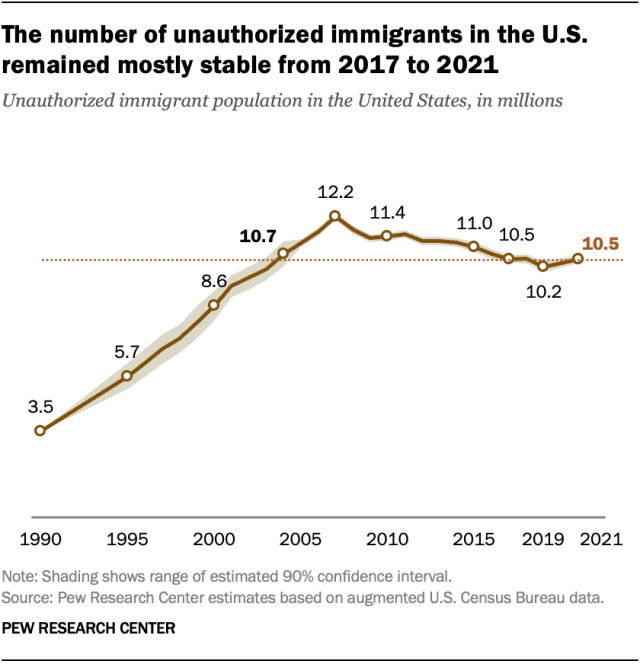
The number of unauthorized immigrants living in the U.S. in 2021 remained below its peak of 12.2 million in 2007. It was about the same size as in 2004 and lower than every year from 2005 to 2015.
The new estimates do not reflect changes that have occurred since apprehensions and expulsions of migrants along the U.S.-Mexico border started increasing in March 2021 . Migrant encounters at the border have since reached historic highs .
Pew Research Center undertook this research to understand ongoing changes in the size and characteristics of the unauthorized immigrant population in the United States. The Center has published estimates of the U.S. unauthorized immigrant population for more than two decades. The estimates presented in this research are the Center’s latest, adding new and updated annual estimates for 2017 through 2021.
Center estimates of the unauthorized immigrant population use a “residual method.” It is similar to methods used by the U.S. Department of Homeland Security’s Office of Immigration Statistics and nongovernmental organizations, including the Center for Migration Studies and the Migration Policy Institute . Those organizations’ estimates are generally consistent with ours. Our estimates also align with official U.S. data sources, including birth records, school enrollment figures and tax data, as well as Mexican censuses and surveys.
Our “residual” method for estimating the nation’s unauthorized immigrant population includes these steps:
- Estimate the total number of immigrants living in the country in a particular year using data from U.S. censuses and government surveys such as the American Community Survey and the Current Population Survey.
- Estimate the number of immigrants living in the U.S. legally using official counts of immigrant and refugee admissions together with other demographic data (for example, death and out-migration rates).
- Subtract our estimate of lawful immigrants from our estimate of the total immigrant population . This provides an initial estimate of the unauthorized immigrant population .
Our final estimate of the U.S. unauthorized immigrant population, as well as estimates for lawful immigrants, includes an upward adjustment. We do this because censuses and surveys tend to miss some people . Undercounts for immigrants, especially unauthorized immigrants, tend to be higher than for other groups. (Our 1990 estimate comes from work by Robert Warren and John Robert Warren; details can be found here .)
The term “unauthorized immigrant” reflects standard and customary usage by many academic researchers and policy analysts. The U.S. Department of Homeland Security’s Office of Immigration Statistics also generally uses it. The term means the same thing as undocumented immigrants, illegal immigrants and illegal aliens.
For more details on how we produced our estimates, read the Methodology section of our November 2018 report on unauthorized immigrants.
The unauthorized immigrant population includes any immigrants not in the following groups:
- Immigrants admitted for lawful residence (i.e., green card admissions)
- People admitted formally as refugees
- People granted asylum
- Former unauthorized immigrants granted legal residence under the 1985 Immigration Reform and Control Act
- Immigrants admitted under any of categories 1-4 who have become naturalized U.S. citizens
- Individuals admitted as lawful temporary residents under specific visa categories
Read the Methodology section of our November 2018 report on unauthorized immigrants for more details.
Pew Research Center’s estimate of unauthorized immigrants includes more than 2 million immigrants who have temporary permission to be in the United States. (Some also have permission to work in the country.) These immigrants account for about 20% of our national estimate of 10.5 million unauthorized immigrants for 2021.
Although these immigrants have permission to be in the country, they could be subject to deportation if government policy changes. Other organizations and the federal government also include these immigrants in their estimates of the U.S. unauthorized immigrant population.
Immigrants can receive temporary permission to be in the U.S. through the following ways:
Temporary Protected Status (TPS)
In 2021, there were about 500,000 unauthorized immigrants with Temporary Protected Status . This status provides protection from removal or deportation to individuals who cannot safely return to their country because of civil unrest, violence or natural disaster.
Deferred Enforced Departure (DED) is a similar program that grants protection from removal. The number of immigrants with DED is much smaller than the number with TPS.
Deferred Action for Childhood Arrivals (DACA)
Deferred Action for Childhood Arrivals is a program that offers protection from deportation to individuals who were brought to the U.S. as children before June 15, 2007. As of the end of 2021, there were slightly more than 600,000 DACA beneficiaries , largely immigrants from Mexico.
Asylum applicants
Individuals who have applied for asylum but are awaiting a ruling are not legal residents yet but cannot be deported. There are two types of asylum claims, defensive and affirmative .
Defensive asylum applications are generally filed by individuals facing deportation or removal from the U.S. These are processed by the Department of Justice’s Executive Office for Immigration Review. At the end of 2021, there were almost 600,000 applications pending.
Affirmative asylum claims are made by individuals already in the U.S. who are not in the process of being deported or removed. These claims are handled by the U.S. Department of Homeland Security’s Citizenship and Immigration Services (USCIS). At the end of 2021, more than 400,000 applications for affirmative asylum were pending, some covering more than one applicant.
Here are key findings about how the U.S. unauthorized immigrant population changed from 2017 to 2021:
- The most common country of birth for unauthorized immigrants is Mexico. However, the population of unauthorized immigrants from Mexico dropped by 900,000 from 2017 to 2021 , to 4.1 million.
- There were increases in unauthorized immigrants from nearly every other region of the world – Central America, the Caribbean, South America, Asia, Europe and sub-Saharan Africa.
- Among U.S. states, only Florida and Washington saw increases to their unauthorized immigrant populations , while California and Nevada saw decreases. In all other states, unauthorized immigrant populations were unchanged.
- 4.6% of U.S. workers in 2021 were unauthorized immigrants , virtually identical to the share in 2017.
Trends in the U.S. immigrant population
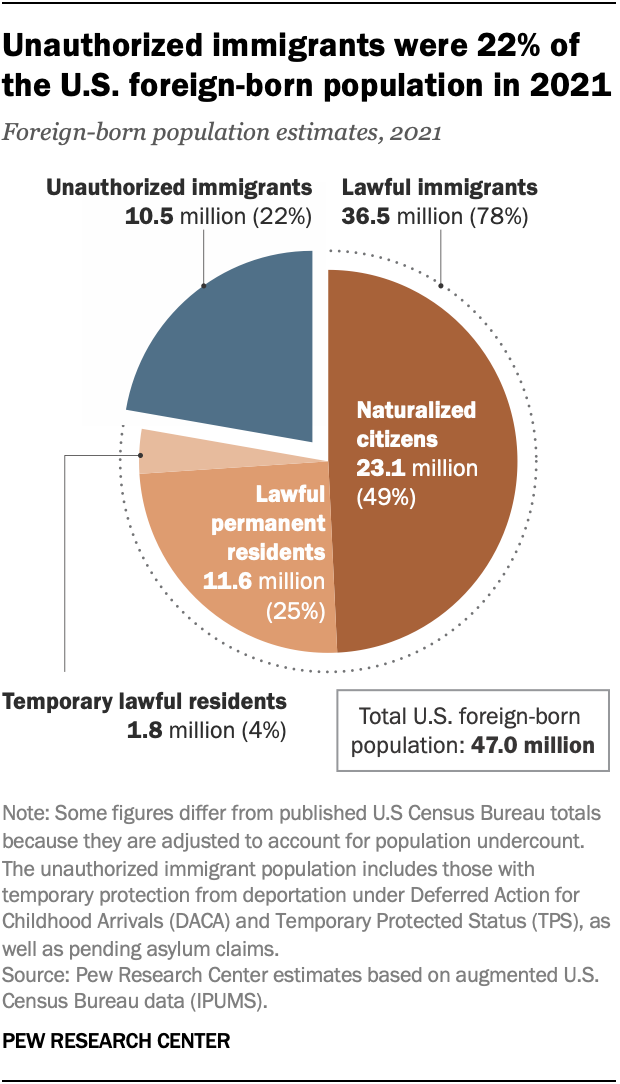
The U.S. foreign-born population was 14.1% of the nation’s population in 2021. That was very slightly higher than in the last five years but below the record high of 14.8% in 1890.
As of 2021, the nation’s 10.5 million unauthorized immigrants represented about 3% of the total U.S. population and 22% of the foreign-born population. These shares were among the lowest since the 1990s.
Between 2007 and 2021, the unauthorized immigrant population decreased by 1.75 million, or 14%.
Meanwhile, the lawful immigrant population grew by more than 8 million, a 29% increase, and the number of naturalized U.S. citizens grew by 49%. In 2021, naturalized citizens accounted for about half (49%) of all immigrants in the country.
Where unauthorized immigrants come from
Unauthorized immigrants living in the U.S. come from many parts of the world, with Mexico being the most common origin country.
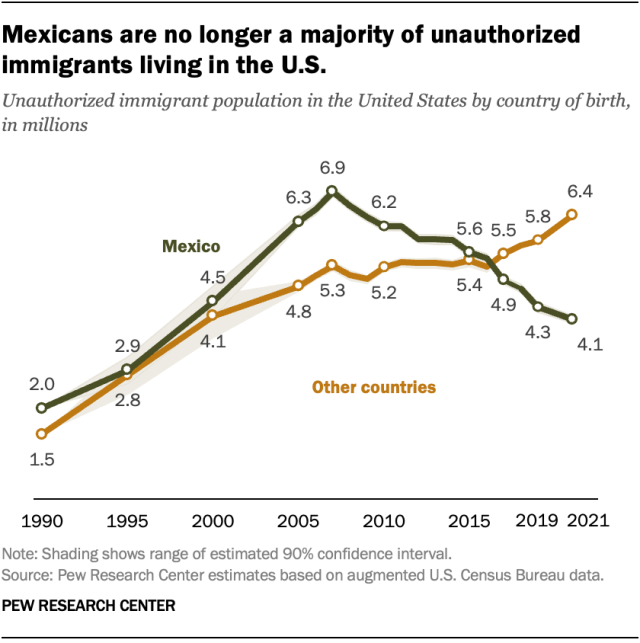
The origin countries for unauthorized immigrants have changed since the population peaked in 2007, before the Great Recession slowed immigration. Here are some highlights of those changes:
The number of unauthorized immigrants from Mexico living in the U.S. (4.1 million in 2021) was the lowest since the 1990s. Mexico accounted for 39% of the nation’s unauthorized immigrants in 2021, by far the smallest share on record .
The decrease in unauthorized immigrants from Mexico reflects several factors:
- A broader decline in migration from Mexico to the U.S.
- Mexican immigrants to the U.S. continuing to return to Mexico
- Expanded opportunities for lawful immigration from Mexico and other countries, especially for temporary agricultural workers.
The rest of the world
The total number of unauthorized immigrants in the U.S. from countries other than Mexico has grown rapidly. In 2021, this population was 6.4 million, up by 900,000 from 2017.
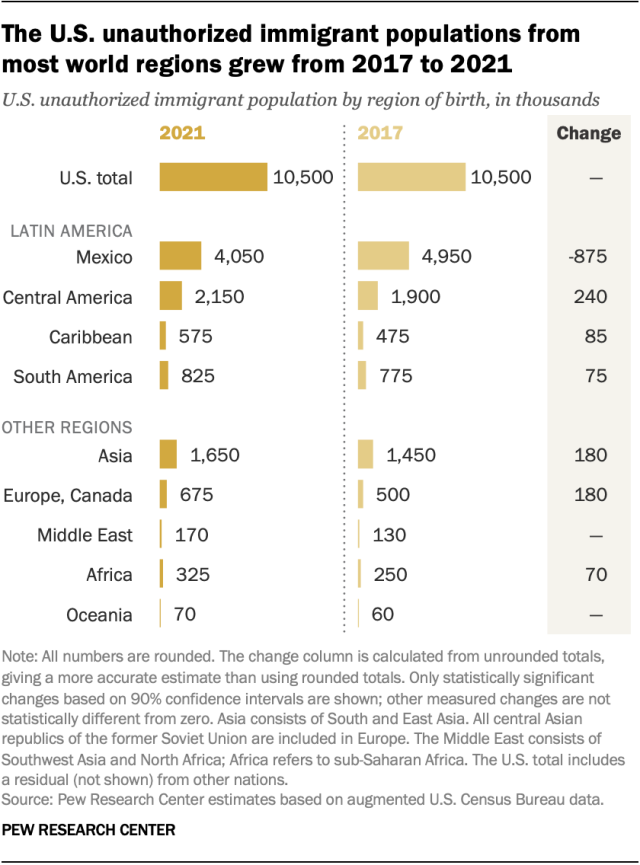
Almost every region in the world had a notable increase in the number of unauthorized immigrants in the U.S. from 2007 to 2021. The largest increases were from Central America (240,000) and South and East Asia (180,000).
After Mexico, the countries of origin with the largest unauthorized immigrant populations in the U.S. in 2021 were:
- El Salvador (800,000)
- India (725,000)
- Guatemala (700,000)
- Honduras (525,000)
India, Guatemala and Honduras all saw increases from 2017.
The Northern Triangle
Three Central American countries – El Salvador, Honduras and Guatemala – together represented 2.0 million unauthorized immigrants in the U.S. in 2021, or almost 20% of the total. The unauthorized immigrant population from the Northern Triangle grew by about 250,000 from 2017 and about 700,000 from 2007.
Other origin countries
Venezuela was the country of birth for 190,000 U.S. unauthorized immigrants in 2021. This population saw particularly fast growth, from 130,000 in 2017 and 55,000 in 2007.
Among countries with the largest numbers of U.S. unauthorized immigrants, India, Brazil, Canada and former Soviet Union countries all experienced growth from 2017 to 2021.
Some origin countries with significant unauthorized immigrant populations showed no change, notably China (375,000) and the Dominican Republic (230,000).
Detailed table: Unauthorized immigrant population by region and selected country of birth (and margins of error), 1990-2021 (Excel)
U.S. states of residence of unauthorized immigrants
The unauthorized immigrant population in most U.S. states stayed steady from 2017 to 2021. However, four states saw significant changes:
- Florida (+80,000)
- Washington (+60,000)
- California (-150,000)
- Nevada (-25,000)
States with the most unauthorized immigrants
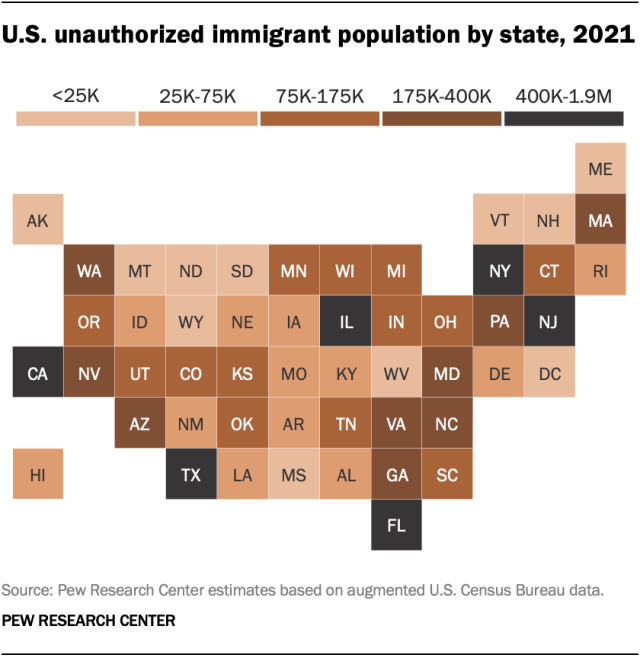
The six states with the largest unauthorized immigrant populations in 2021 were:
- California (1.9 million)
- Texas (1.6 million)
- Florida (900,000)
- New York (600,000)
- New Jersey (450,000)
- Illinois (400,000)
These states have consistently had the most unauthorized immigrants since 1990 and earlier .
At the same time, the unauthorized immigrant population has become less geographically concentrated. In 2021, these six states were home to 56% of the nation’s unauthorized immigrants, down from 80% in 1990.
Detailed table: Unauthorized immigrant population for states (and margins of error), 1990-2021 (Excel)
Detailed table: Unauthorized immigrants and characteristics for states, 2021 (Excel)
Unauthorized immigrants in the labor force
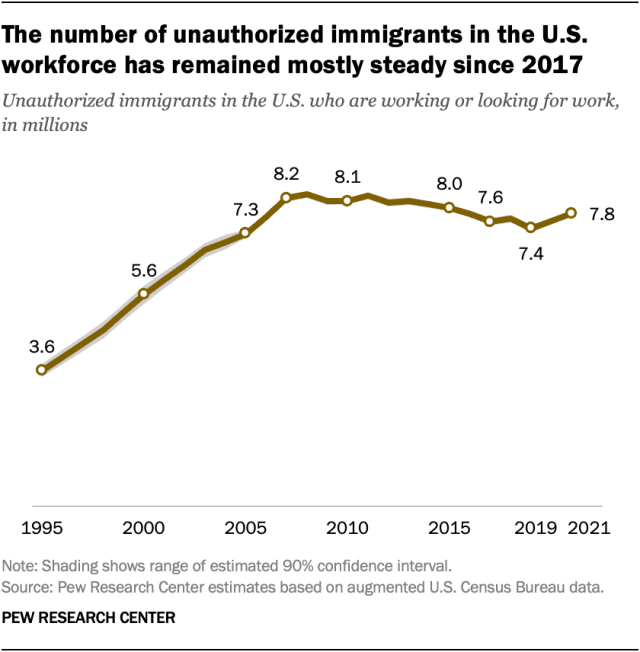
The share of unauthorized immigrants in the U.S. workforce was slightly less than 5% in 2021, compared with 3% of the total U.S. population.
Demographics help explain the difference: The unauthorized immigrant population includes relatively few children or elderly adults, groups that tend not to be in the labor force.
Overall, about 7.8 million unauthorized immigrants were in the U.S. labor force in 2021. That was up slightly from 2019 but smaller than every year from 2007 through 2015.
Detailed table: Unauthorized immigrants in the labor force for states, 2021 (Excel)
Here are some additional findings about unauthorized immigrants as a share of the workforce nationwide and in certain states:
- Since 2003, unauthorized immigrants have made up 4.4% to 5.4% of all U.S. workers, a relatively narrow range.
- Fewer than 1% of workers in Maine, Montana, Vermont and West Virginia in 2021 were unauthorized immigrants.
- Nevada (9%) and Texas (8%) had the highest shares of unauthorized immigrants in the workforce.
- Immigrant Populations
- Immigration Issues
- Unauthorized Immigration

Key facts about Asian Americans living in poverty
Latinos’ views on the migrant situation at the u.s.-mexico border, key facts about the nation’s 47.9 million black americans, key facts about the wealth of immigrant households during the covid-19 pandemic, 8 facts about recent latino immigrants to the u.s., most popular.
1615 L St. NW, Suite 800 Washington, DC 20036 USA (+1) 202-419-4300 | Main (+1) 202-857-8562 | Fax (+1) 202-419-4372 | Media Inquiries
Research Topics
- Age & Generations
- Coronavirus (COVID-19)
- Economy & Work
- Family & Relationships
- Gender & LGBTQ
- Immigration & Migration
- International Affairs
- Internet & Technology
- Methodological Research
- News Habits & Media
- Non-U.S. Governments
- Other Topics
- Politics & Policy
- Race & Ethnicity
- Email Newsletters
ABOUT PEW RESEARCH CENTER Pew Research Center is a nonpartisan fact tank that informs the public about the issues, attitudes and trends shaping the world. It conducts public opinion polling, demographic research, media content analysis and other empirical social science research. Pew Research Center does not take policy positions. It is a subsidiary of The Pew Charitable Trusts .
Copyright 2024 Pew Research Center
Terms & Conditions
Privacy Policy
Cookie Settings
Reprints, Permissions & Use Policy
Covering the business and politics of space
BlueHalo wins $24 million Air Force contract for research and analysis of satellite vulnerabilities

- Click to share on X (Opens in new window)
- Click to share on Facebook (Opens in new window)
- Click to share on LinkedIn (Opens in new window)
- Click to share on Reddit (Opens in new window)
- Click to email a link to a friend (Opens in new window)
- Click to share on Clipboard (Opens in new window)

Join our newsletter to get the latest military space news every Tuesday by veteran defense journalist Sandra Erwin.
By clicking submit, you agree to share your email address with the site owner to receive the newsletters. You can opt-out at any time.
WASHINGTON — The Air Force Research Laboratory awarded BlueHalo a $24.4 million contract to support the lab’s Satellite Assessment Center, an organization that models and analyzes the vulnerabilities of space systems.
BlueHalo , a defense contractor based in Arlington, Virginia, specializes in space, directed energy and autonomous systems technologies. The five-year contract was awarded by AFRL’s Directed Energy Directorate.
AFRL’s Satellite Assessment Center, located at Kirtland Air Force Base, New Mexico, evaluates the vulnerabilities of space vehicles to lasers and laser radiation.
The center tests laser effects on spacecraft components and materials and uses the data to build high-fidelity computer models used for predictive analysis and research.
The Satellite Assessment Center also develops tools that simulate sensor networks that track objects in space.
Directed-energy modeling
According to the April 19 contract announcement, BlueHalo will be tasked to “accelerate the advancement of the directed energy modeling, simulation and analysis, assessment expertise, and highly technical capabilities to safeguard strategic U.S. space interests.”
The contract also includes work on predictive analysis, satellite modeling, resiliency research and innovative testing environments to “assess natural and man-made directed energy effects on space systems.”
Sandra Erwin
Sandra Erwin writes about military space programs, policy, technology and the industry that supports this sector. She has covered the military, the Pentagon, Congress and the defense industry for nearly two decades as editor of NDIA’s National Defense... More by Sandra Erwin

Sign up for a SpaceNews newsletter
Get top stories, military space news and more delivered to your inbox.
What We Learned Inside a North Korean Internet Server: How Well Do You Know Your Partners?
- By: Martyn Williams
- April 22, 2024
- Foreign Affairs

A Month of Animation
The story begins in late 2023 with the discovery of a cloud storage server on a North Korean Internet Protocol (IP) address. The server, which appears no longer in use, had been incorrectly configured, making the daily flow of files into and out of this server viewable by anyone without a password.
North Korea employs such servers because the average IT worker inside the country does not have direct access to the Internet. Typically, an organization might have just one or two computers with Internet access; workers need approval to use them and are monitored while they do so.
The cloud server in question was discovered by Nick Roy, who runs the NK Internet blog . Together, throughout January this year, we observed files. Each day, a new batch of files would appear that included instructions for animation work and the results of that day’s work.
The identity of the person or persons uploading the files could not be determined.
Often the files contained editing comments and instructions in Chinese, presumably written by the production company, along with a translation of those instructions into Korean. This suggests a go-between was responsible for relaying information between the production companies and the animators.
For example, in the communication below, the animator is being asked to improve the shape of the character’s head.

The identity of the North Korean partner was never revealed in any of the documentation observed, but it is likely the April 26 Animation Studio, also known as SEK Studio. The Pyongyang-based organization is North Korea’s premier animation house, producing series for domestic television broadcasts, including the popular “Squirrel and Hedgehog” series.
It has previously worked on several international projects, including some with South Korean companies during the “Sunshine Policy” era in the early 2000s.
However, in 2016, the studio was sanctioned by the US Department of Treasury as a North Korean state-owned enterprise. The US government has twice laid additional sanctions on Chinese companies that have worked with the studio or acted as a go-between, once in 2021 and again in 2022 .

Accessing the Server
Together with researchers from Mandiant, a computer security company owned by Google, access logs for the server were also examined.
They revealed several logins from Internet addresses associated with virtual private network (VPN) services, but among those that were not VPN-related was an IP address in Spain and three in China. Two of the Chinese addresses were registered to Liaoning Province, which neighbors North Korea and includes the towns of Dandong, Dalian and Shenyang.
All three cities are known to have many North Korean-operated businesses and are main centers for North Korea’s IT workers who live overseas.
Projects Identified
The files related to a range of projects, suggesting several animators were likely involved in the work.
Over the month we observed this traffic, the apparent identity of some of the projects became clear. They included:
- Season 3 of “ Invincible ,” an Amazon Original animated series produced by California-based Skybound Entertainment. A document on the server carried the name of the series and “Viltruminte Pants LLC,” which appears to be part of the Skybound group.
- “ Iyanu, Child of Wonder ,” an anime about a superhero created by Maryland-based YouNeek Studios and being produced and animated by Lion Forge Entertainment for airing in 2024 on HBO Max.
- “ Dahliya In Bloom ” (魔導具師ダリヤはうつむかない), a Japanese anime series scheduled to air from July 2024.
- Files named “猫” (Cat) that also carry the name of Ekachi Epilka , an animation studio in Hokkaido, Japan ( Figure 1 ).
- Video files that appear to be from “ Octonauts ,” a BBC children’s cartoon. The files had no additional identifying information and appeared to be completed, so it is possible these were not worked on by the animators.
- An unidentified animation series with documents that refer to Dalian’s Shepherd Boy Animation (大连牧童动漫).

There is no evidence to suggest that the companies identified in the images had any knowledge that a part of their project had been subcontracted to North Korean animators. In fact, as the editing comments on all the files, including those related to US-based animations, were written in Chinese, it is likely that the contracting arrangement was several steps downstream from the major producers.
There were also several animation files that were never identified, files with video special effects editing instructions for what appeared to be a Chinese movie about basketball, and multiple Russian-language video files and PDFs related to the upkeep and care of horses.
The fact that the server was largely used to store files related to animation suggests that additional relay servers probably exist for North Korean organizations doing other work, such as software development.

Implications: Due Diligence Needed on IT Outsourcing
In mid-2022, the US government warned companies about the possibility of inadvertently hiring North Korean IT workers, including animators, when looking for remote contractors. An advisory warned that doing so could put the companies at risk of a breach of US and United Nations sanctions.
It noted North Korean workers frequently “misrepresent themselves as foreign (non-North Korean) or US-based teleworkers” and might use VPNs or other methods to make it appear as if they are from and residing in another country.
In response, it recommended that companies institute a number of safeguards such as better verification of work documents, video interviews, background checks and fingerprint login to ensure the workers hired are identified and remain the ones carrying out the work on the project.
Such checks are designed to ensure that the worker you hire is the one who does the work and not just a proxy for someone else.
Last year, US law enforcement agencies disclosed a case in which North Korean workers had paid someone in the US $400 per month to host four laptops on their Internet connection. The workers would access the laptops through remote desktop software and then get on to the American Internet. Analysis of the IP address would make it appear to be coming from a conventional US domestic service provider.
The case caused the US to update its guidance for spotting North Korean IT workers.
However, the ability of the North Korean studio to apparently continue working on international projects highlights the difficulty in enforcing current US sanctions in such a global industry. It also highlights the need for US animation companies to be much better informed about all the companies that are involved in their projects.
Related Articles
Call for applications: 38 north emerging scholars fellowship program, after russia’s veto: the future of the sanctions regime against north korea.
- Events (DC Area)
- All News & Analysis (Approx Weekly)
- Only Urgent Breaking News (Occasional)

IMAGES
VIDEO
COMMENTS
Grounded Theory. Definition: Grounded Theory is a qualitative research methodology that aims to generate theories based on data that are grounded in the empirical reality of the research context. The method involves a systematic process of data collection, coding, categorization, and analysis to identify patterns and relationships in the data.
Grounded theory is a well-known methodology employed in many research studies. Qualitative and quantitative data generation techniques can be used in a grounded theory study. Grounded theory sets out to discover or construct theory from data, systematically obtained and analysed using comparative analysis.
Research teams use grounded theory to analyze social processes and relationships. Because of the important role of data, there are key stages like data collection and data analysis that need to happen in order for the resulting data to be useful. The grounded research results are compared to strengthen the validity of the findings to arrive at ...
Grounded theory is a systematic methodology that has been largely applied to qualitative research conducted by social scientists.The methodology involves the construction of hypotheses and theories through the collecting and analysis of data. Grounded theory involves the application of inductive reasoning.The methodology contrasts with the hypothetico-deductive model used in traditional ...
The aim of all research is to advance, refine and expand a body of knowledge, establish facts and/or reach new conclusions using systematic inquiry and disciplined methods. 1 The research design is the plan or strategy researchers use to answer the research question, which is underpinned by philosophy, methodology and methods. 2 Birks 3 defines philosophy as 'a view of the world encompassing ...
Abstract. Since being developed as a research methodology in the 1960s, grounded theory (GT) has grown in popularity. In spite of its prevalence, considerable confusion surrounds GT, particularly in respect of the essential methods that characterize this approach to research. Misinformation is evident in the literature around issues such as the ...
Grounded theory, as a research methodology, consists of several core components that guide the research process, from data collection to the development of a final theoretical framework. These components are interrelated, each influencing and shaping the others in a dynamic, iterative process. The core components of grounded theory include ...
The grounded approach of any research would require the reporting of a lengthy presentation of qualitative data and analysis, and a constant comparison between the different emerging categories long before the reader would have the opportunity to learn about the theoretical context of the research and its potential contributions.
Grounded theory is a qualitative research methodology that involves developing theories directly from the data collected during the research process instead of relying on pre-existing theories or hypotheses. This approach aims to generate insights and understanding about a particular phenomenon by systematically analyzing and coding the data to ...
Since Barney Glaser and Anselm Strauss' (The discovery of grounded theory: strategies for qualitative research. New York: Adline De Gruyter, 1967) publication of their groundbreaking book, The Discovery of Grounded Theory, grounded theory methodology (GTM) has been an integral part of health social science.GTM allows for the systematic collection and analysis of qualitative data to ...
Grounded theory research, especially when conducted with the constant comparative method of data analysis, is "a labor-intensive task that requires the researcher to invest time in the processes of analysis and data collection" (Kolb, 2012).
Research design is the SAGE Methodspace focus for the first quarter of 2023. Selecting the methodology is an essential piece of research design. Grounded theory is one option, a methodology used for both qualitative and quantitative research. What is grounded theory? The SAGE Handbook of Grounded Theory describes it as:
The grounded theory provides the methodology needed to better understand these unknowns' ever-changing complexities. Other key advantages of properly executing a grounded theory method of research include the ability to: In short, grounded theory is pivotal for connecting data to behavior and processes.
Abstract. The term "grounded theory" was introduced to the research lexicon by Barney Glaser and Anselm Strauss in the 1960s, particularly with the publication of The Discovery of Grounded Theory in 1967. The term itself is somewhat misleading since it actually refers to a method that facilitates the development of new theoretical insights—grounded theories.
An Overview of Grounded Theory in Qualitative Research. Published: Dec. 1, 2023. Using grounded theory, you can examine a specific process or phenomenon and develop new theories derived from the collected real-world data and their analysis. Grounded theory research is an inductive approach in which a theory is developed based on data.
Grounded theory is a systematic methodology in the social sciences emphasizing generation of theory from data in the process of conducting research. It is mainly used for qualitative research, but is also applicable to other data (e.g., quantitative data; Glaser, 1967, chapter VIII)
Introduction. Qualitative research is a cornerstone in cardiovascular research. It gives insights in why particular phenomena occur or what underlying mechanisms are. 1 Over the past 2 years, the European Journal of Cardiovascular Nursing published 20 qualitative studies. 2-21 These studies used methods such as content analysis, ethnography, or phenomenology.
Grounded theory (GT) is a research method concerned with the generation of theory,1 which is 'grounded' in data that has been systematically collected and analysed.2 It is used to uncover such things as social relationships and behaviours of groups, known as social processes.3 It was developed in California, USA by Glaser and Strauss during their study—'Awareness of Dying'.1 It is a ...
Grounded theory is a. systematic methodology involving the construction of 'concepts' through regular gathering and analysis of data (Charmaz, 2006). Grounded theory is sought to give an account of the meaning that actors give to actions, events and objects, which leads to the reasons for their behaviour. The main characteristic of grounded ...
Grounded Theory is an inductive methodology. Although many call Grounded Theory a qualitative method, it is not. It is a general method. It is the systematic generation of theory from systematic research. It is a set of rigorous research procedures leading to the emergence of conceptual categories. These concepts/categories are related to each ...
Grounded theory has become one of the most commonly used qualitative research methodologies (Birks & Mills, 2015; Bryant & Charmaz, 2007; Morse, 2009; Timmermans & Tavory, 2007).While it shares a number of characteristics with other qualitative approaches (e.g., coding, categorization, and inductive analysis), grounded theory is distinct as it aims to generate theory that is grounded in data.
Delve qualitative analysis tool is the best choice for grounded theory. Make your life easier while doing grounded theory by using grounded theory software like Delve. Codes and categories are constantly evolving during the grounded theory analysis process. Using pen and paper or spreadsheets to analyze qualitative data can get unwieldy and ...
Constant comparison is a tool often used by qualitative researchers using a grounded theory analysis approach in which they move back and forth between the data and the emerging categories and the evolving theoretical understanding they are developing. Chun Tie, Y., Birks, M., & Francis, K. (2019).
This methodology is known as grounded theory, wherein the themes that aim to address your research question emerge from the data via transcription and coding processes. To be a true example of ...
Our research will also help study ice grains from Europa. ... One of the two mass spectrometers on the spacecraft, the SUrface Dust Analyzer, is designed for single ice grain analysis.
St. Jude Children's Research Hospital. St. Jude Children's Research Hospital is leading the way the world understands, treats and cures childhood cancer, sickle cell disease, and other life-threatening disorders. It is the only National Cancer Institute-designated Comprehensive Cancer Center devoted solely to children. Treatments developed at St. Jude have helped push the overall childhood ...
This Pew Research Center analysis examines the changing number and rate of gun deaths in the United States. It is based primarily on data from the Centers for Disease Control and Prevention (CDC) and the Federal Bureau of Investigation (FBI). The CDC's statistics are based on information contained in official death certificates, while the FBI ...
ABOUT PEW RESEARCH CENTER Pew Research Center is a nonpartisan fact tank that informs the public about the issues, attitudes and trends shaping the world. It conducts public opinion polling, demographic research, media content analysis and other empirical social science research. Pew Research Center does not take policy positions.
WASHINGTON — The Air Force Research Laboratory awarded BlueHalo a $24.4 million contract to support the lab's Satellite Assessment Center, an organization that models and analyzes the ...
The workers would access the laptops through remote desktop software and then get on to the American Internet. Analysis of the IP address would make it appear to be coming from a conventional US domestic service provider. The case caused the US to update its guidance for spotting North Korean IT workers.